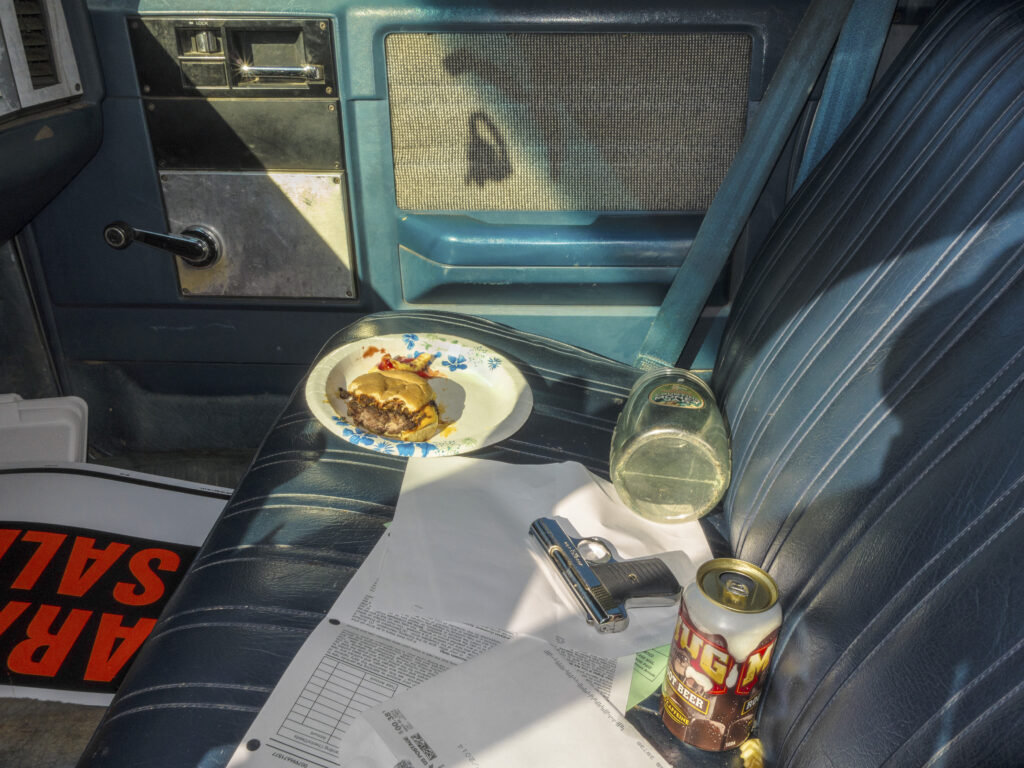
American Interiors
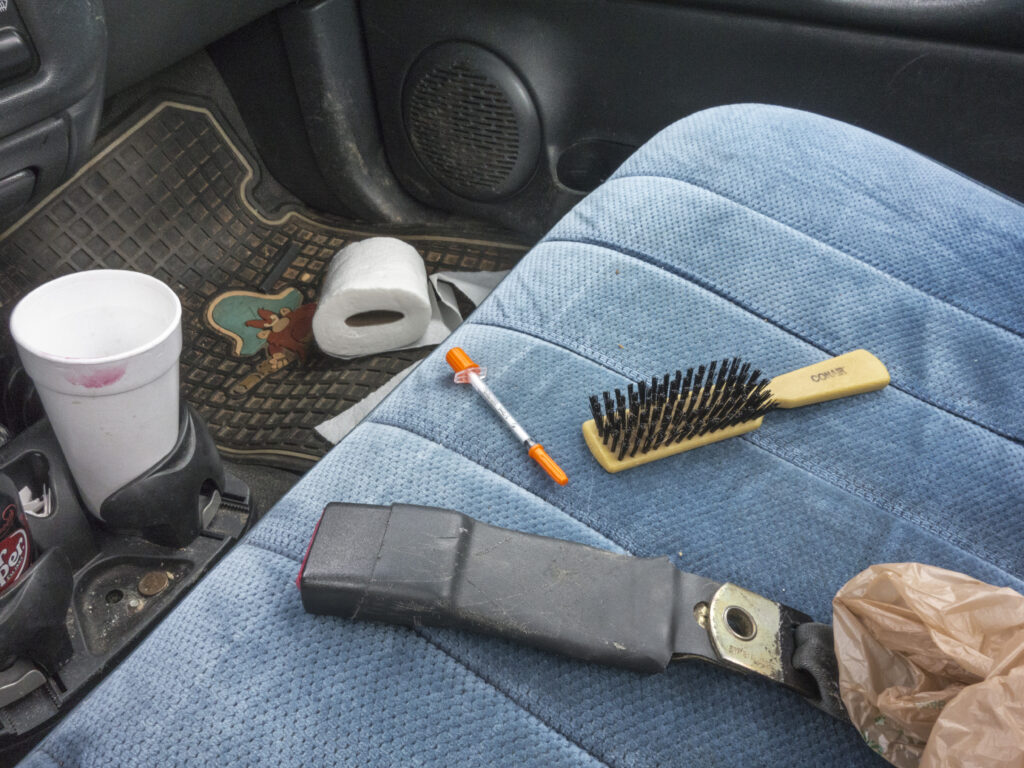


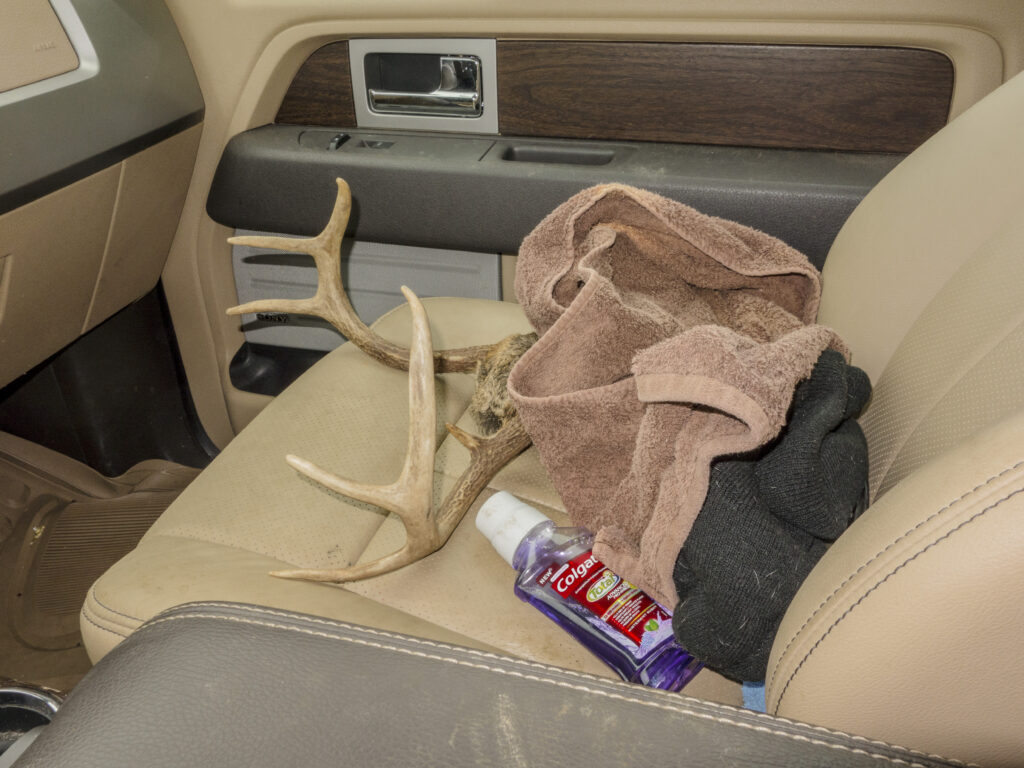
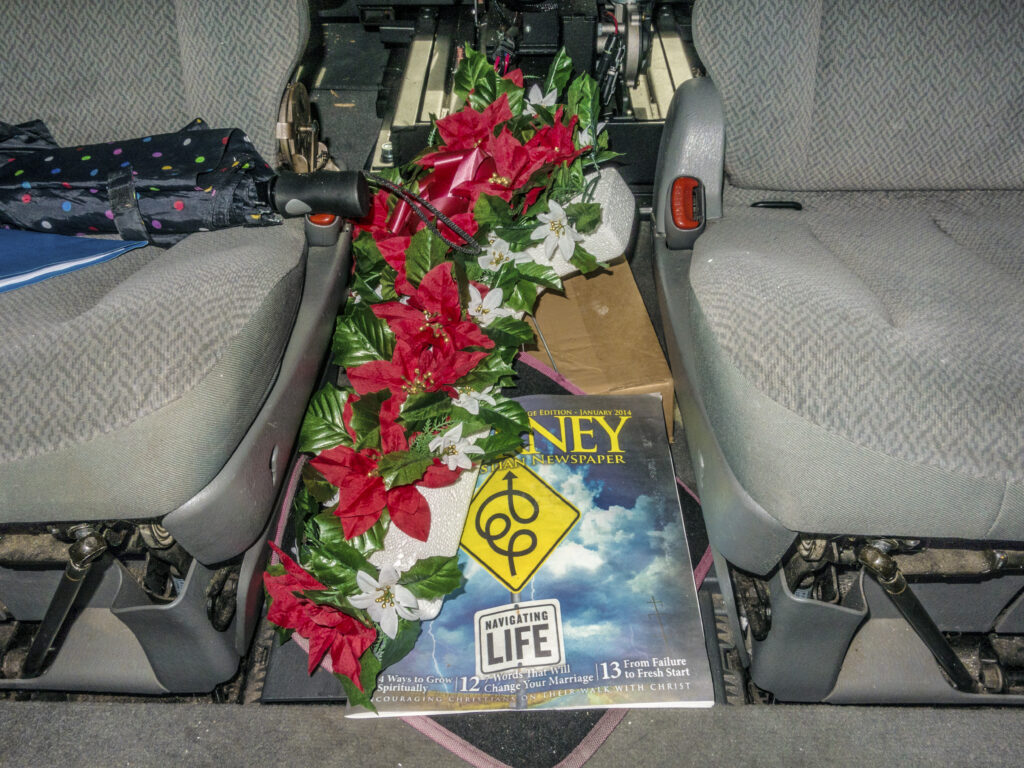


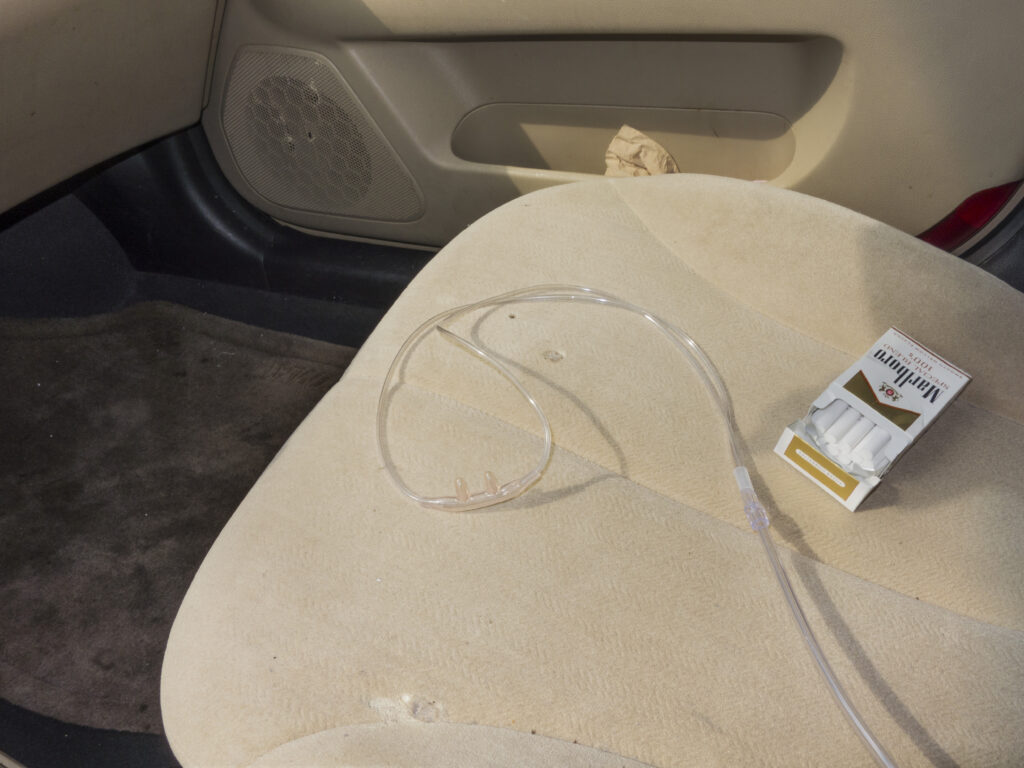

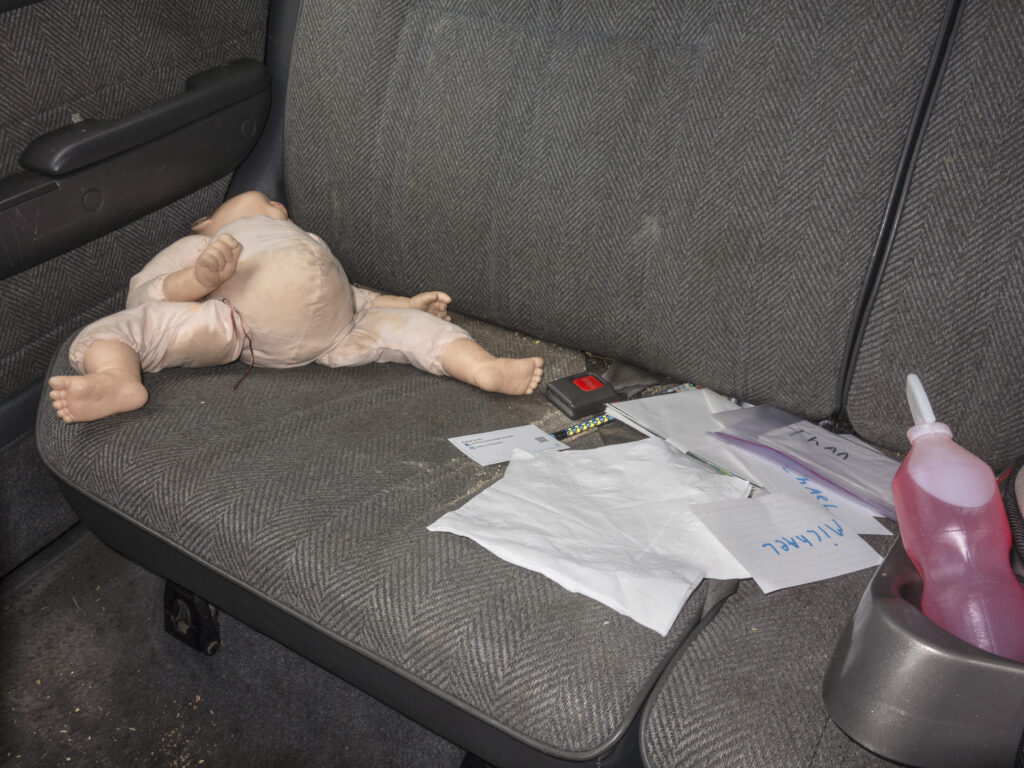
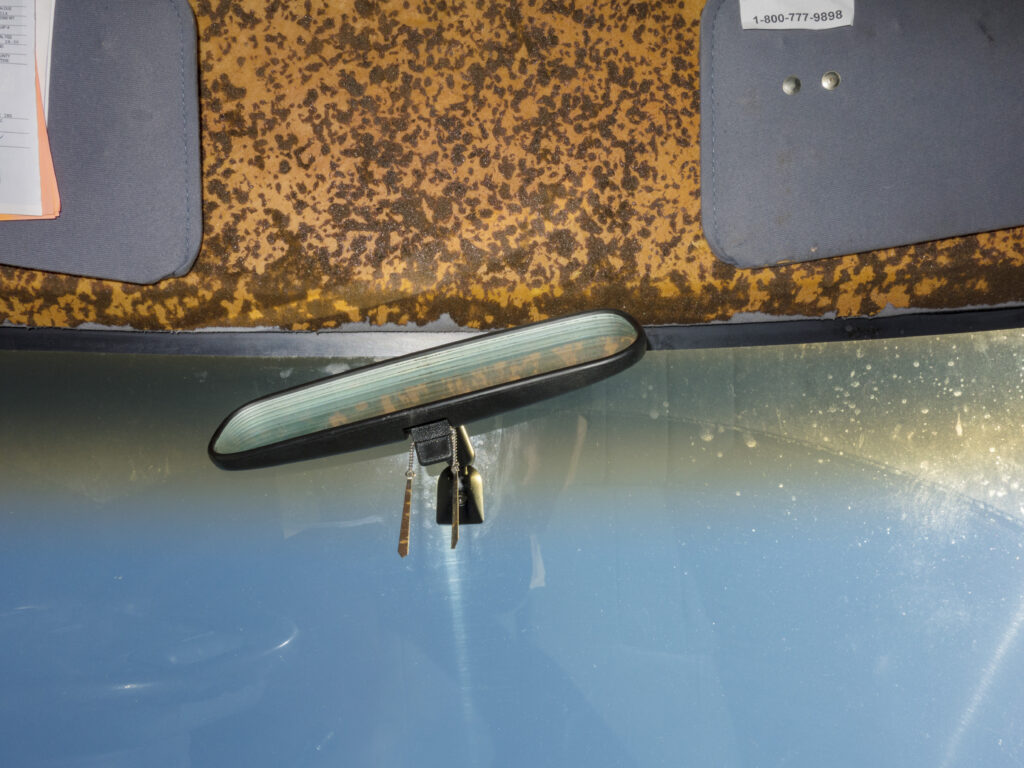
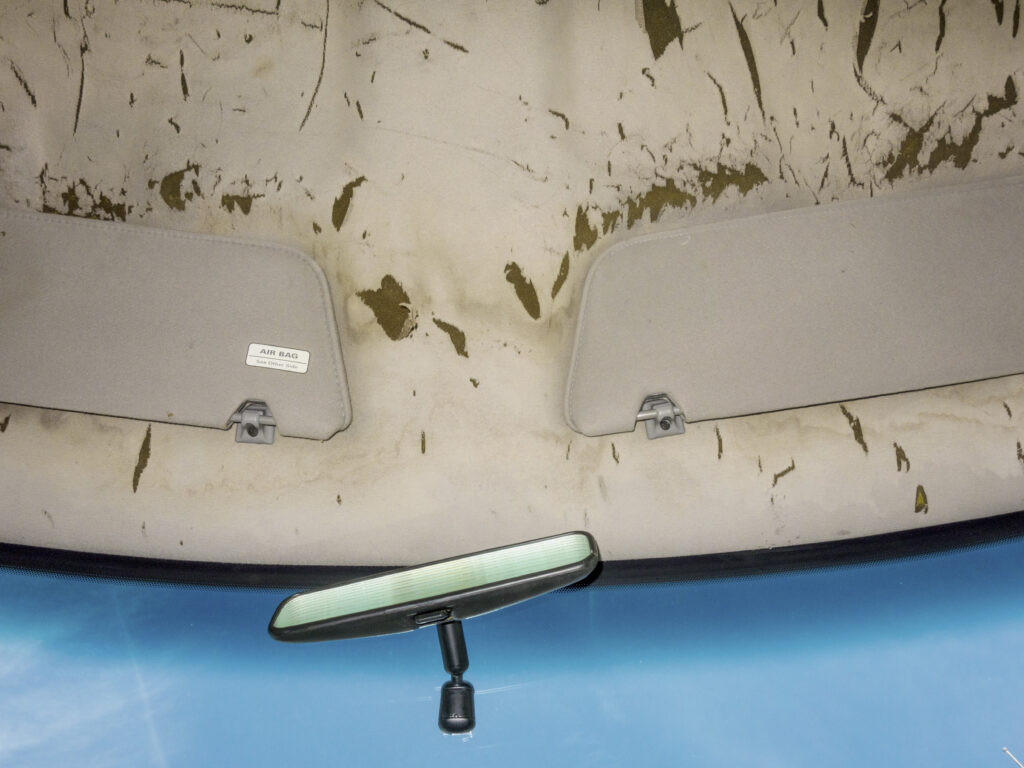
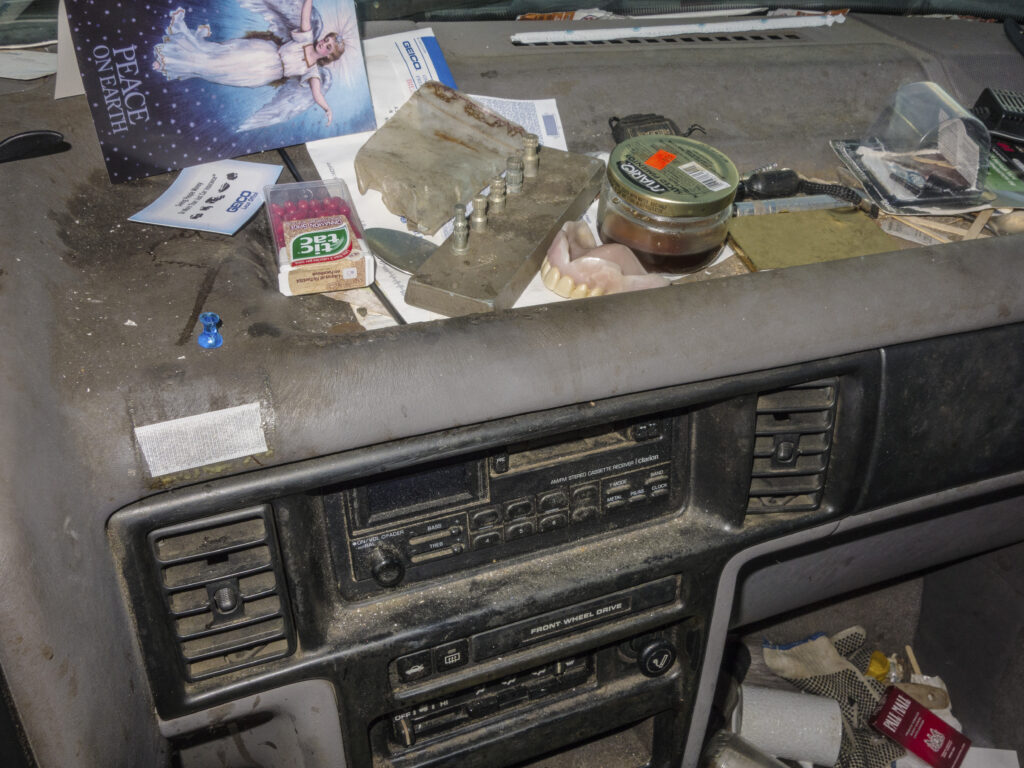
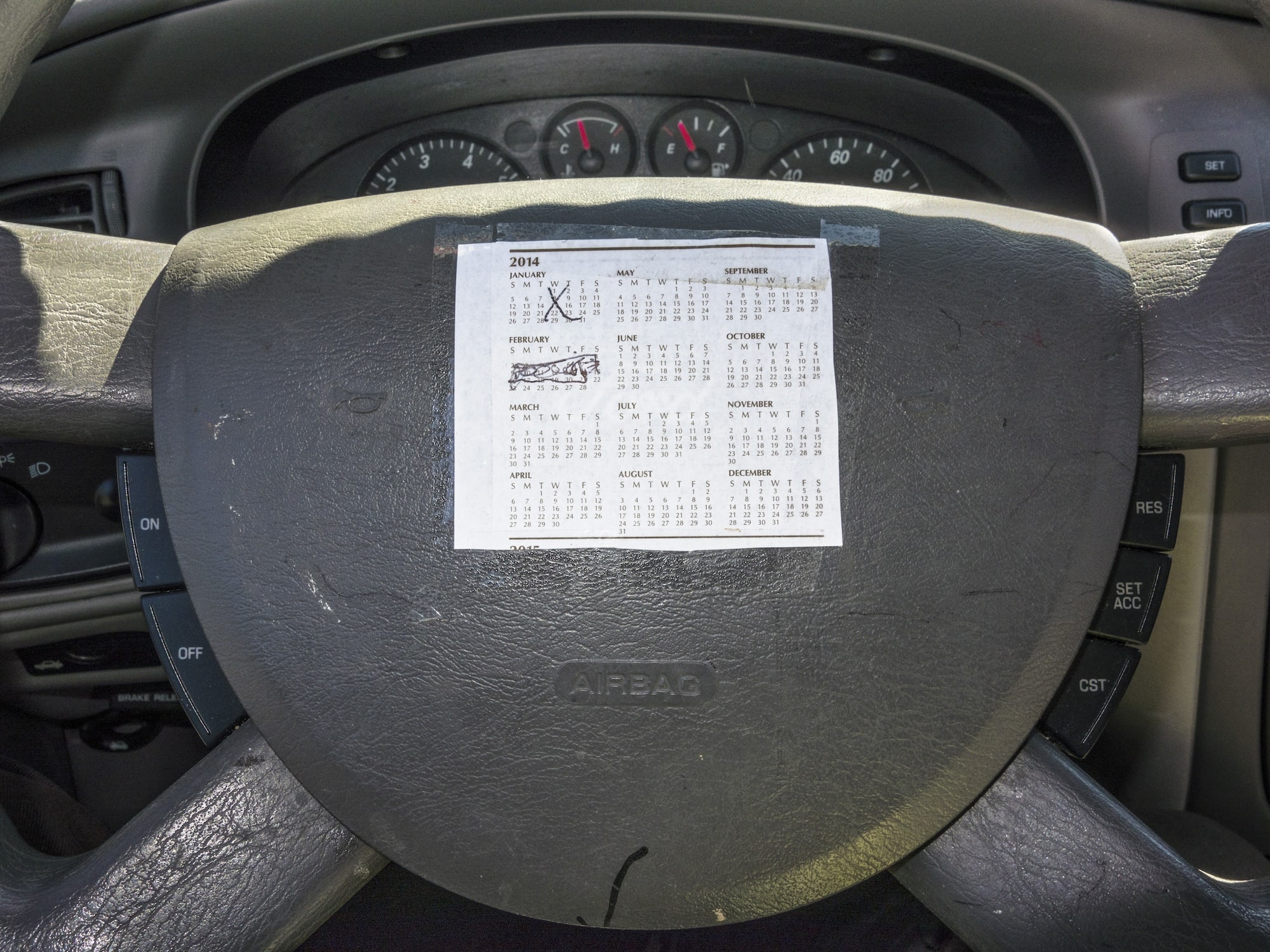














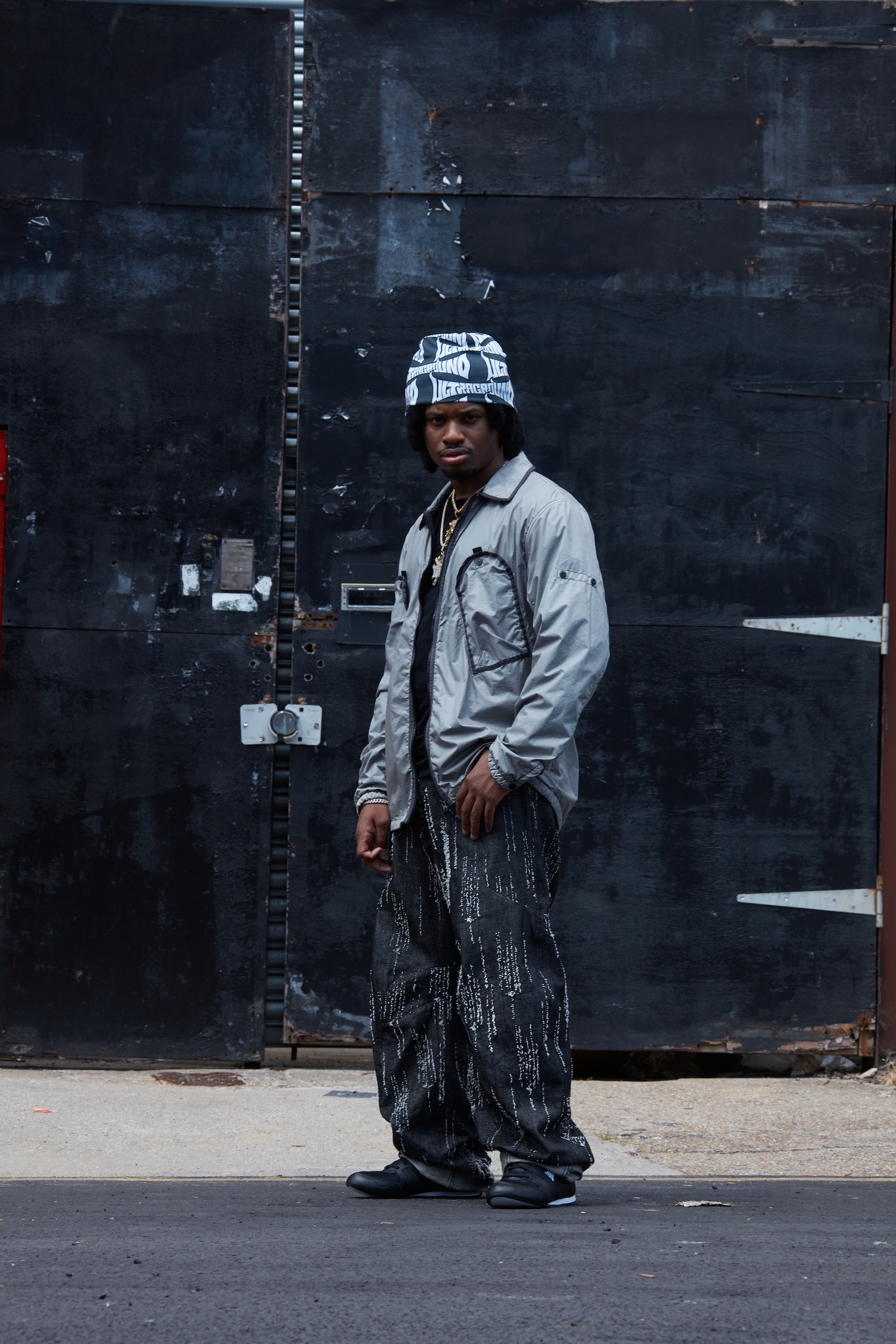
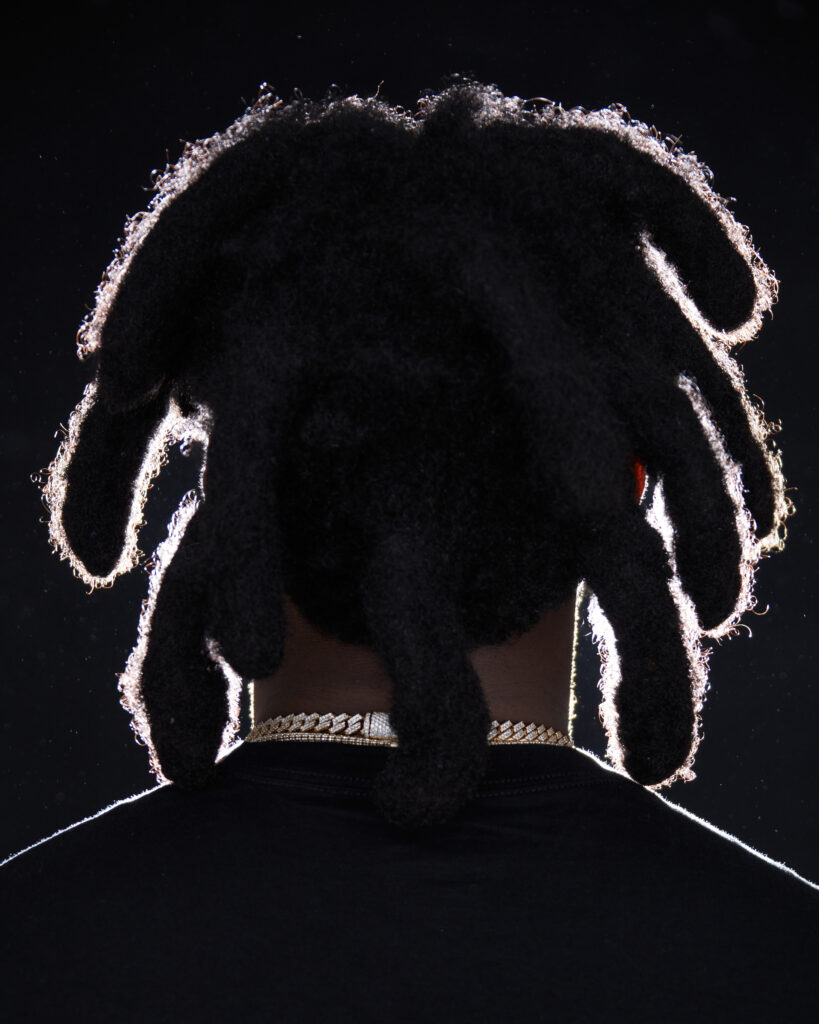
When some people hear the name “Denzel Curry,” they think of the explosive chorus of his high-octane hit “Ultimate.” Others may think of his viral music video for «Ricky»––which recreates the backyard brawls Curry attended in his hometown of Miami––or the fact that he toured with superstar Billie Eilish, who has proclaimed Curry to be one of her favorite artists. The rapid conclusion that can be drawn from his flashiest achievements––that Denzel Curry is a great rapper––pales in comparison to the one drawn by those who have dug deeper into his complete body of work. When you truly connect the dots of his career, you are confronted with a portrait of an artist who has made a truly massive contribution to the development of hip hop in the past decade.
Curry, who began writing rhymes as a child, was still in high school when he became a part of SpaceGhostPurrp’s infamous collective, Raider Klan (stylized RVIDXR KLVN), whose gritty sound, gothic aesthetic and hieroglyphic style of writing influenced an entire generation of rappers and headlining acts. Curry was also a member of the creative cosmos who helped establish both Soundcloud and South Florida as one of the most exciting breeding grounds of underground and experimental rap in the 2010s. He helped transform a digital platform into one of the most consequential genres of its time: Soundcloud rap.
On each new record, Curry reinvents himself. He evolved away from his original claim to fame, the aggressive, speed-rap of Imperial (2016) and into a more confessional and vulnerable terrain with Ta13oo (2018). Last year, he conquered boom-bap with Melt My Eyez and See Your Future––an album that revives the beats and politically minded rhymes of 90s hip hop. Even though Melt is his first record that actually sounds like Nas, De La Soul and Wu-Tang Klan, Curry’s high-level wordplay and amplification of social issues have long embodied the spirit and soul of «golden age» hip hop artists, who viewed their music as a means of political resistance. Critical issues like criminal justice reform, systemic racism and police brutality are deeply and tragically embedded in Curry’s life and creative output. Both his classmate, Trayvon Martin, and brother, Treon Johnson, were murdered by the police, in 2012 and 2014, respectively.
The art of the battle is a theme that connects Curry’s childhood with his greatest sources of inspiration: anime, video games and martial arts. Conflict is at the center of his musical oeuvre, which sheds a powerful light on the harrowing realities of being Black in America––and the internal dialogues of someone at war with both the world and themself. And despite his many accolades, Curry’s status in the music industry today is the byproduct of a constant fight to be seen, heard and respected. With his pen as his sword, Curry has proven himself time and time again to be a formidable match for any opponent. Denzel Curry is, above all else, a fighter worth betting on.

Cassidy George: I know that you’re really devoted to your Muay Thai practice. Is that how you started your day?
Denzel Curry: I can’t do Muay Thai today. I fucked my neck up yesterday doing calisthenics because I didn’t warm up. Now I have to chill.
Cassidy George: Is Muay Thai so embedded in your routine that not being able to practice makes you feel «off»?
Denzel Curry: Yea, plus I get fat really easily! Normally, I spent most of my time on the couch and eating. I still plan on getting sweaty today though––but at the sauna.
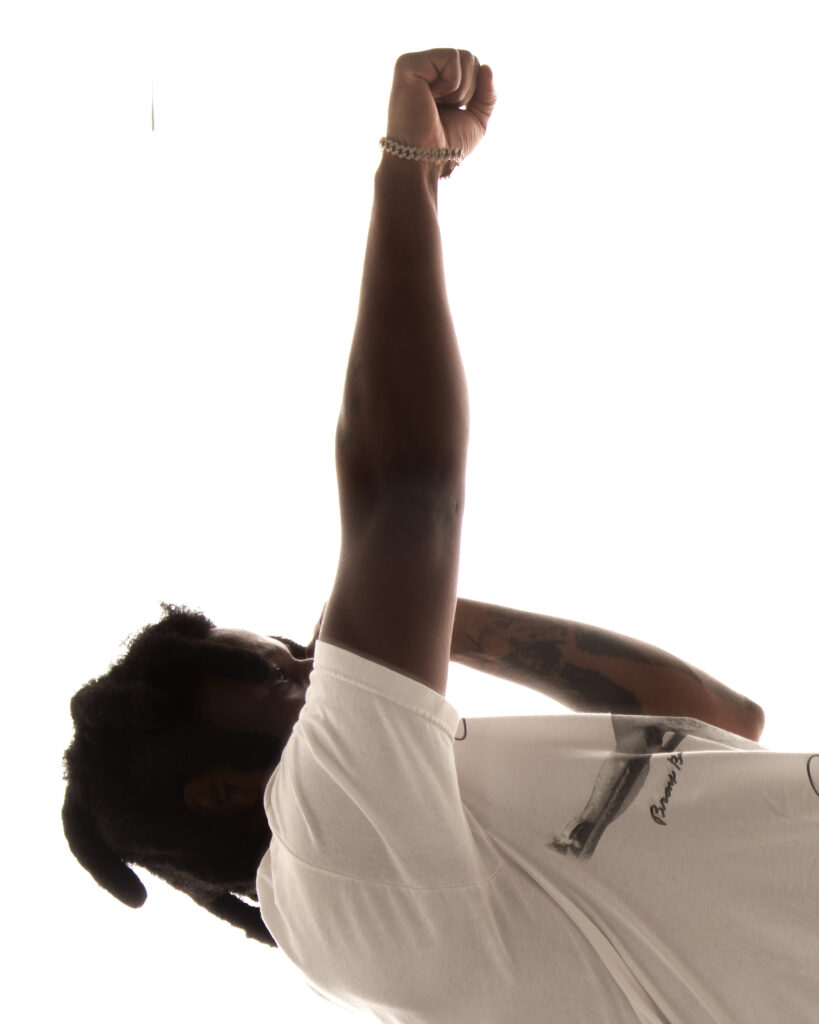
Cassidy George: Earlier this summer, you released a new single «Blood on my Nikez.» It’s a big shift in sound from your last album, Melt My Eyez and See Your Future. Is this the start of a new era for you?
Denzel Curry: This isn’t a new beginning, I just wanted to have fun with my music. Melt is my perfect project. It’s the best thing I’ve ever put out, but I don’t feel like it got the recognition or appreciation that it deserved. Everyone is just concerned with numbers and what goes up at shows. So many other artists, like Kenny Mason, also came out with impeccable projects last year. I feel like they were swept under the rug because they weren’t «popular.»

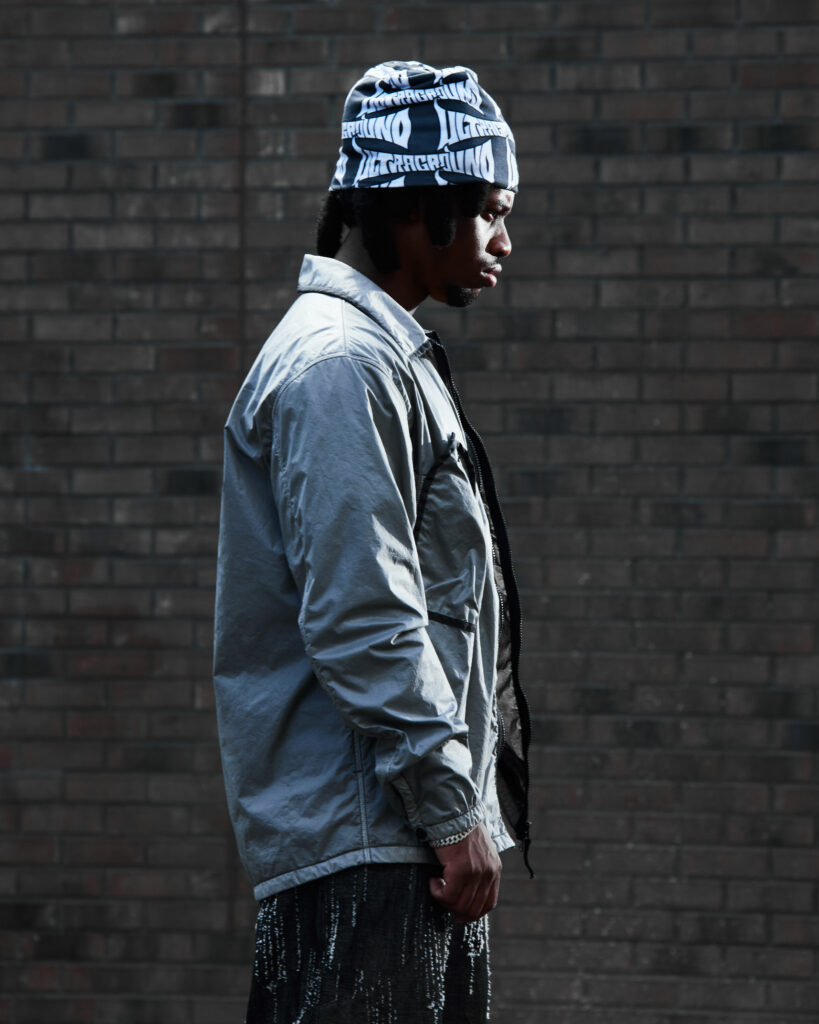
Cassidy George: Is that a difficult or intimidating place to be in, as an artist? What comes after a magnum opus?
Denzel Curry: I plan everything far in advance. When I was making Melt, I already knew what the next project would be. It may not come out now, next week or next year––but it will be released at some point. I just need to flesh it out a bit more. Until then, I’m just dropping shit that’s fun. Melt set a really high standard for me and I won’t release another album until it’s 100% ready.
Every track that I write, I write from my feelings. Back in the day, a lot of my feelings were just anger and sadness. When I came to LA and was making Ta13oo, for example, I was in a new environment and there was nothing around me. I experienced a little bit of depression. Making that album…it was very internal to external. I had so much more fun making Melt because the stuff I was talking about, like therapy, and just the soundscape I was going for––it took the burden off of my shoulders. Once it was well received by the public and critically acclaimed, people were like: «Wow, I didn’t know he had this in him!» The upside of that is that it caused a lot of new people to want to work with me because they saw a new side of me, beyond the «rah rah rah» of Ta13oo or Imperial.
People are so wishy-washy though! When new things come out that they like, they go back into the old stuff and are surprised that it’s good. Many people didn’t even listen to those records because they expected just one thing from me. That’s the narrative I’m trying to change.
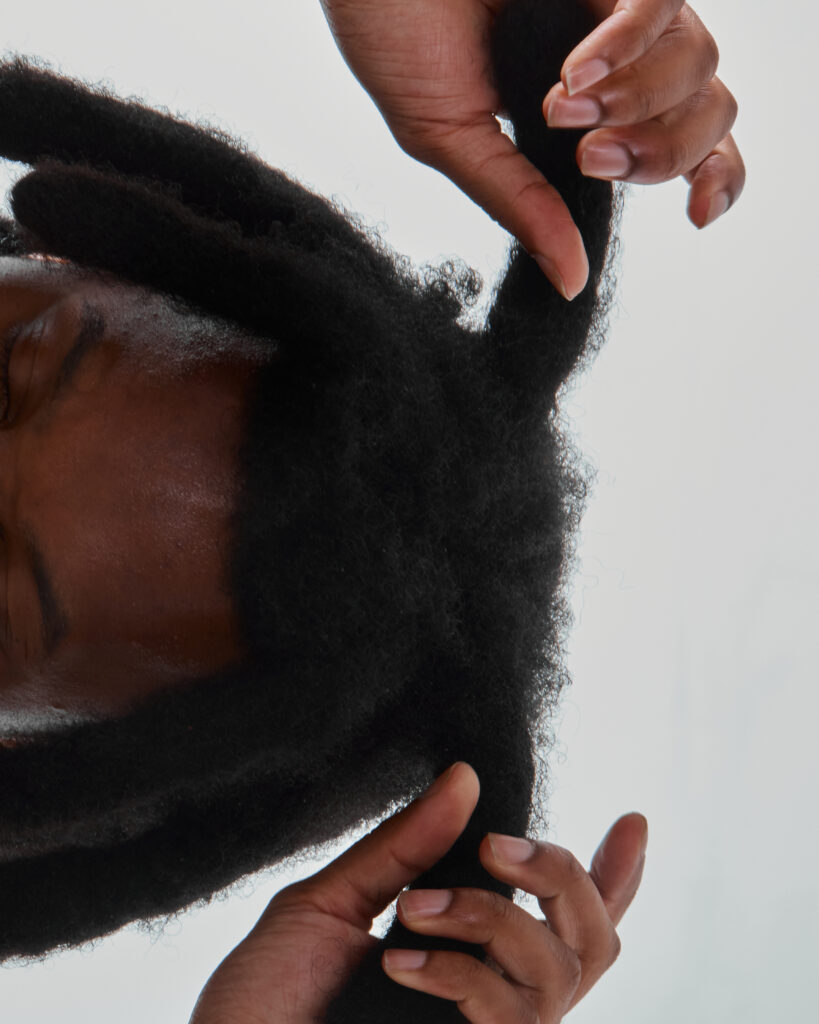
Cassidy George: What was the narrative, specifically? And what new narrative are you trying to construct?
Denzel Curry: That I was a one-trick pony and that I’m not versatile. I ended up proving on Ta13oo that I was hella versatile. My true fans know that in each project I do something different and that I always nail it. Of course, people will always choose not to listen––but that just comes down to preferences. I can’t let that kind of thing get to me…but I let it get to me. You know what I’m saying? I’m human. It is what it is.
Cassidy George: I think one of the greatest pleasures in life is proving people wrong.
Denzel Curry: That’s my greatest revenge! It’s the best thing I’ve ever done and the only reason I’m successful. I get good at so much shit just to spite whoever said I couldn’t do it and all of the people who said «stick to one thing!» I’m like, «Okay, see you next year!» I remember there was this guy back when I was getting into rap who would always ridicule me. I just never stopped rapping. One day «Threatz» blew up and this man hit me up again and said, “let me get on a track!” I was like, «ain’t you the one who said I couldn’t rap? You wanna be cool now? Fuck that!”
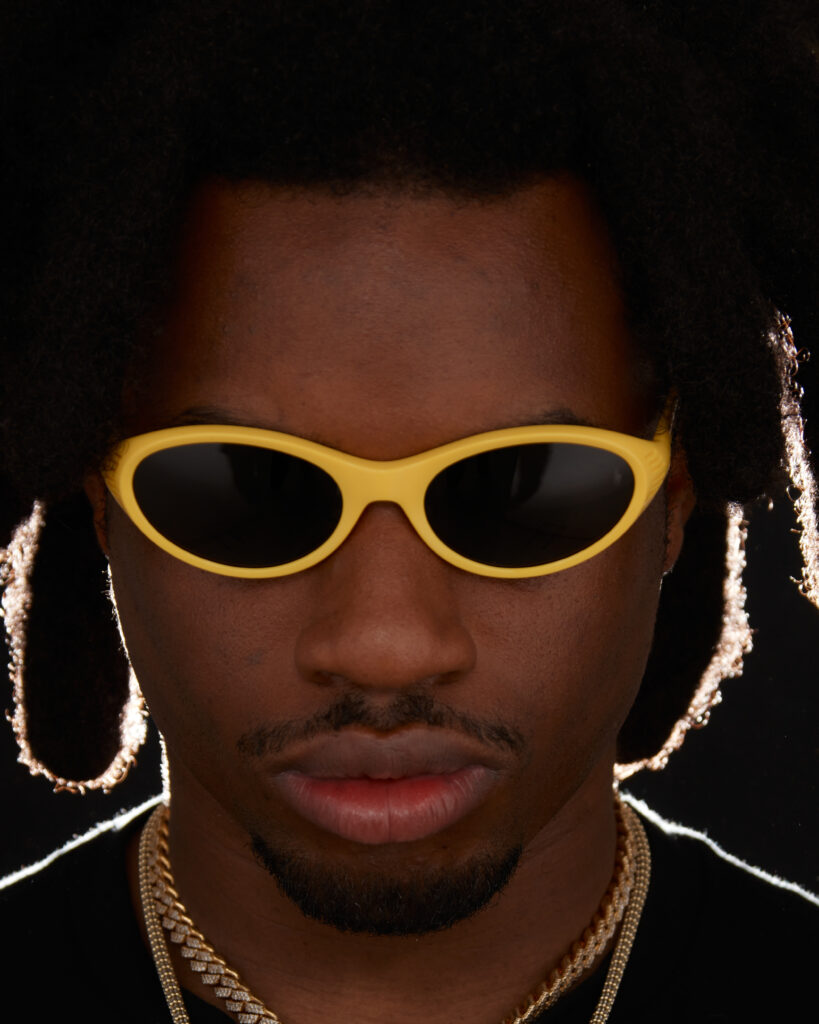
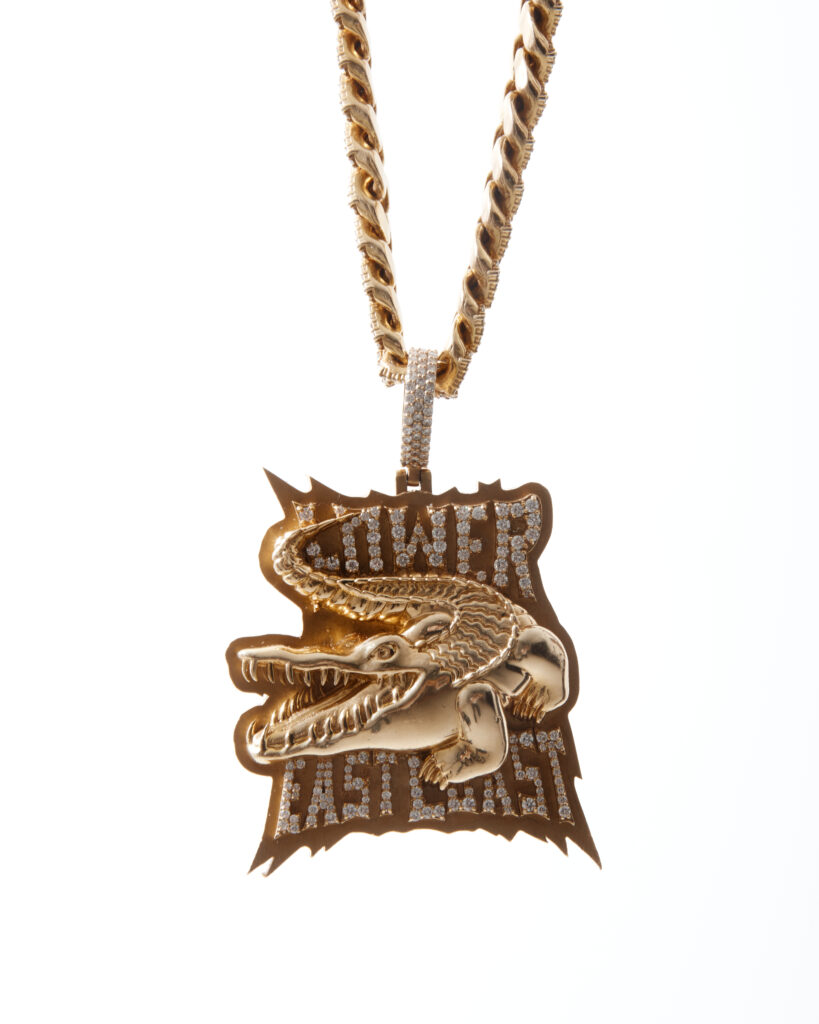
Cassidy George: Your parents supported your rapping from early on though, right? Who was it that didn’t believe in you?
Denzel Curry: Some people thought it wasn’t possible because they didn’t see it.
Cassidy George: By «it» do you mean your talent? Or potential?
Denzel Curry: Yea, but everybody sees it now because they can’t avoid it. People only see things when they’re unavoidable.
Cassidy George: When I heard Melt and saw your music videos for “Zatoichi” and “X-Wing,” I immediately thought of the Wu-Tang Klan. In many ways, you are continuing a long tradition of rap that is influenced by Asian culture. Any thoughts about why there is so much synergy between those two worlds?
Denzel Curry: Wu-Tang’s 36 Chambers and Raekwon’s Only Built 4 Cuban Linx… those albums were essential listening for me back in the day. As far as culture, I grew up watching Toonami. I also watch kung fu movies, but anime was what really did it for me.
Cassidy George: Battles are an ongoing theme in your history, your hobbies, your music and your message. On Melt, the battles you rap about are both internal and systemic. Who or what, if anything, are you battling right now?
Denzel Curry: The same thing that I’m battling now is the same thing I’ve battled since the day that I was born: my demons. I am always translating that into my music. I knew I had to take martial arts seriously because I needed to reach a level of fearlessness, where you can go up against anybody and be unshaken.
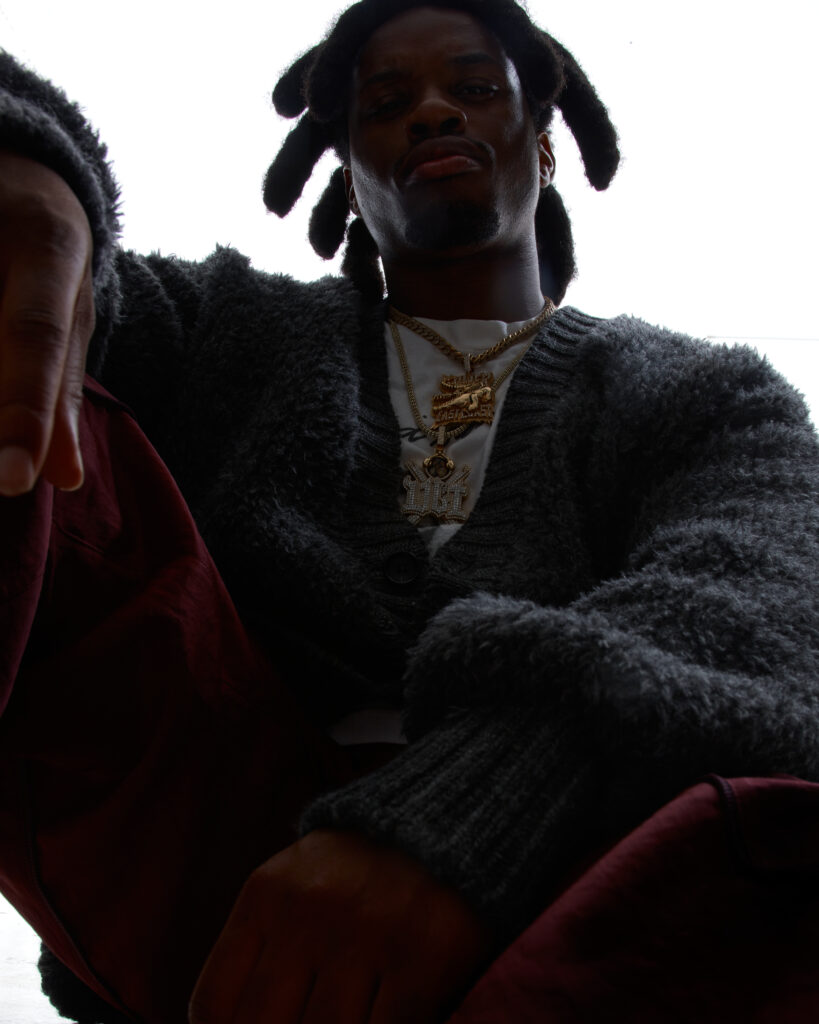
Cassidy George: Even yourself?
Denzel Curry: Of course. You can be your own worst enemy.
Cassidy George: Is that what you were working on in therapy?
Denzel Curry: Yea, but I don’t go anymore. I just want to live my life without feeling like I’m walking on eggshells. Therapy only increased my anxiety, funnily enough. It helped a lot, which is everything––but it felt like I was being told what to do. I just want to live my life with no ifs, ands or buts.
Cassidy George: Wow. Eggshells? Really? Isn’t the whole idea that you are free to share and say anything without judgment?
Denzel Curry: I didn’t feel it during sessions, I felt it when I walked out of them. I felt like I had to snitch on myself constantly. Now, I’ve done the work. I’m good with myself and I can make the right choices. I don’t want to go in there and get all of the answers.
Cassidy George: You strike me as someone who doesn’t respond well to being told what to do.
Denzel Curry: Shit, man. I’m an Aquarius! We’re known to rebel.

Cassidy George: I’ve always thought of you as «my favorite rapper’s favorite rapper.» But which artists are you most excited about right now?
Denzel Curry: Paris Texas, Kenny Mason, Destroy Lonely, Ken Carson, JID, Jasiah, Midwxst. A producer named Sophie Gray and an artist named Sherelle. Also Kaytranada, PLAYTHATBOIZAY, Amber London.
Cassidy George: Is there anything that all of those people have in common?
Denzel Curry: All of them have this appeal that came from the underground. There’s nothing industry about it, it’s real.
Cassidy George: That’s also been a theme in your career.
Denzel Curry: Yeah, it’s a battle. It’s not about what you know, it’s about who you know. It gets exhausting because you think that these people should know by now what you’re capable of, but some people are scared to get outshined and others don’t see the value in helping you.
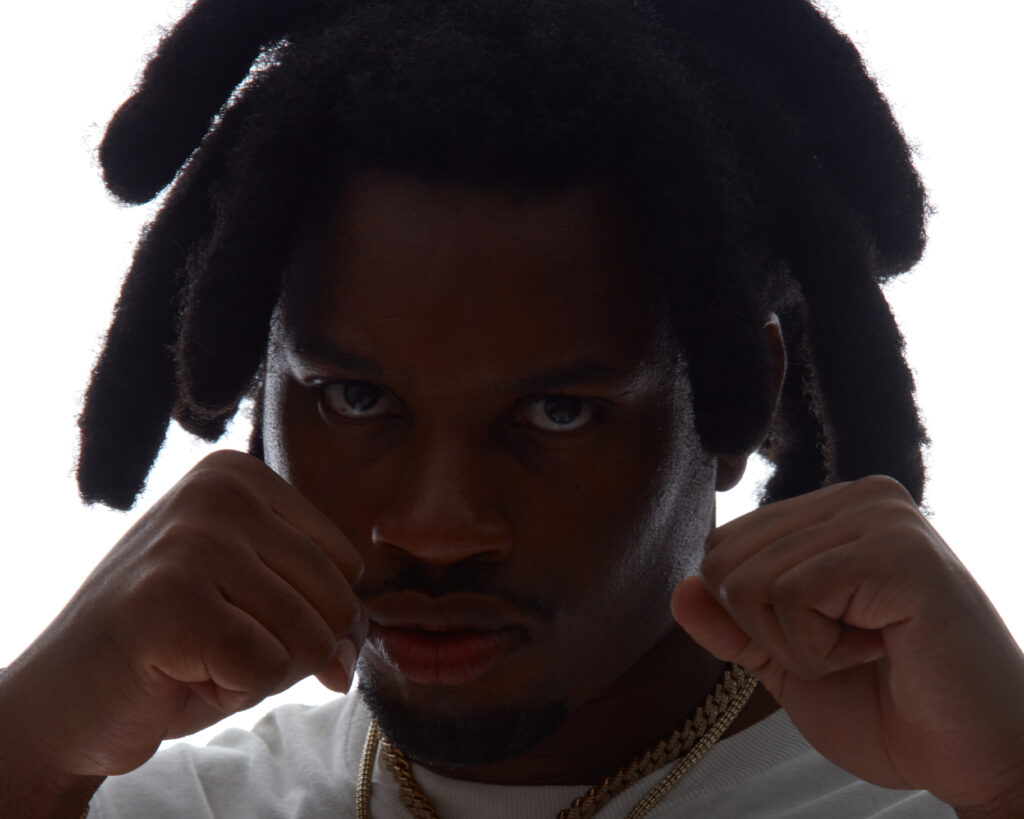
Cassidy George: Are you good at playing the game?
Denzel Curry: No, but I always stay myself when I am playing it. I just think it’s best to treat everyone with respect and dignity.
Cassidy George: What frustrates you the most about the industry in 2023?
Denzel Curry: Labels and the people that run them. When I say I want to work with another artist, they say «Sure, we’ll get to it”––and never get to it! It’s all fake. If they don’t see what you have to offer at that moment, they put you on the back burner. Everything I put out is quality and yet I am always questioned about the things I do. Right now, I’m focusing on getting my singles right. With albums, I’m playing the long game. I want to make sure everything I put out is timeless.
Cassidy George: How do you do that? By ignoring trends?
Denzel Curry: No, you have to pay attention to trends. You just can’t ride them all the way. You take bits and pieces. Good artists copy. Great artists steal. But you can’t steal something new from somebody that’s newer––that’s fucked up. I’d rather steal from old shit and make it new. Think about it: you couldn’t have Jackie Chan without Charlie Chaplin and Bruce Lee.
Team
Photography · Geray Mena
Styling · Sophie Gaten
Hair · Chrissy Hutton
Grooming · Alice Dodds
Location · The Rubicon London
Special thanks to August Agency
Team
Photography · Lucas Christiansen
Styling · Jeanna Krichel
Casting · Chisom Abuba at Whitecasting
Hair · Maria Ehrlich at Collective Interest
Makeup · Haneen Ajub
Set Design · Kristin Baumann
Model · Jojo Schneider at Tigers
Photography Assistants · Louis Headlam and Florin Elbel
Styling Assistant · Nutsa Khurtsilava
Retouching · Studio Gessner
Location · KMX Studio
Designers
Every few years, an ‘it-girl’ arises and claims her throne, crowned as such by loyal fans and social media enthusiasts alike. The contemporary it-girl is not only defined by her looks, but possesses the intelligence and self-assertiveness to back it up. Chloe Cherry is all of these things. After leaving her rural hometown of Lancaster, Pennsylvania to pursue the adult film industry, she shed her inhibitions and opened herself up to the world. But it wasn’t until a few years down the line that Chloe would realise just how much that fortitude would pay off.
Before she knew it, Chloe had landed the role of a lifetime, debuting for the first time in the mainstream entertainment industry as the beloved Faye in the viral hit sensation Euphoria. But prior to morphing into her aloof alter-ego behind the camera, Chloe lived a quintessential life — her down-to-earth, authentic disposition is undeniable. Like many of us, she grew up sourcing fashion inspiration from YouTube and discovered her favourite beauty looks by experimenting with technicolor eyeliners and iridescent glitter. Her small-town upbringing left her constantly yearning for something bigger. After speaking to her, it’s really no surprise that she struck gold — in every meaning of the sense, Chloe is a true star.
Even as a young child, Chloe knew she was destined to be seen, but her insular surroundings didn’t often yield big-screen stars. She reflects on growing up, remarking that Lancaster was a small-town environment, that she was different. She dreamt of bursting that bubble and making a name for herself, but she knew early on that she’d face some hurdles along the way. Luckily for Chloe, she managed to topple those hurdles through a rock-solid confidence in herself.
You were born and raised in Lancaster, PA before playing Faye and your life changing forever. I’m also from Pennsylvania and I’m very familiar with the restrictions that can come along with the lifestyle many lead in that area. How did your hometown shape you as a person and dictate your path?
It was definitely a small town with a lot of small-town values. People were very gender divided — where I live in LA there’s so much gender fluidity and we didn’t have anything like that. People generally weren’t as open-minded about things and I feel like even I wasn’t as open-minded about life and people when I lived there. They also don’t really think that much bigger outside of what they were born into. It was a very close-minded community that thought religion, specifically the Christian religion, was the correct way to live, and that you were just supposed to follow a certain amount of correctness. That changed me, because it made me really want to break out and do whatever I want. I very stifled by the judgment that people had there.
I feel like it yielded this person that is truly not afraid to show her different sides.
I’m not afraid to do anything, pretty much, if I want to. I think growing up there kind of told me that it’s okay to break a mould, do you know what I mean? It’s okay to do something outside of what is ‘normal.’
Before Euphoria, you were in the adult film industry. This is an experience that you have described as liberating. Have you always been in tune with your sexuality? What gave you the personal fortitude to shed your inhibitions and show that side of yourself to the world?
My comfort in my sexuality basically just came from really wanting to put myself out there. Being from Pennsylvania, in the middle of nowhere Pennsylvania, you don’t really have any connections, especially to Hollywood. I think that just made me want to try literally anything just to get out of that. Even though it’s totally fine to live this way, so many of the people I grew up around kind of live the same way that their parents did. I’m really grateful that I took a huge chance in life and that it got me somewhere. Where I’m from, people don’t really take chances.
What is the most valuable lesson you learned from the adult industry that you brought with you into mainstream television?
One of the most valuable lessons I learned is how to act, how to be on set, and how to follow directions — that’s where I learned to be an actor and a good performer in general.
What I feel radiates from you is an unbridled sense of self-assuredness. What is your advice to others who may not be as comfortable in their own skin?
We only get one life to live. We’re all born and we all didn’t choose to be born, but we definitely didn’t choose to have to work to live. So I just really think that we really shouldn’t judge ourselves on what we do for work in order to live, because it’s all about what kind of day you can get through. You can’t really live your life based on the people around you because those people might be out of your life one day. And then what matters? At the end of your life, it’s only gonna be you, so you need to make sure that you’re happy with your choices.
I’m sure that being on a TV show and all of the amazing things you’ve experienced lately have been a big 180 for you. When you were younger, did you always aspire to have an audience-facing role? What was your dream back then?
Growing up, I always thought I would be some kind of performer or that I would be on camera. At first, I never really knew that I was that good of an actor because when I was acting as a kid, in school plays and stuff, I never really got the big roles. But I was a good enough actor for the adult industry. So it’s been actually a pretty crazy surprise to me that all this has happened, but it’s taught me that sometimes people just have natural skills. I think that’s what I have more than anything — natural skill. A lot of it, especially playing Faye, just kind of comes easily to me. It didn’t really take a ton of training or anything.
Faye became such a likeable character because I think many of us saw ourselves in her. She said the things that we were all thinking and she also acknowledged her own flaws and shortcomings — she was real. In what ways do you relate to Faye, and on the flip side, were there any qualities of the character that were difficult for you to channel?
One quality that was hard for me to channel in Faye was just not caring about anything, but I feel like part of that is also being on drugs. So I’ve done a lot of research about being on drugs. The way that she doesn’t care what people think and will talk back to people — I feel like I don’t really relate to that. But I do relate to the way that she really likes to find a sense of community and a sense of home. I feel like that’s what she’s searching for by staying with Fez; she wants to belong.
Your life outside of Faye underwent such a drastic transition. Have you found that sense of community yet?
I feel like I have a decent amount of community here. I’ve met a lot of people, but it’s funny — I find myself so easily becoming friends with a gaffer or a makeup artist. But I don’t as easily become friends with people that are the other actors. I know a lot of them, but I feel like a lot of my friends are people that are behind the scenes and are just really fun and easygoing.
In some ways that makes sense because you can probably relate to those people more, given how quickly all of this picked up for you. After falling in love with your character, many fell in love with you for your genuine personality, your quirky, colourful style and infectious charisma. You’ve become a Gen Z ‘it-girl’ in your own right. So, I want to know about the ‘it-girls’ or individuals that paved the way for you — who were your icons growing up?
I loved Chloe Sevigny’s and Alexa Chung’s style for a really long time. I always loved Ryan Murphy’s shows and was inspired by the fashion on his shows. Miley Cyrus is somebody that I’ve looked up to and I also really love Claudia Sulewski’s style — I watched her videos for a while.
I can see all of those coming together to inform your style, and even Faye’s personal style in the show. I wanted to revisit your experience playing that role. I really appreciated the point where you mentioned that playing Faye feels natural — I think that’s why you and the character mesh so well and we all took a liking to her.
I don’t know if I’ve said this in an interview before, but there’s this one moment of my audition for Faye that I’ll never forget. I came in and I said the lines and I had this whole act that I would put on of being like, fucked up. I was doing the lines like that and then Sam goes, ‘No, stop. Just say it how you would say it.’ And then I just said the lines to how I would say it and then I got the role.
Which is amazing. It was effortless.
The only thing about being related to Faye — I think it’s so good. I just hope it’s not the McLovin effect where I’m typecast for the rest of my life. But I mean, I feel like it’s perfect. It comes so naturally to me. Faye is almost like a side of me. If I had kept going at my craziest and just kept going on drug and party binges, I might have ended up like Faye.
Faye is like you in another dimension.
Totally.
You brought up a really important point about wanting to avoid being boxed in. You’re at such a pivotal moment now; it’s only the beginning. I listened to you on Emily Ratajkowski’s podcast, where you reiterated that as a young girl, you always yearned to have a flashy persona. You wanted to be the ‘hot bimbo’ that everyone knew. It reminded me of a recent article that The Cut published titled, ‘The Reclamation of Bimbohood‘. Basically, it was about how our contemporary understanding of ‘bimbohood’ encompasses attractive and socially-engaged women — they are self-proclaimed bimbos who ooze confidence. Do you resonate with that at all? Especially coming from the realm of adult film, how have you managed to reclaim your own sexuality and identity?
When it comes to Faye, I feel like she’s a bimbo, but in a way that you wouldn’t always imagine. She’s kind of a low-end bimbo, you know what I mean? The trashiest version of a bimbo. But with adult films, being a bimbo was very empowering because so many people would like you when you looked like that. Part of me sometimes misses being a part of such a sex-positive environment where instead of people constantly making threads on Reddit saying my lips are so terrible, people were like, ‘Oh my God, you look so amazing.’ I kind of miss that different view. Even if it was a more perverted view, I kind of thought it was almost more positive than such a perfectionist perspective. Doing adult films actually made me a lot more confident in my looks and just everything about me. I feel very physically confident about things since doing that. I think Faye is also the same in that way. Faye is also somebody who uses her sexuality and looks to get things in life and she’s very confident.
Totally — and there’s a profound power behind that. How has it been navigating the scrutiny now that you have opened yourself up to a whole other world?
Dude, it’s so weird now. What I don’t miss in porn, is people would call me fat all the time because I was showing my body, but now I don’t really get people calling me fat anymore because I don’t show my body as much. People now scrutinise my looks in such an interesting way. They’ll say, ‘Oh my gosh, she’s so fake. Look at her lips.’ Whereas people used to not really say that.
It’s very intriguing to hear the difference between the two types of entertainment from your perspective. Part of what makes your character and your true persona so endearing is your affinity for making people laugh. You don’t seem to take yourself too seriously and have cited shows like Curb Your Enthusiasm and It’s Always Sunny as your go-tos. If you could be a character in any comedy, who would you choose and why?
I personally consider Succession a comedy. I think I would make myself one of Cousin Greg’s mean girlfriends — that would be funny. I do really like Curb Your Enthusiasm. I would love to be a part of that. I feel like I could be a waiter that Larry David fucks with or something like that.
Not only are you a multi-faceted actress, but you have modelled for Laquan Smith, GCDS, Blumarine and more. You’ve gotten to live out the experiences of any fashion enthusiast’s dreams. Have you always been into fashion?
I’ve always been really into fashion. I love looking at fashion online and it’s something that I’ve always followed on social media. It was really surreal for me to be able to walk in those shows and I really hope I get to walk in more one day.
I would describe your style as effervescent, frisky and engaging. I’ve seen you take a liking to graphic tees and Y2K-era silhouettes. How would you describe your own style and what types of pieces do you usually gravitate towards?
I usually gravitate towards stuff that — this sounds kind of weird — but I like stuff that looks like something that I personally would’ve worn as a kid. It’s basically just because I have the same taste that I did as a kid, so I dressed very Y2K because I grew up in that time period. I’m really attracted to stuff that was ‘in’ back then; it’s just ingrained in my brain. I also like really weird stuff, stuff that looks really unique. But for the most part, I constantly wear clothes that are reminiscent of the 2000s.
You were also the face of Urban Decay’s Bond Liquid Lipstick. Urban Decay is one of the first makeup brands that I fell in love with as a tween getting into beauty regimens. What are some of your earliest makeup memories?
Actually, one of my earliest makeup memories involves Urban Decay. The first time I started wearing makeup, I was in sixth grade and I didn’t really wear real makeup. I would just take this glitter eyeliner and put sparkles on my eyelids every day. Then eventually I got this Urban Decay blue eyeliner and then I started doing that.
I had the exact same blue eyeliner and I loved it. How has that routine evolved as you’ve matured?
I’ve never told this to anybody, but when I was 15 years old I discovered Lily-Rose Depp; I found her Instagram and I loved her aesthetic and the way she did her makeup. It was so simple. She would literally just do a little bit of blush, mascara, and nice eyebrows and I was just obsessed with it. So I completely dropped all my crazy makeup, started doing really simple makeup and I’ve just done it like that ever since.
You’re just getting started showing the world who Chloe Cherry really is — you’re an esteemed actress, a model, a style icon for many, and even a SoundCloud rapper. How do you hope people remember you decades from now? What’s the legacy you’d like to leave behind and what are you working on right now that you’re excited about?
A few years down the line, we’re on Euphoria season seven. I maybe have my own fashion line, maybe my own skincare line, I’m doing more beauty campaigns and just doing all sorts of high fashion campaigns. I love being on Euphoria, but if that ended, I’d love to be a regular on something else. I just want to keep continuing to do what I do because I love it.
Team
Talent · Chloe Cherry
Creative Direction · Jade Removille
Photography · Ricky Alvarez
Styling · Kathryn Typaldos at Forward Artists
Hair · Ericka Verrett at A-Frame
Makeup · Rob Rumsey at A-Frame
Styling Assistant· Nicole Grasty
Location · FD Photo Studio Los Angeles
Interview · Kayla Curtis-Evans
Special thanks to Lucy Greene at Anti Agency, Amanda Horton at ALH PR, Hannah Hardison at A-Frame
Designers
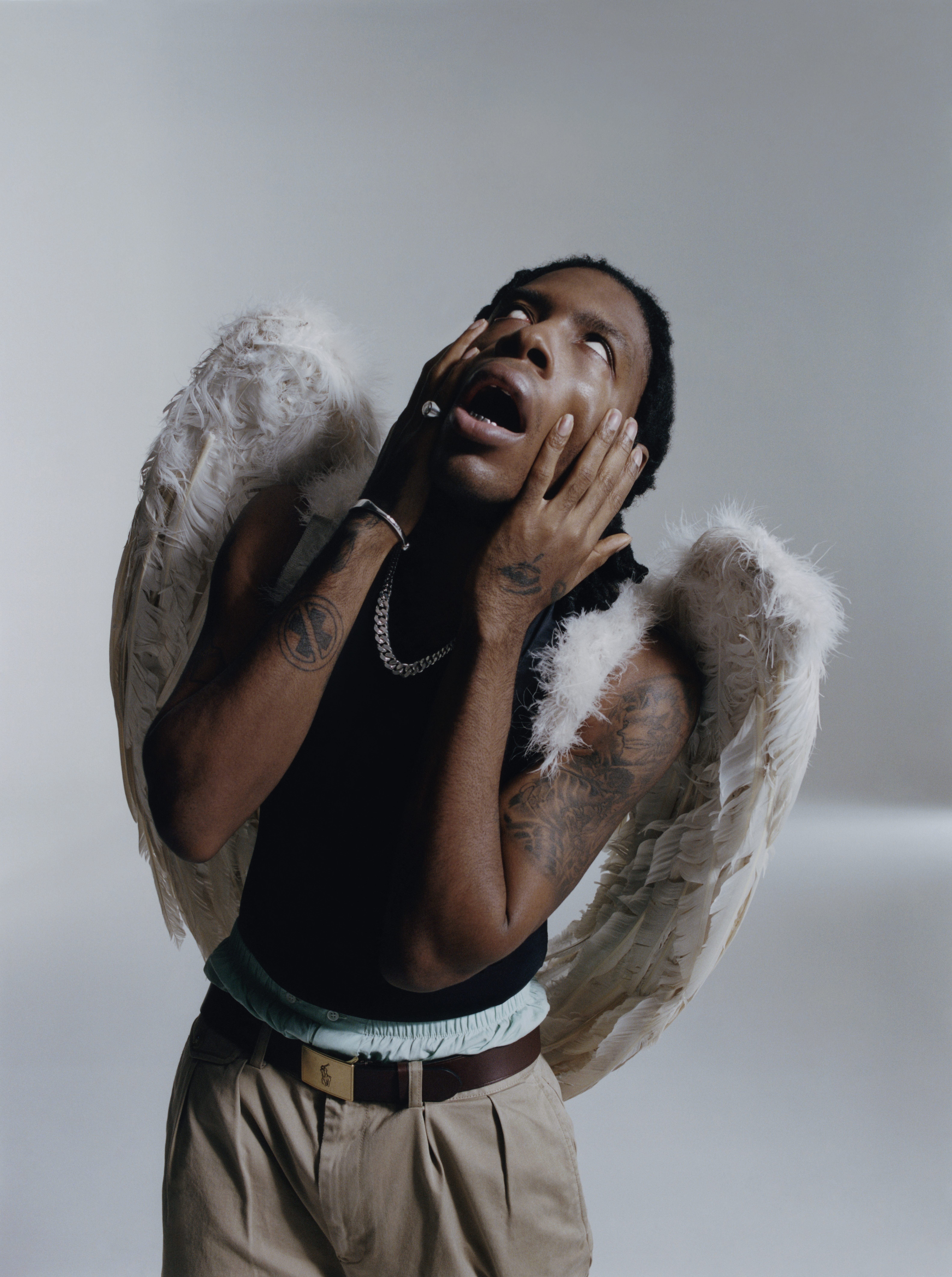


Born in 1992, Nigerian-born artist Osayaba Andrew Ize-Iyamu, aka Cruel Santino, has spread his talents at a pace and rhythm that has led to rapid development in his oeuvre and skillset. Entering into Santino’s world is no easy feat. An analysis of his work is cumbersome and tiring. It almost feels like walking into a packed gallery with great artwork but not enough walls. In this case, there is a word limit. Looking at Santi’s work is difficult because, no matter what area is observed – whether it is his video-game production, filmmaking, graphic designs or music, it makes no difference – there is a level of quality and intimate love that has been squeezed through the medium. Since he released Mandy & The Jungle (2019), Santi has been seen as a musician. This box has various conditions that assist and obstruct an artist’s ability to create. He has since outstretched his wings and engulfed a wider array of mediums, a decision that has allowed him to reach a diverse range of audiences and express his entirety to the world.
Observation involves a negotiation of the mind. When examining his work, it is easy to become amazed and overwhelmed by the impressive variety of skills the artist has and the breadth of knowledge in each area he produces. He is an example of how technical assertions and a devotion to craft can foster prosperous results for him as an artist and those who ensure his ongoing production. In doing so, he has made a lot and has no plans of slowing down. NR attempts to decipher the man who has no limits to his portfolio. As he digs his toes into game design, creative direction and art unmarked by labels, Santi advocates for a movement towards creative freedom that is accessed by all.
Santi is not merely an artist with raw talent but somebody that devotes his entire being to his work. His intentions? To ensure others can do the same. Unbound by the conceptual chokehold of artistic monogamy, Santi sits down with NR to delve into how dreams are more than concepts: they are an impetus for potential action.

There is more to Cruel Santino (Santi) than meets the eye. To list accolades or only discuss his music would be reductive. His art sets a scene that is unbound by the rhetoric of constriction. His art is the object of the discussion, and he is the subject. So, where are we, Santi?
I’m in London right now. I’ve been here since the end of January and have another two weeks. I came here to try to get a different space to work in. I had a bunch of stuff to do here, and I’ve been producing and doing everything here.
And you were just celebrating the first anniversary of your last album release: Subaru Boys: Final Heaven, released last year on March 4, 2022. You celebrated through ‘Subaru World’. What is that?
I did an installation and show in early March to celebrate the one-year. It definitely doesn’t feel like it has been a year. It was unplanned, but it was pretty well done. Showcasing the characters and the world of ‘Subaru’, the Institute of Contemporary Arts (ICA) instilled an immersive anime experience in collaboration with NTS Radio. It felt great seeing the world we had built, the sounds made and the distance we have covered and will continue to cover.

And what were your inspirations for the album itself?
I usually have four things that make up my being: gaming, anime, film and music. For ‘Subaru’, the two main ingredients in its production were gaming and anime. Those are things that have always been around me in my life, and I have consumed them for my entire life. Even today, I checked how many games I had played between the release of PlayStation 4 (in late November 2013) and PlayStation 5 (released in late 2020) eras. It was about 340 different games.
That is… a lot.
It is a lot. And If you check my body, all my tattoos are anime related, so I feel like those two things are definitely the main ingredients that have made up ‘Subaru’. I also took a lot of inspiration from Hideo Kojima, who really pushes the boundaries of what a game is and is meant to feel like; he’s just trying to tell you that a game can be anything. It doesn’t have to be one-dimensional or the same thing every time: he proved that a game can be anything. I like to apply how he treats games to everything I do, whether music or video. In doing so, I’m making music that can transport people and doesn’t have a box, music that can build a world that can be taken wherever through sounds.
And how do you see gaming transposed onto your work?
Lots of games are played as drugs to release you from feeling, but I like to play AAA Campaign games, which really differ from Battle-royale type gaming. There’s more of a narrative. There is a world behind it, with excellent sound design, great voice-acting and graphics. I study all those things, and they all inspire me.


When did this all start? How did gaming become the conduit for your self-expression?
I didn’t realise until recently (maybe around 2020), but gaming shaped my sound immensely. When I was younger, I didn’t really have a way to hear various songs back home (in Nigeria). I found so many songs through Fifa, for example. I really only found songs through the games I played.
Released in 2019, Mandy & The Jungle (your first studio Album) was inspired by a lot of things…cartoons, the dancehall era, and gaming. But things changed after that.
I needed to push the boundaries of what I was trying to make. At one point, during some period of quarantine, I was gaming too much, listening to music, watching anime, and getting to the point where I couldn’t ever see anything the same way anymore. I would look at everything in life and hear anything and its sound, run back home and try to fuse the sound, thinking, ‘oh, this would sound great in a game’, or when I would make songs, I would try looking for a clip of the game and put my music over it, watching the clip to see how it made me feel. Everything felt like anime to me. The thing is, I wanted to make a world that would attract what I wanted. I want to make games, I want to make anime, and I want to make more films. I asked myself, ‘how do I build this world with what I’m trying to do?’ and it came through the world of ‘Subaru’, which is slowly attracting everything I want.

When it comes to your movements in the creative sphere, you’ve done graphics for artists, directed videos for musicians like Goldlink and worked in many areas. When did all that start?
I’ve done that all my life. I’m not just a musician. I have never been just a musician. When I was just a kid, when I was ten, I used to act in Church and do Church dramas in schools and started writing scripts and stuff like that. I could have been anything at first: I could have been an actor or a writer or anything; I wanted to create experiences and create stuff. But, the thing is, music came out because of all these other things around me that I’ve crafted and sharpened to build up the music. Even down to the creation of characters in ‘Subaru’, I’ve been able to give people backstories and worlds around them. I feel like, if you know me and my music, you would never see me as a musician.
You are more than just ‘one’ thing.
Definitely, the way I see life and create music is like method acting. It’s sort of like Daniel Day-Lewis, going into his own space and shedding off ‘the self’ for the role. It’s crazy because you think, ‘how do you go from playing this character to another’ and you realise he really is just shedding off the old and becoming the new , applying it to himself and growing. I feel that you can’t play a role that is not in you, so if you feel there is something in you for it, you just have to learn more about it to the point where you can become it and do it.

Do you think you’ve achieved that level? Are you happy with how far you’ve come?
I feel like I’m still working on that. Coming from Nigeria, trying to do what I’m doing is… well, some people don’t think it’s even possible, so I’m just happy that I can do the things that I’m doing right now because I have the chance to do it and keep growing in that environment.
And how do you think people react to your multi-faceted style?
Some people don’t understand what I do, but I feel like I’m more concerned about creating. That’s the thing. People have received me well, they appreciate what I do, and that’s great. It keeps me going, but my focus is on the fact that I have to keep creating, and I have to keep making sure to keep pushing boundaries.
Over fame and novelty, you seem to really promote a priority of production – so do you just want to create? Did you always try to do this from day one?
Yeah, I just want to create. Success (and all that other stuff) will come if your creation is pure and timeless. I’ve always tried to incorporate myself into everything; all my videos are directed by me, and most of them are edited by me. I’ve always tried to be that person who can do most crafts. My craft wouldn’t be mine if I didn’t do the work; you can tell something is missing. If I don’t put all these touches in my work, it will never feel like it’s ‘Santi’. So that’s why I try to have as many roles as possible in my projects.
Did someone inspire you to make a conscious effort to take on that burden?
I’m just good at creating stuff. Where I come from, I’ve always dreamed of making these things in my country, trying to improve all these aspects of my country. I want to hopefully make a game there, and if you have the infrastructure to set it up, and I have the foundation of sound to set the music up. Now that I’ve gone from making sounds to making an anime, gaming world, I can see it getting bigger and going further. I want to keep making things that expand possibilities, and since I’m not just a musician, I’ll be able to do it.

When transferring a skillset and mindset from one album to another or one project to another, there must be variations in your level of confidence and experience. Where do you think you have improved?
Recently I’ve learnt how to make my music cinematic and learnt more about the technical side of film. Before, I could edit and direct, but now, I shoot stuff for my friends, I shoot stuff myself, and I go out and shoot a video and come back home and edit properly. All of that came later, though, after years of experience.
Was there any group or person that inspired you to go into this multi-direction?
Nobody ever really gave me advice. I’ve literally always been in this bubble working. Sometimes I wish that I’d had a mentor. I don’t really have anybody else, and I started building all this up around covid, both before and around that period.
How important is your team? Does it feel special to work with people now?
It feels good. It feels great when people try to help you do stuff because people taking time out of their lives to help you is really kind. For me, generally, anyone that does that, I’m eternally grateful.
«As humans – and especially artists – we need to realise that you can’t downplay the interplay between us and how much it can help you build.»
You are only one person, and you can’t do it all by yourself, so appreciate anybody who is there for you in any capacity, no matter what it is.
Do you find it important to be in other people’s lives? Does it make you feel good to contribute to other people’s lives? Are you now in a community where everyone helps everyone?
It makes me feel better, but it’s more about their feelings. It is essential to make people feel. To make people feel like you know their worth, no matter what the person is doing. If people take their time to help you build your world, then they believe in you so much that they take their own time to work on you. So you have to take time out of your life to help them. It makes you feel humbled and balanced, it makes you feel human. Sometimes when you are an artist, you are a step back from what is happening in the world. You can be so focused on what you are doing but be unaware of what is going on around you. I feel like taking time out to be around people keeps you in the loop. People keep you in the world.
So the community keeps you up-to-date with what’s going on. Does it help you keep producing new material? How does collaboration further this goal?
I just want to see it all happen. Collaboration is key in all of it. The journey of your world to someone else’s world is very important. A sense of community definitely helps. If I had stayed to myself, I wouldn’t have grown as an artist. Meeting new people helps so much, and last year I took time off to spend time with my friends in their worlds, and they helped me so much with building ‘Subaru’.
Do you have friends in the industry that have helped you?
I don’t have ‘industry friends’. I just have friends that I’ve always known before. We all came together and found ourselves in this place, and I feel that’s also what makes everything feel so different to me. I don’t have music people or anything. The people that make music are my friends? I knew them before we stepped anywhere near music, and they’ve always been with me, and that’s why our community is strong and the way it is.
«Starting up together changes everything.»
Where does the media come into your world and the world of others? What do you think people have to say about you?
Everybody creates whatever they want to think or say about me. The media is going to come in and do their thing. At some point, I was known as a devil worshiper because I liked horror movies. Later it was something else… It’s just a lot of things. I don’t think I’ve ever been described as one thing for too long. They just let me do my thing, and they are always in anticipation and will either like it or not. I don’t think it’s ever been straightforward with me, and I don’t think there has ever been one way the media has interacted with me.
You can always keep them guessing. It’s probably better for you: you have less obligation to perform to a certain standard. People will eat it up no matter what, but does the fact that you make so much mean that audiences must experience all of it to truly appreciate you as an artist?
I believe that in everything I do, there is no specific audience or demographic. I make everything for everybody. There has to be some substance to draw from everything. There are ways to draw people in, people from different sectors, and I don’t focus on one demographic because I’ve been inspired by so much that it should be for everyone.
Surely that gets overwhelming… It can’t be easy when you are working with so many senses, especially since you aren’t just producing sounds but images, concepts, emotions and tactile substances.
Ah, yes, always. I need to try to rest. I need to start taking breaks because I never take breaks; mentally, I just can’t do it, and if I hear a sound, I just want to go back and produce and start thinking of what I need to do, or I start brainstorming a shoot. It’s a never-ending cycle, and I’m trying to work on it. That’s the thing; sometimes, it’s just not the best. I can hear one sound, and I’m already zoned in.

Do you think that your drive is always going to be there? Even if you don’t rest?
No matter how driven I am, I feel the effects of me working myself too much and overthinking. I definitely need to work on that; as a human being, you can’t treat your body well without some recalibrations. But it’s not easy, and even if I’m travelling, I’m working or inspired to work.
So you have a bit of a full plate. Does that impact your time management?
Luckily, no. I take my time with everything, and since I’m doing so much, I have to really ensure that everything is balanced. I can spend three months making the music and then spend another month on the writing. When I build up the music more, I have the opportunity to build up more of the narrative. Just giving time for certain things is really important. After each project, I look at what I have done and whether I could have done something better. No matter how good or great something is, time needs to be devoted to knowing all the components; even if they take me a long time to develop, I must make sure that I treat every aspect of the concept and give every bit of it the same treatment and love. Everything has to have energy in it.
How do you see your work growing? What’s your end goal, and what do you feel is the best thing that could happen?
You have to just keep learning.
«My goal is to create a space where Nigerians, Africans and the world, in general, can tap in and create freely. I want to make a safe space for people with dreams. I hate that they are just dreaming. If they want to do it, they should be able to.»
Once there’s a safe space for that, anybody can achieve their creations. There is so much talent in the world and people with dreams. What I have put down, what led me to create what I’m making, needs to be facilitated for someone. The codes must be passed to someone so that new things can be built; that’s just how life should be. If there’s a space where all of this can exist, then we will be able to create things forever.
The plan, then, is to facilitate people’s dreams.
A lot of people keep to themselves. But people together can push boundaries. Lots of artists don’t really come together to produce something, and it puzzles me. Unfortunately, not every environment allows you to dream that much, and it’s nobody’s fault in particular. Some countries just don’t give room for that sort of creative freedom. Everything I’m doing is a dream because it came from a dream, not from me seeing that it was possible. It was just a dream and a belief that I could do this and change how things work. That’s what keeps me pushing. I could have chased the commercial route and chased solely making money. But that’s not why I’m doing all of this.
«It wouldn’t feel right for me to do that, and my goal is to create an environment where you show love to everybody and ensure everybody tries.»
Team
Photography · Lea Winkler
Styling · Emma Simmonds
Grooming · Ryunoshin Tomoyose
Photography Assistants · Guy Parsonage and Tom Frimley
Location · Spring Studios
Interview · Billy De Luca
Special thanks to Jaisha Thomas-Hinds at Wired PR
Designers
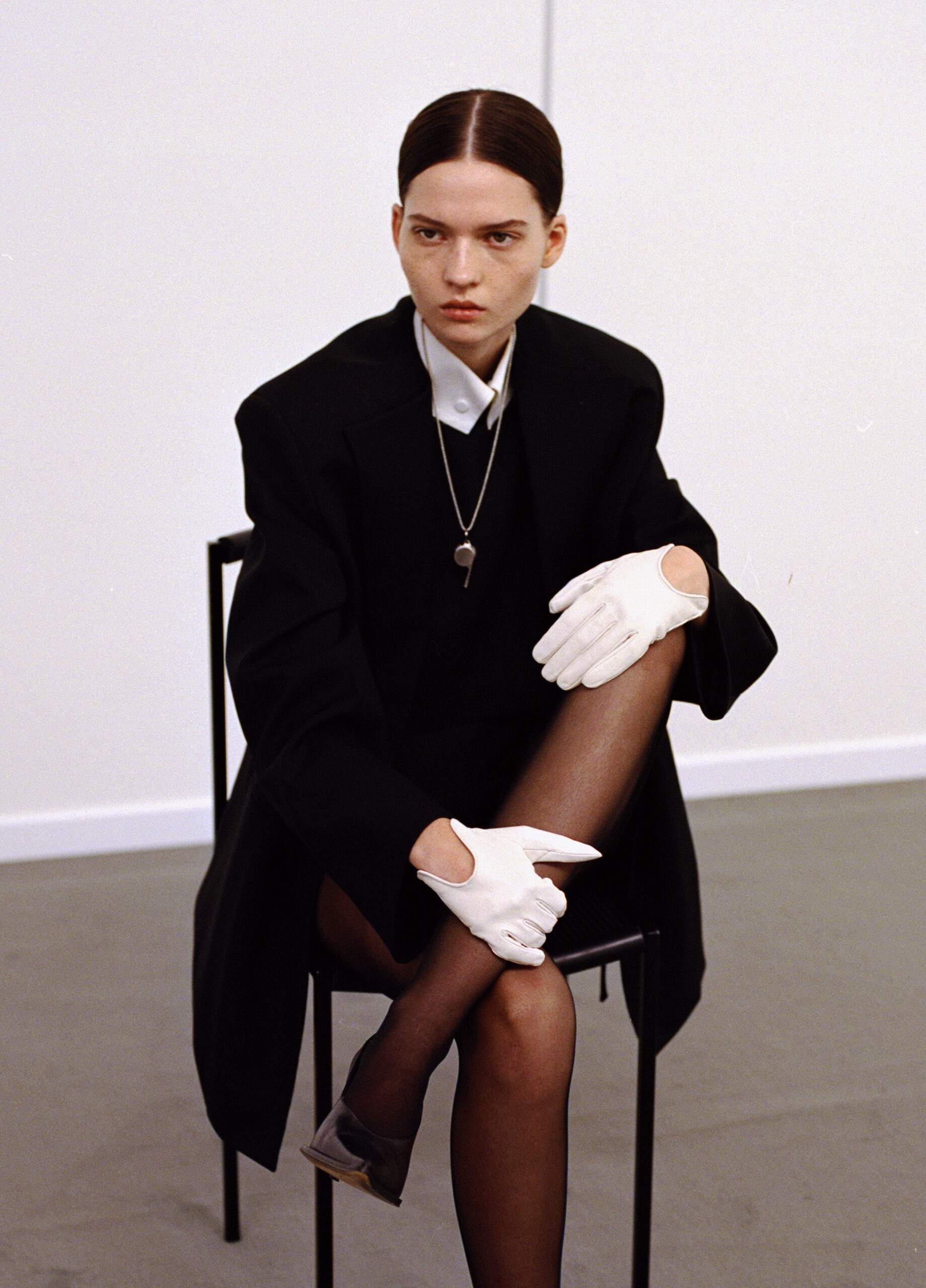
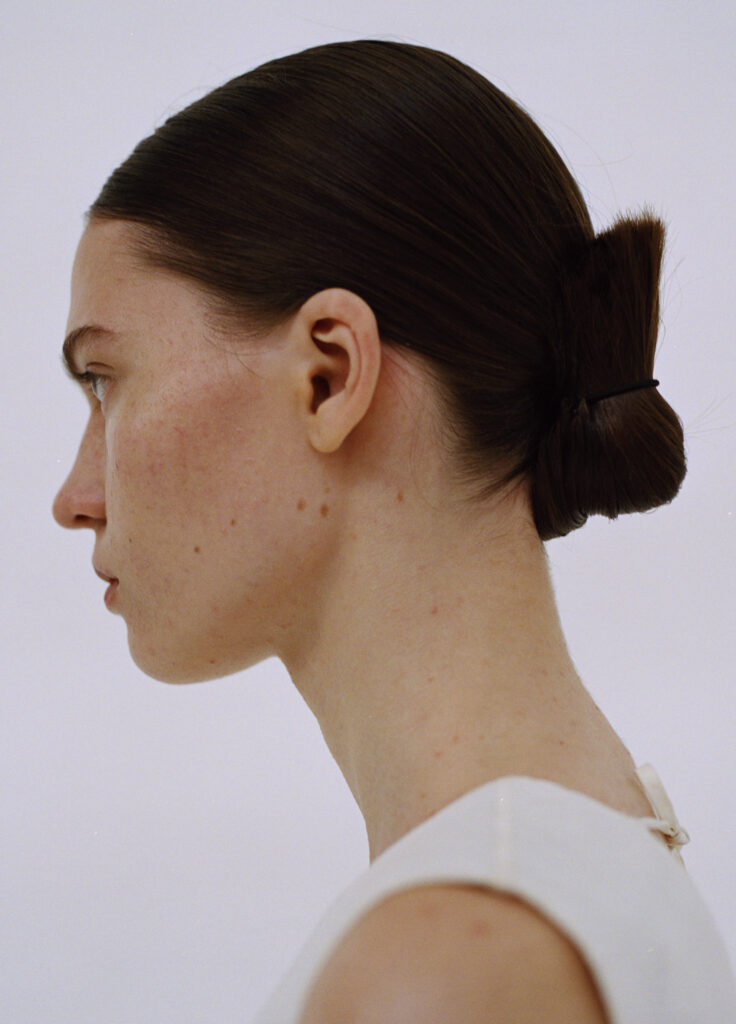
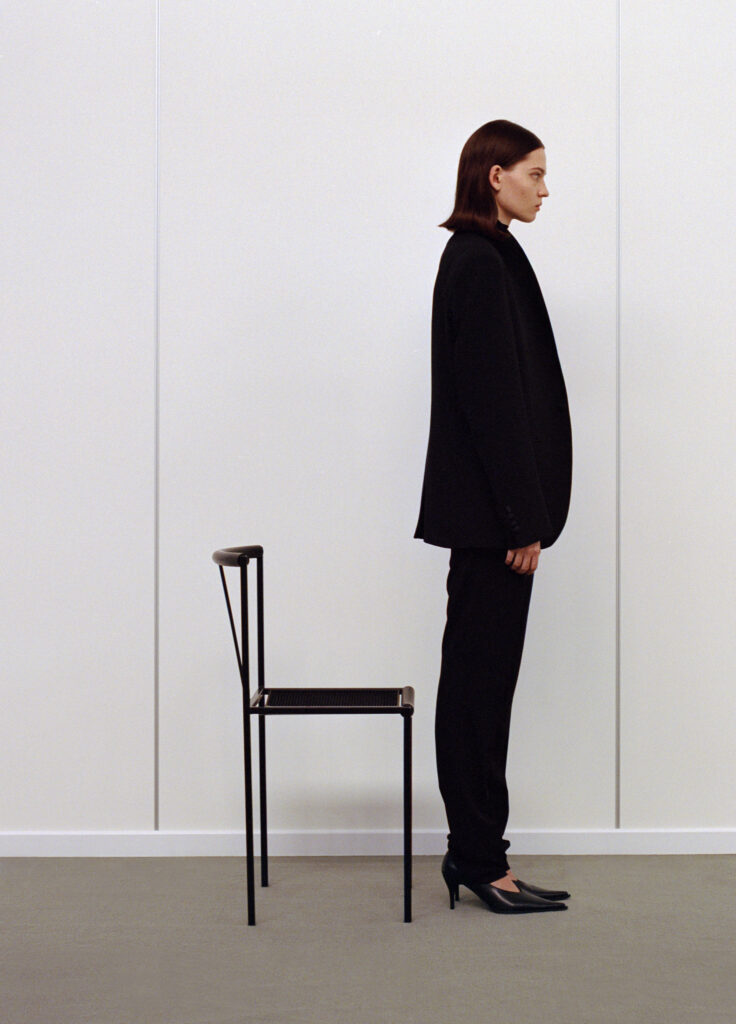
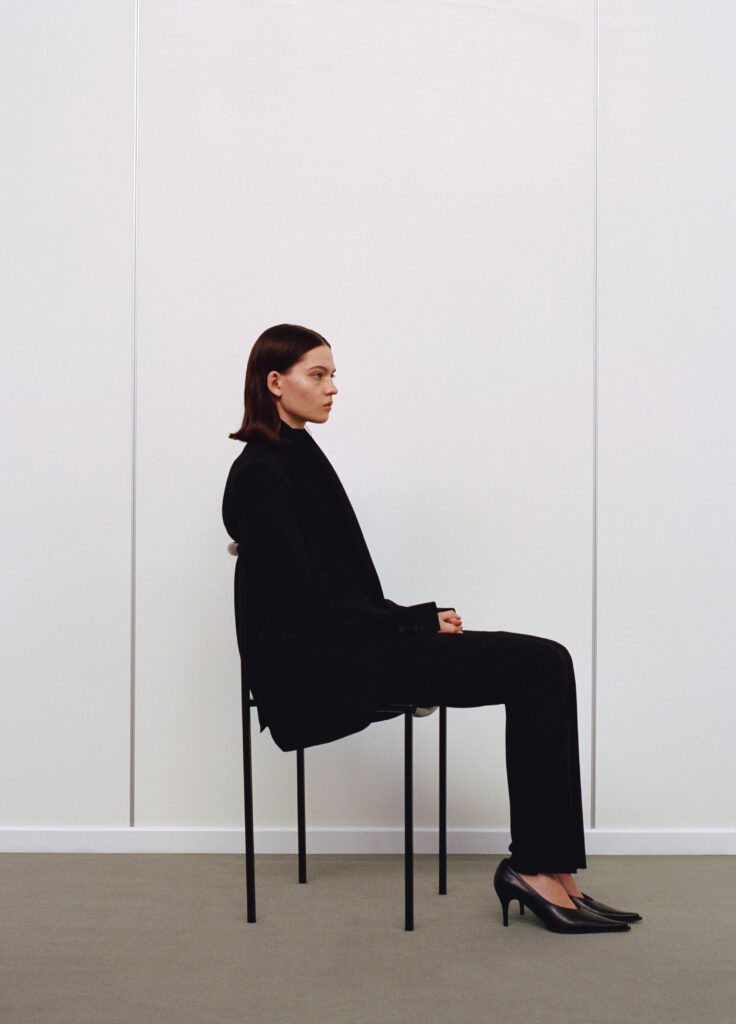
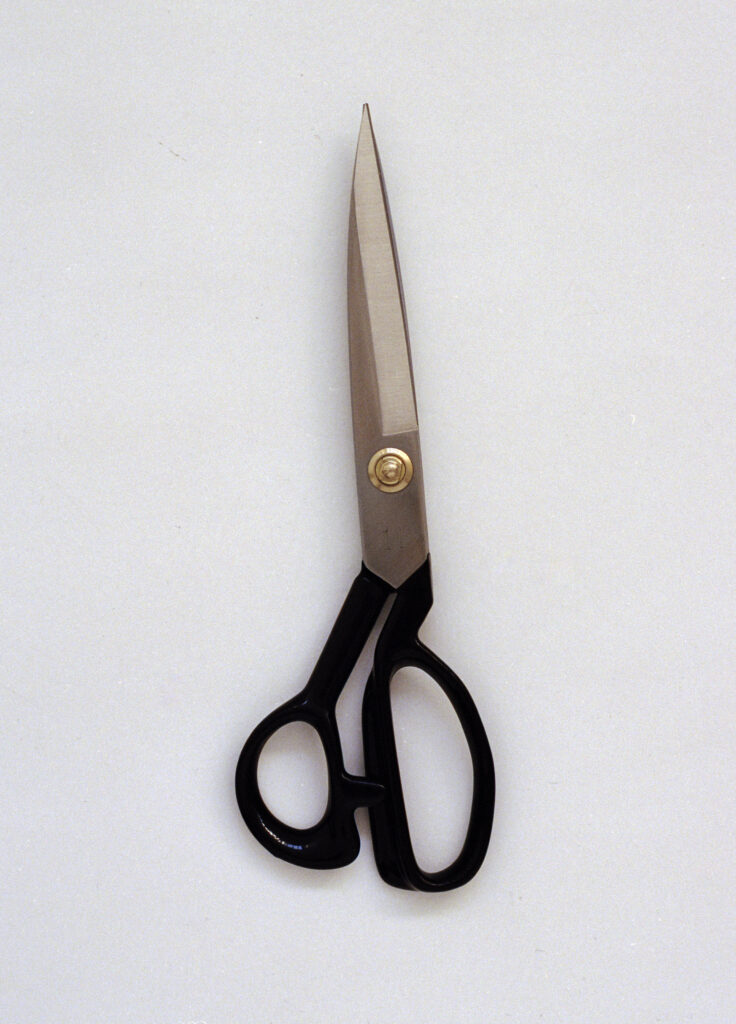

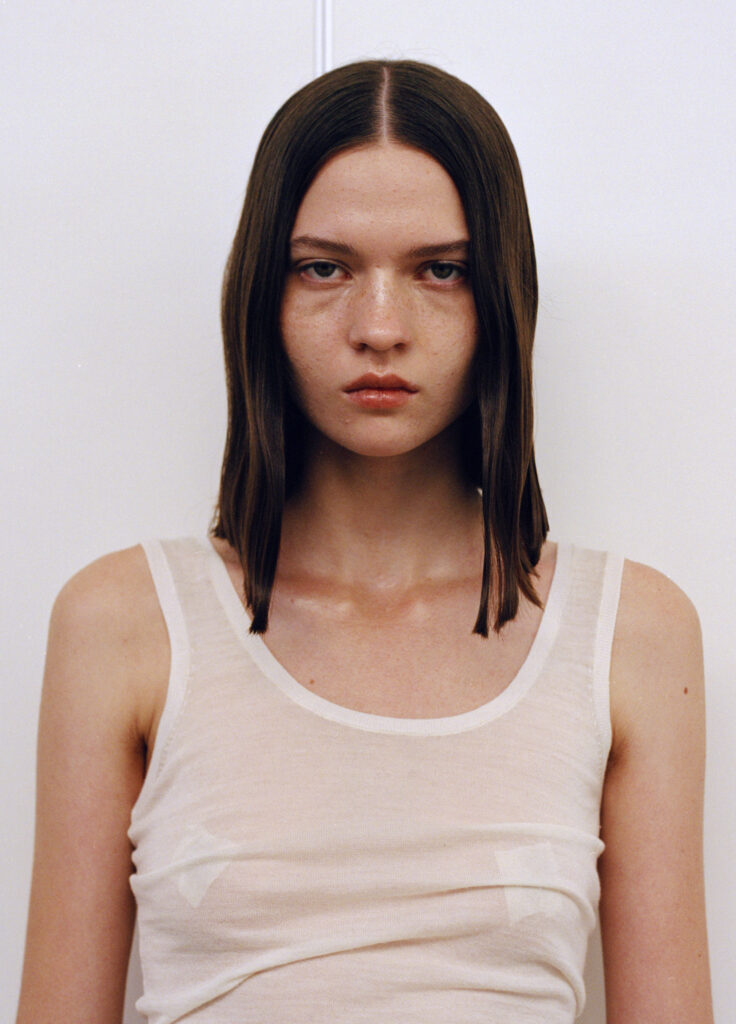
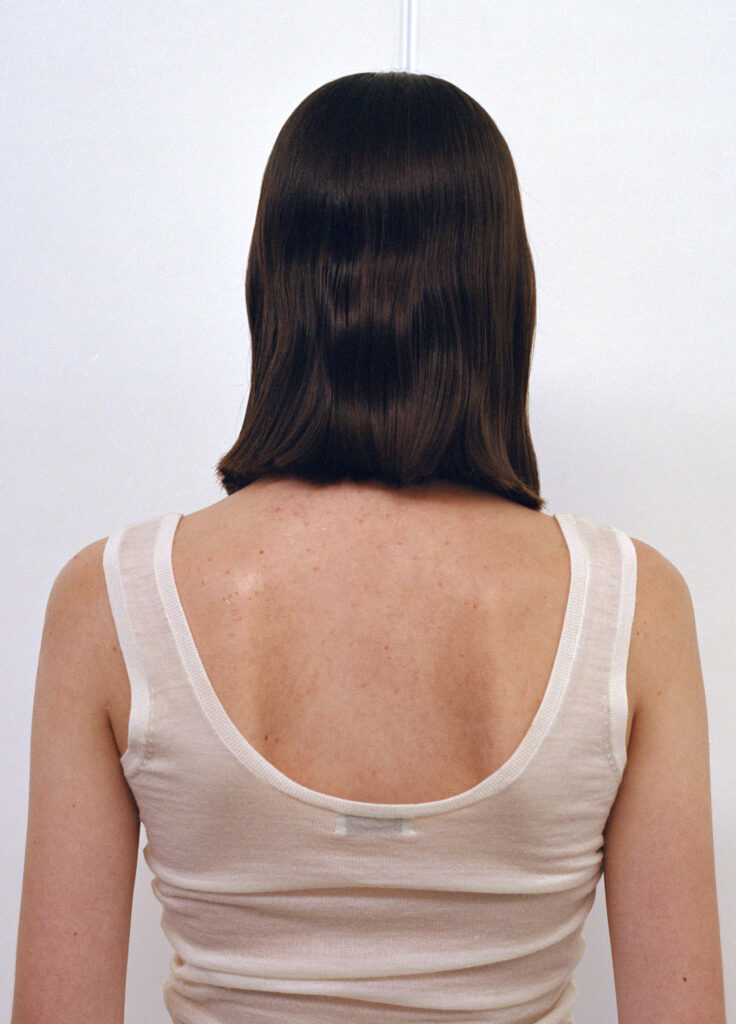
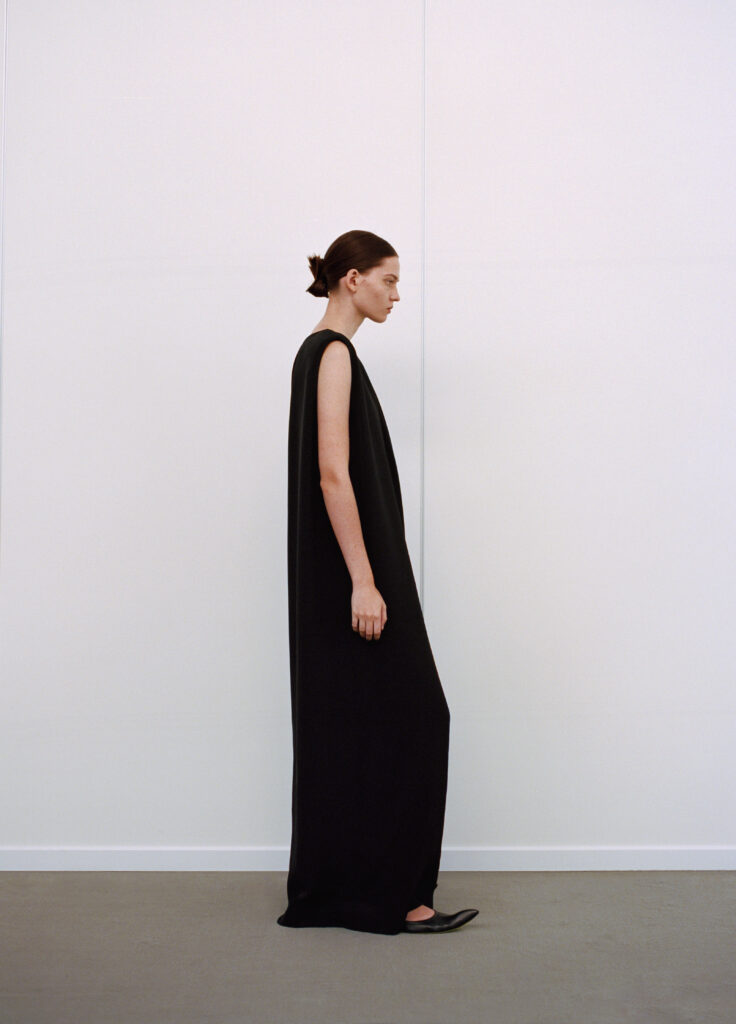
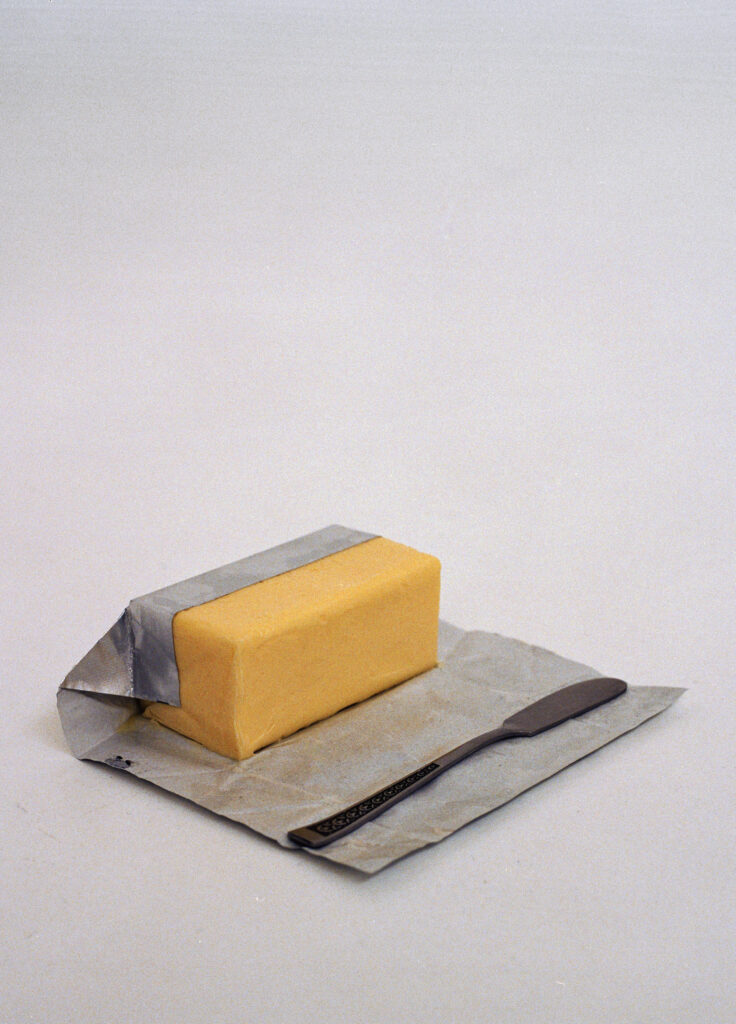
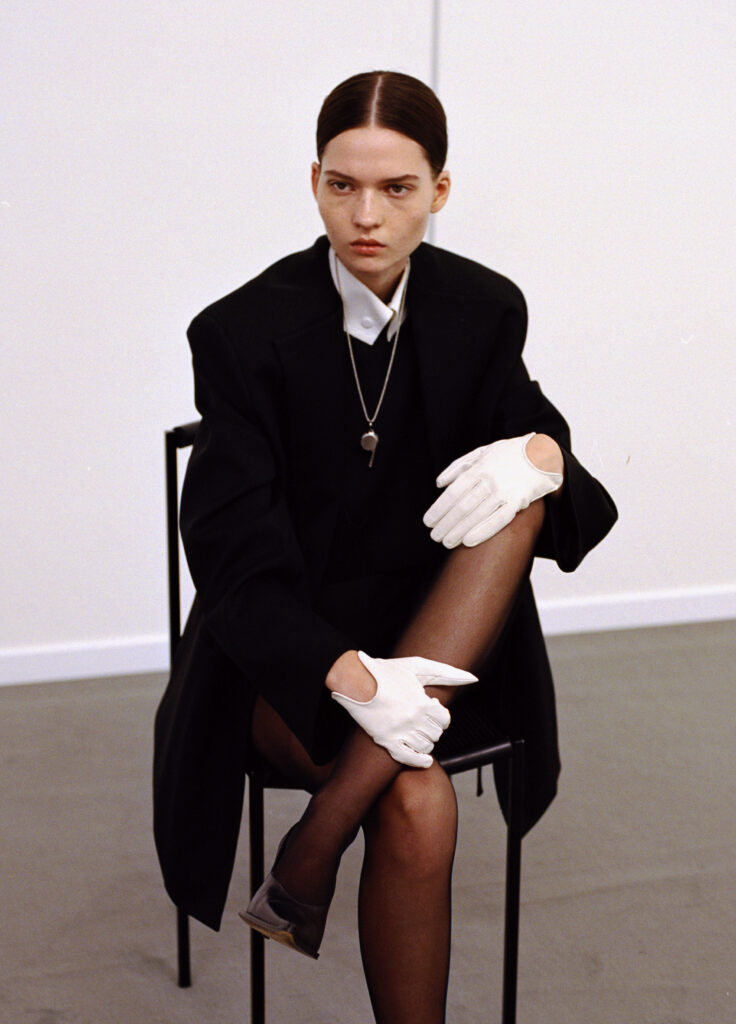

Team
Photography · Antonino Cafiero
Art Direction · Will Merante
Styling · Francesco Saverio Costanzo
Hair · Alessia Bonotto at Blend Management
Makeup · Alessia Stefano at Blend Management
Set Design · Leyla Heart
Model · Olesiya Bazanova at IMG Models
Photography Assistants · Giorgia D
Designers
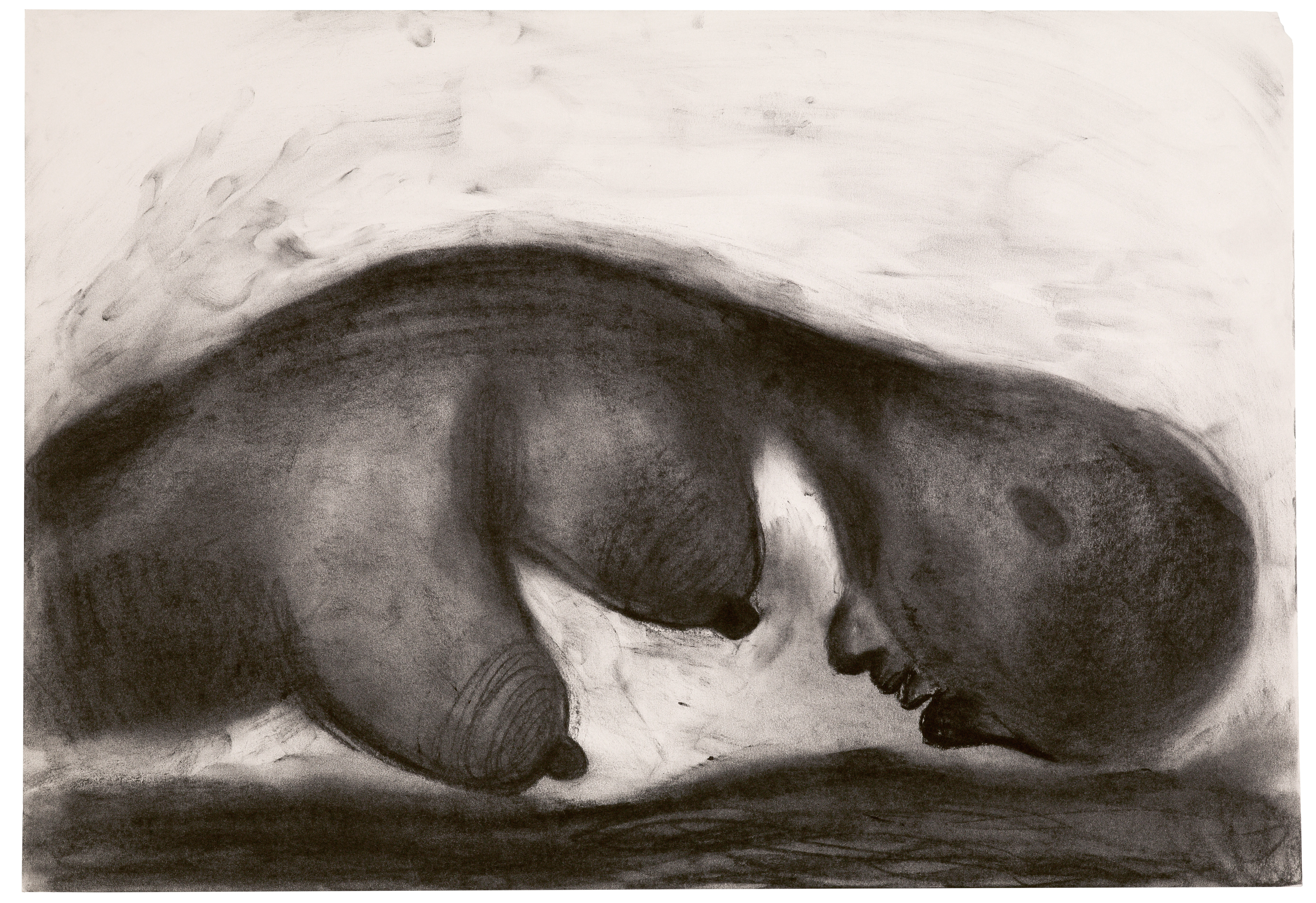
Miriam Cahn, Aus der wuste, 2016
Oil on canvas, 145 x 190 cm
Photo: Oliver Roura. Courtesy Private collection.
Miriam Cahn (born 1949 in Basel, Switzerland) started her career in the 1970s and initiated painting at the age of 45 in the 1990s in Switzerland. Awarded the 14th Rubens Prize of the City of Siegen (previously obtained by Cy Twombly and Francis Bacon) on June, 26th, 2022, an honour combined with a solo exhibition at the Museum für Gegenwartskunst Siegen, Cahn is one of the most highly regarded artists in Switzerland. Having her work exhibited in numerous international shows and exhibitions, including documenta 7 and 14, Kassel (1982 and 2017), the Venice Biennale (1984), Kunsthalle Basel (1983), Museum of Modern Art, New York (1984), Fundación La Caixa, Madrid (2003), Neue Nationalgalerie, Berlin (2004), Badischer Kunstverein (2014) and Kunsthalle zu Kiel (2016) and many diverse exhibitions across Europe in 2019. When I first discovered her work at the Institute of Contemporary Art in Milan (2022), at the GEZEICHNET exhibition (curated by Alberto Salvadori and Luigi Fassi) I was instantly taken aback by her use of the sometimes garish colours in her oil paintings. Cahn though initiated with black and white charcoal drawings. She states her method of painting and drawing was back then similar to a performance whether it was on the floor until her back could not take it any longer, or on tables, or standing up with the canvas against the wall as she proceeds now, with oil painting. With a more diversified use of colours, Cahn was able to monumentally picture real scenarios.
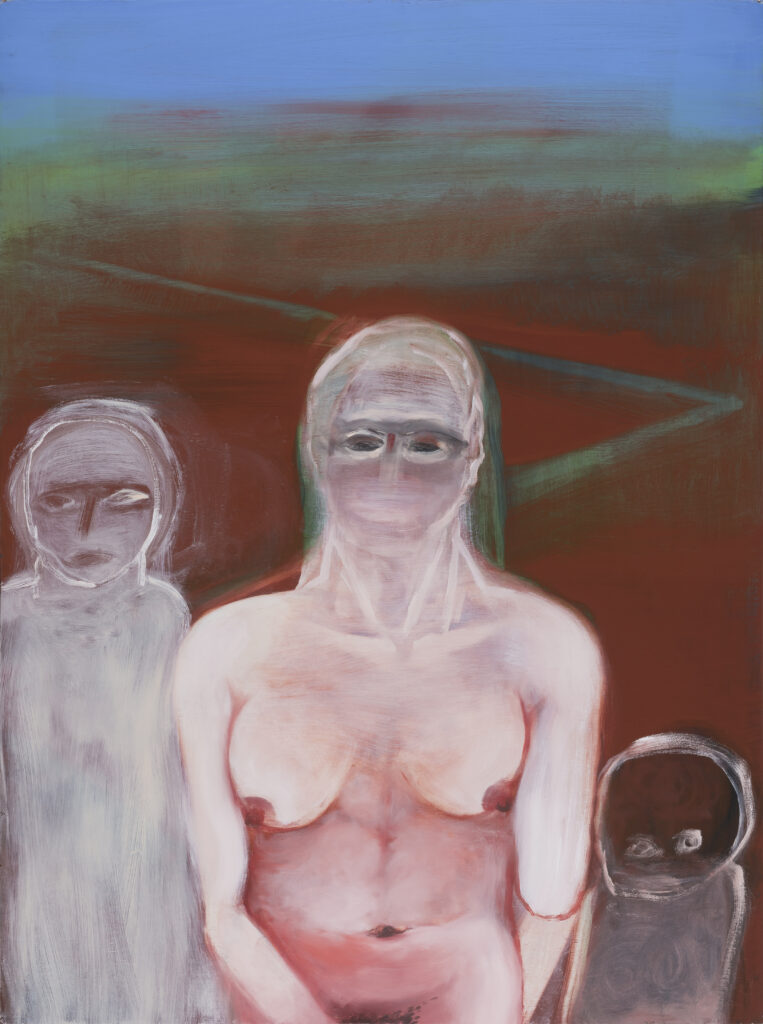
Miriam Cahn, Mutter kind kind, 2016 + 19.03.2017 Oil on wood, 118 x 88 cm
Photo: François Doury
Courtesy of the artist
Ghostly bodies form compelling and ethereal paintings which in turn express the incredible vulnerability of human beings, the uncertainty of life and death, the fragility of nature and what humanity in this day and age is. Womanhood, fecundity, strength, sex, intimacy, violence, war, refugee crisis, oppression are some of the recurring themes in Cahn’s artworks. It is exactly because Cahn is human that she explores these thematics. As the Swiss artist puts it, “everything is influence” for her practice. Flora, fauna coexist with mutilated bodies and brutal sex forming an absurd quasi monstrous but deeply emotive complexity which is mankind not her “invention as she explains.

Miriam Cahn, Blutungsarbeit, 10.11.1994
Chalk on paper, 54 x 77 cm
Courtesy Private collection, Switzerland
Cahn’ works from the last five decades show her artistic development as well as the evolution of our world and its contradictions, engaging the viewer in seeing the unbearable from genocides, war, displacement, and discrimination ultimately shaping human nature. One may remember Stephan Chorover’s book ‘From Genesis to Genocide: The Meaning of Human Nature and the Power of Behaviour Control’ (1979) in which he explores the blurred lines between psychology and politics, between meaning and power. Chorover stated that theories of human nature linked with society’s efforts to solve serious social issues could be seen as powerful instruments of behaviour control.
Miriam Cahn, Weiss schlägt schwarz, 22.07.2018
Oil on wood, 50 x 54 cm
Photo: Markus Tretter
Courtesy Private collection.
A step into learning from our mistakes to be able to make progress as with Cahn’s paintings, we are invited to reflect on the horrors of the past and the violence suffered. Endless possibilities are left to explore in Cahn’ canvases in the aim of revising rules already established by societal norms trying to conform us.
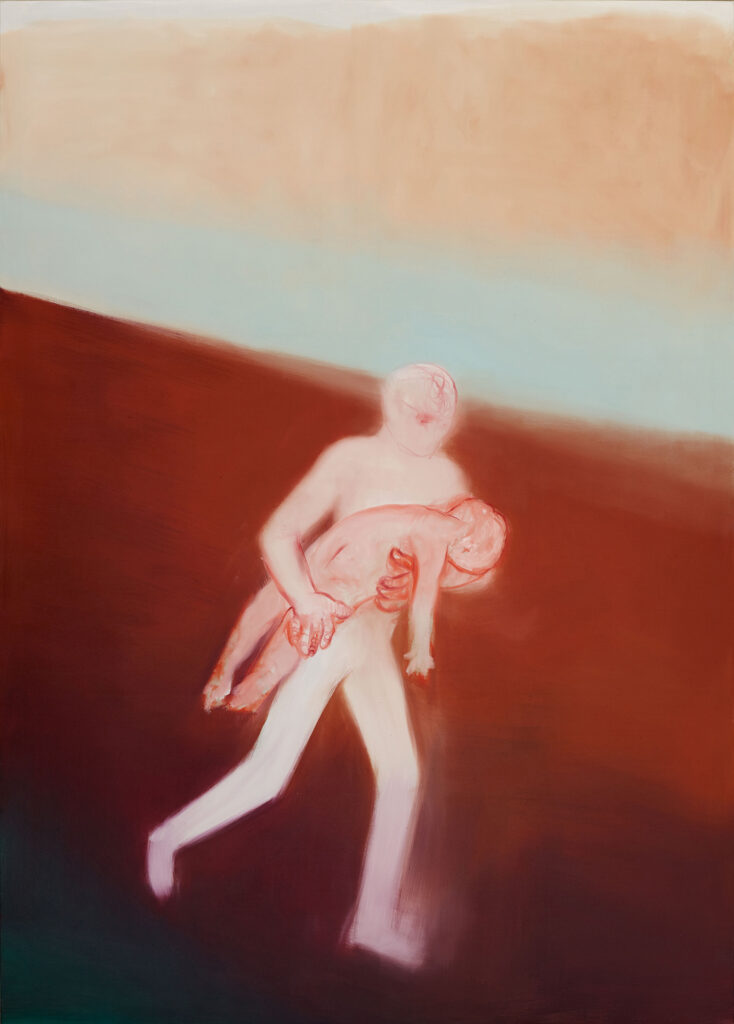
Miriam Cahn, Rennen, 2013
Oil on canvas, 280 x 200 cm
Photo: Reto Pedrini
Courtesy Galerie Jocelyn Wolff, and Meyer Riegger, Berlin/Karlsruhe
As human, Cahn succeeds in portraying everything that attracts us and repulses us and delivering a contemporary take on the world as it is now. When asked her opinion on the world as it is now, Miriam Cahn states “the classical: NO COMMENT!”
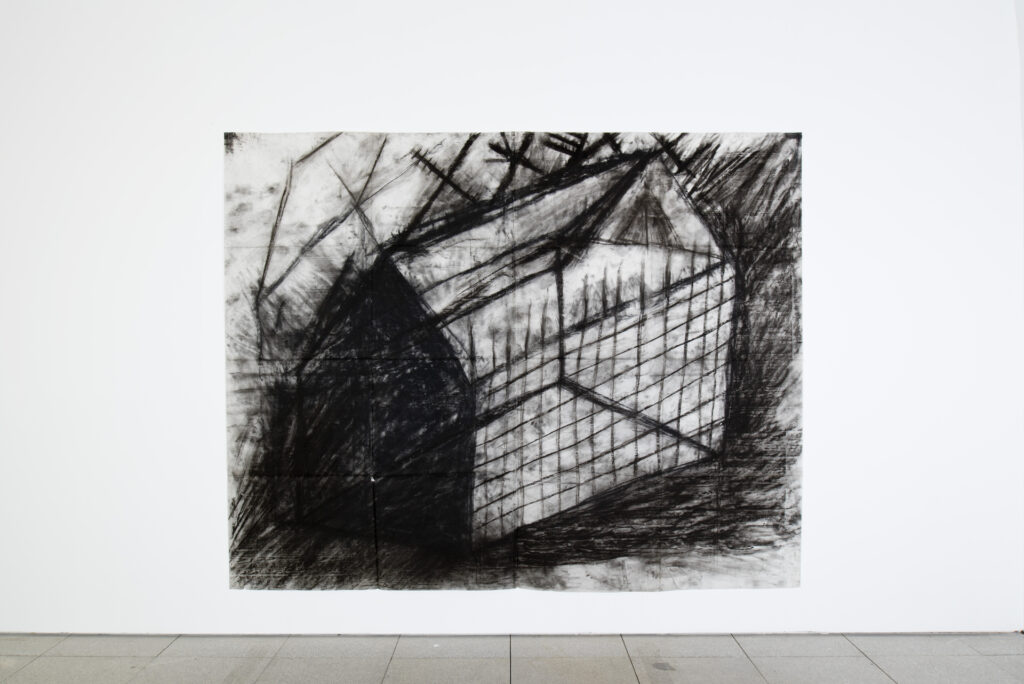
Miriam Cahn, Gitterhaus, 1982
Chalk on paper, 210 x 245 cm
Photo: Oliver Roura
Courtesy Galerie Jocelyn Wolff
Credits
Paintings · Courtesy of Miriam Cahn, Private collections and Galerie Jocelyn Wolff, and Meyer Riegger, Berlin/ Karlsruhe
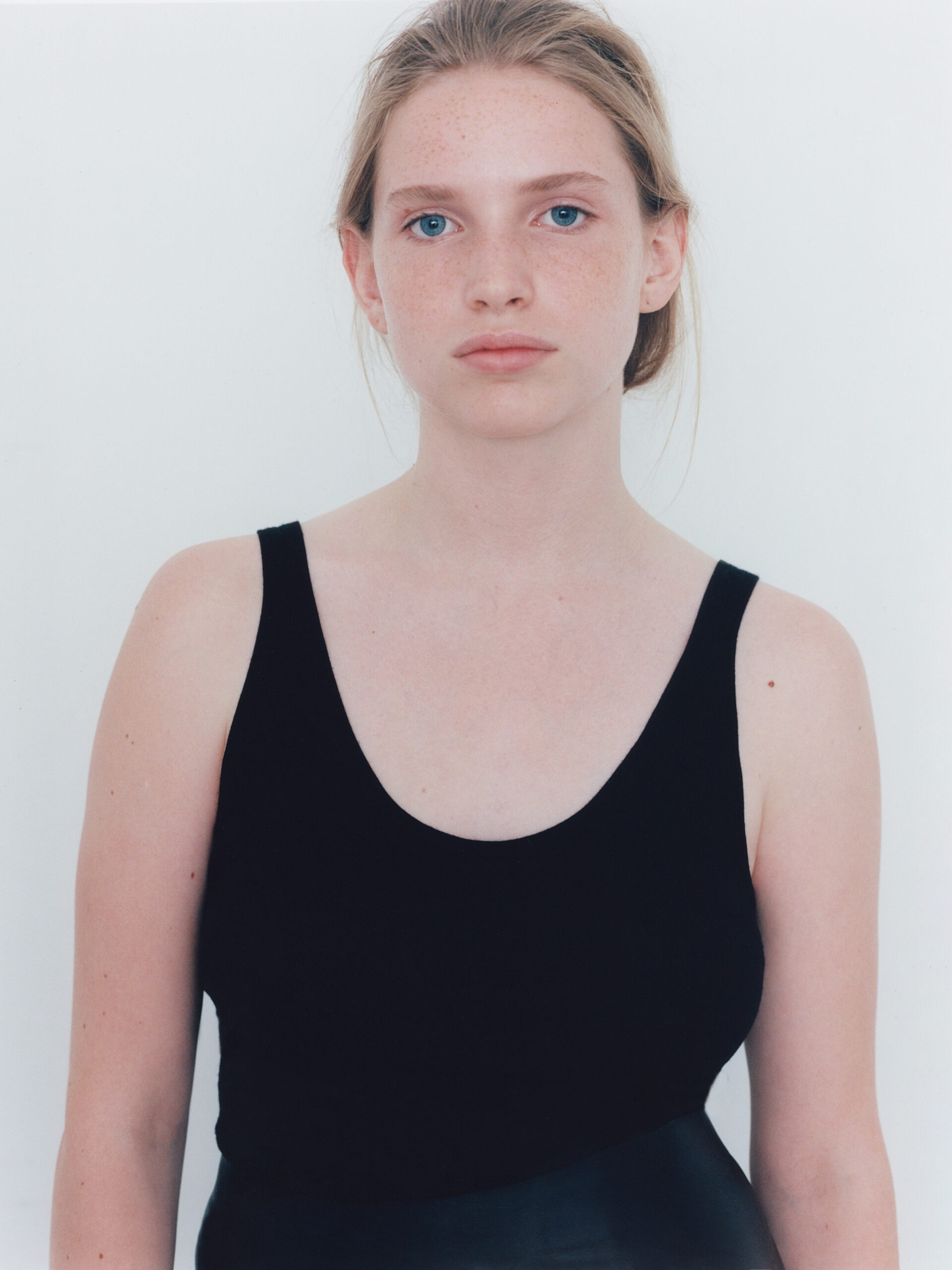
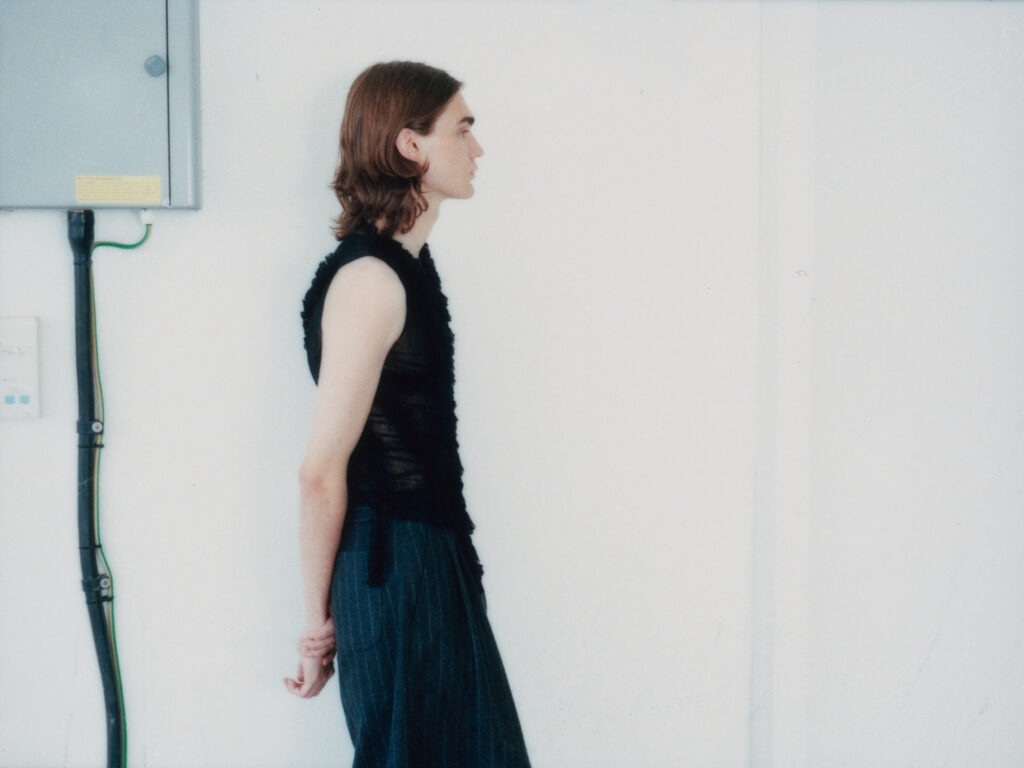
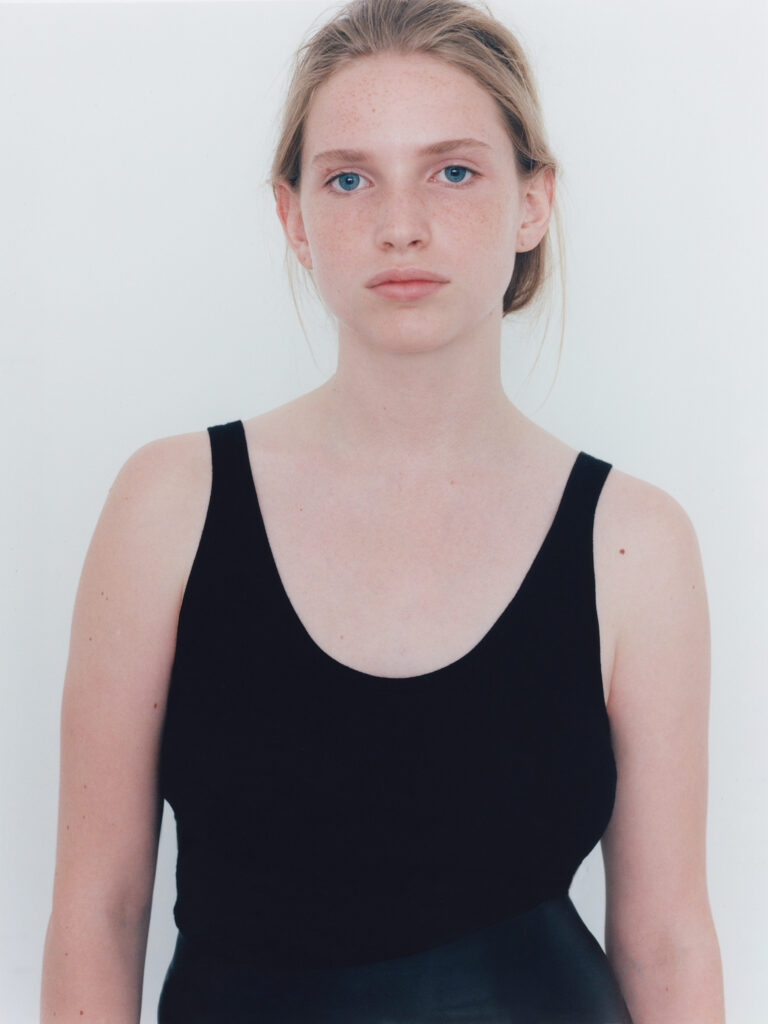
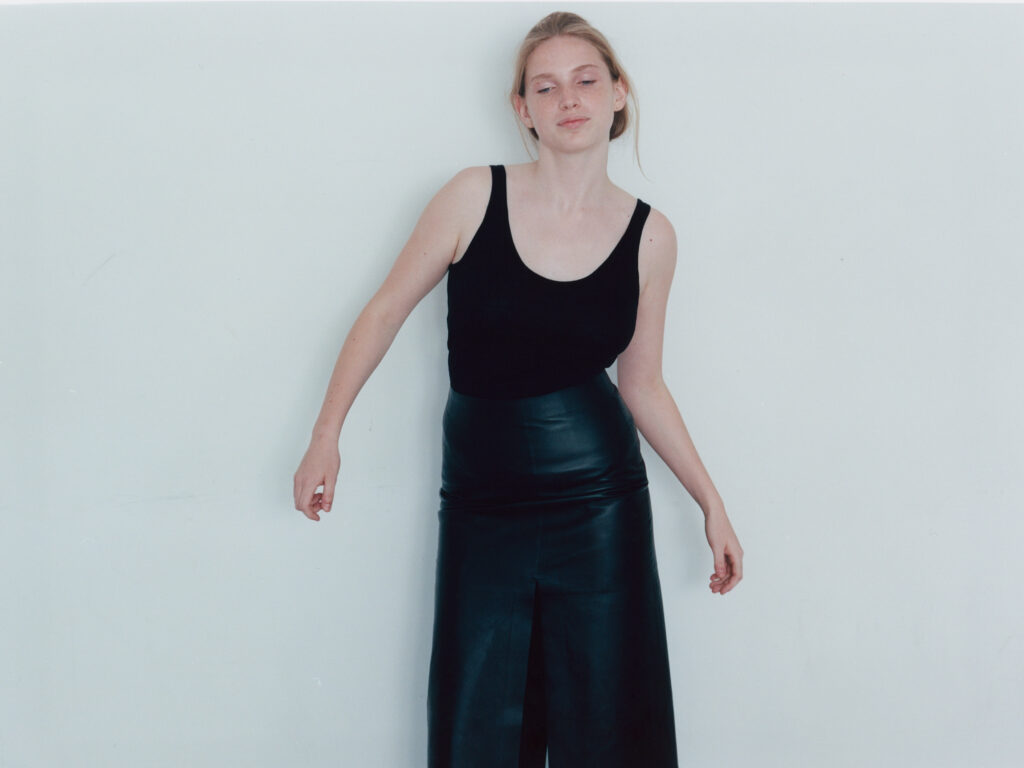
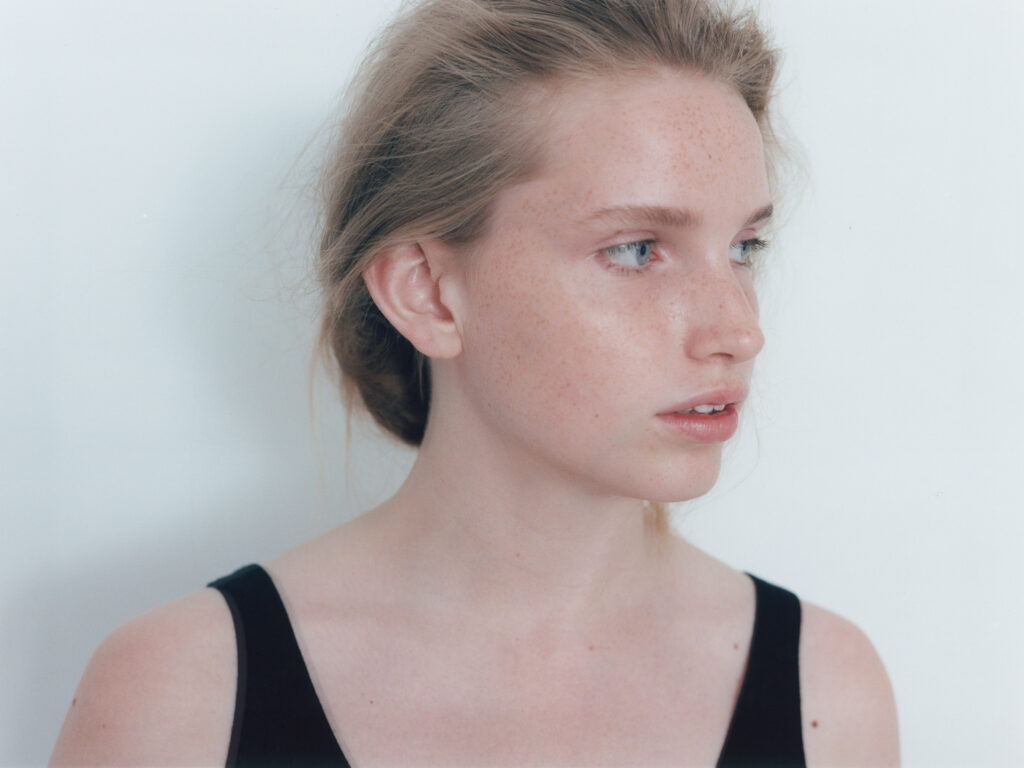
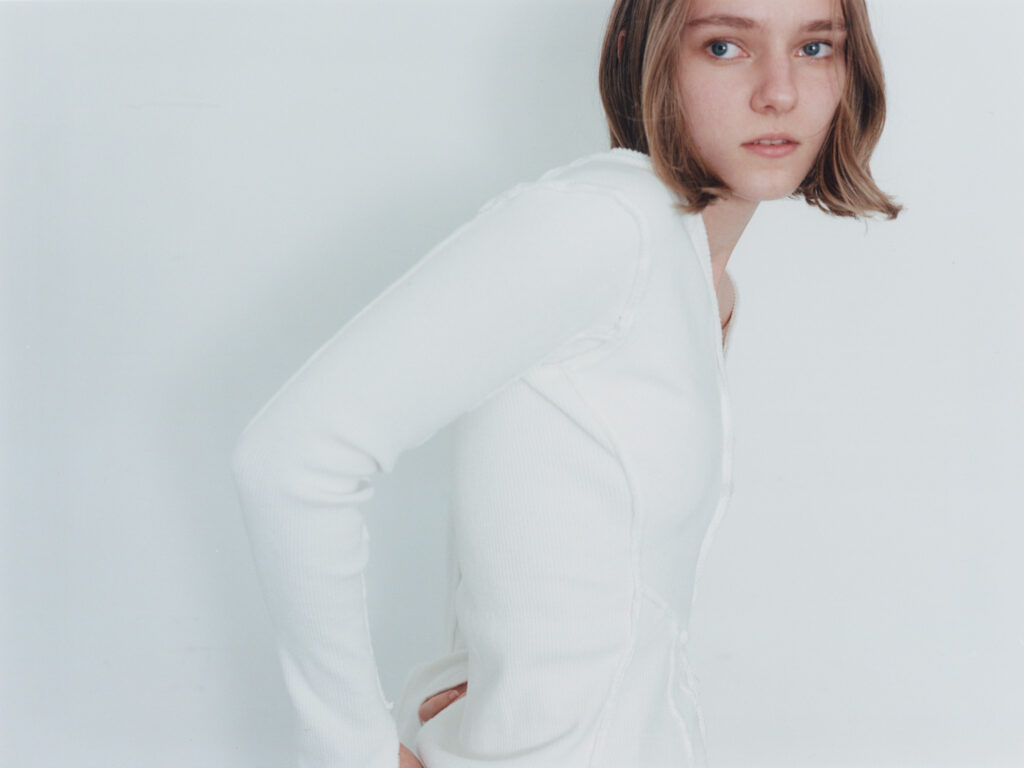
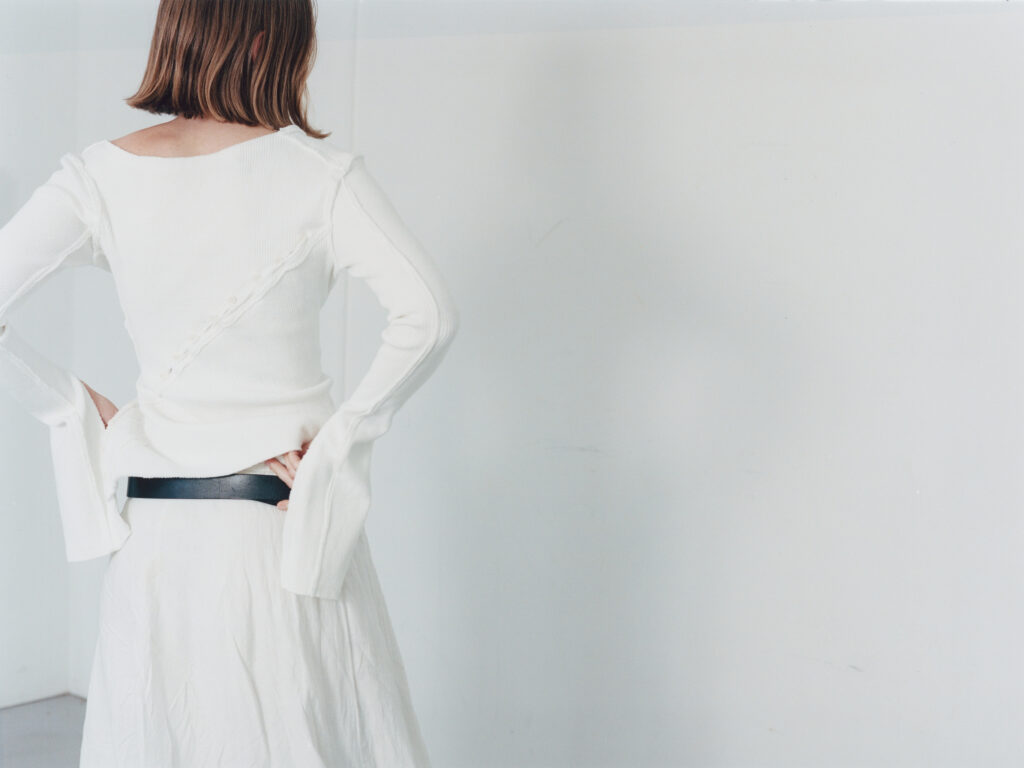
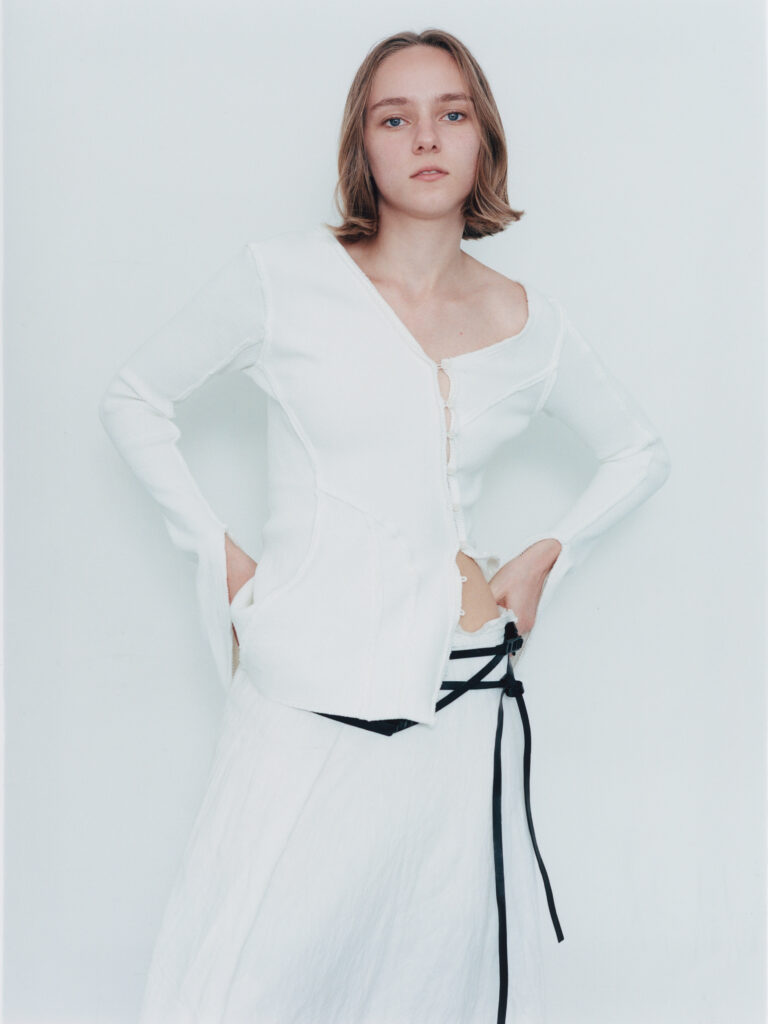
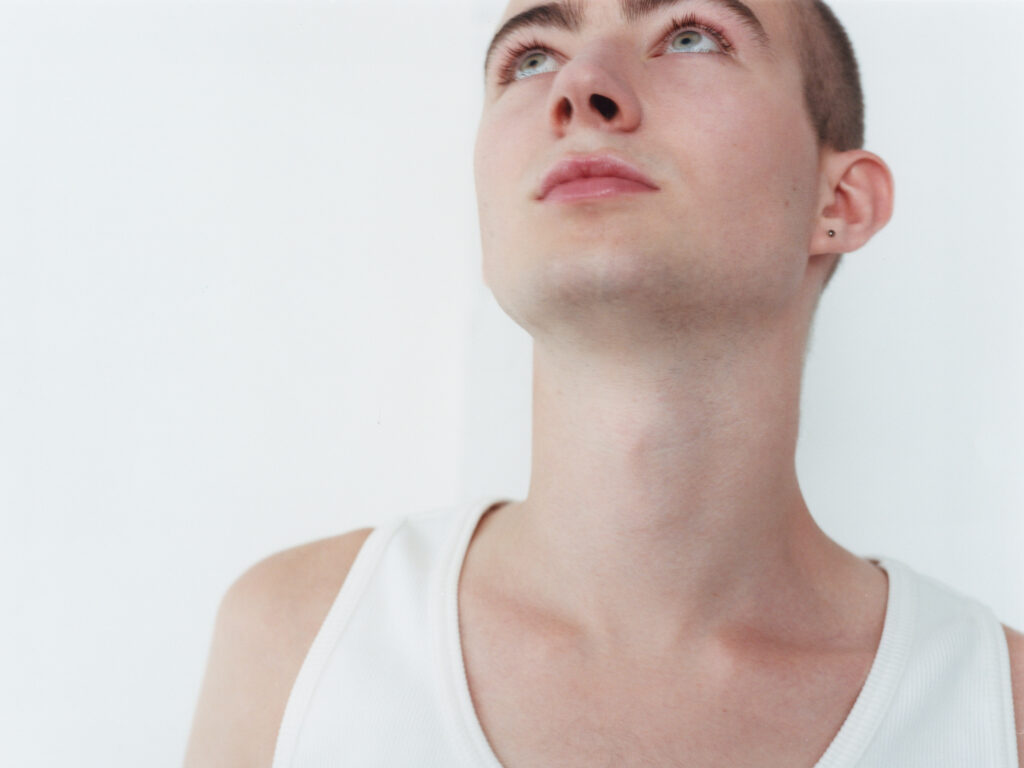
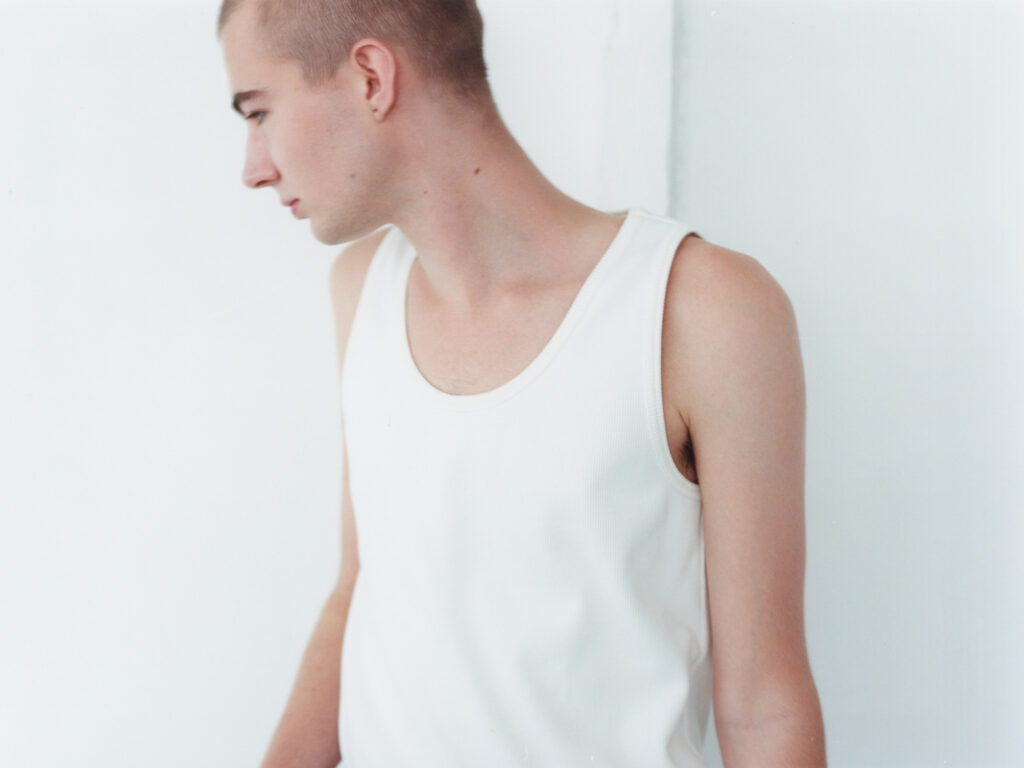
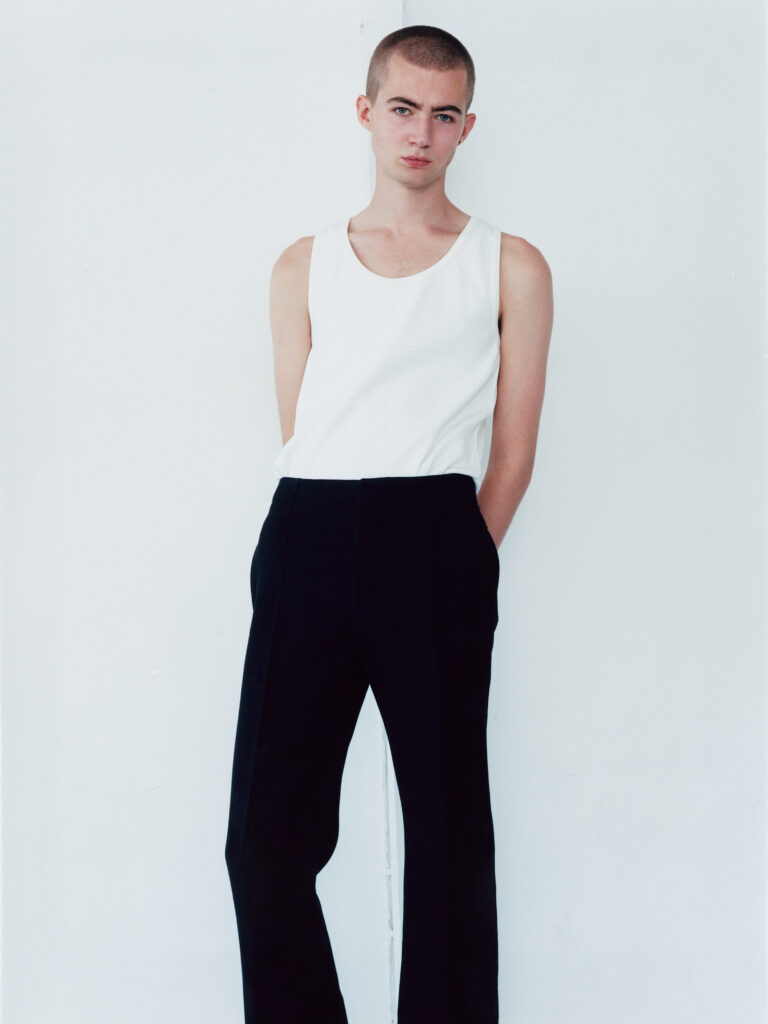
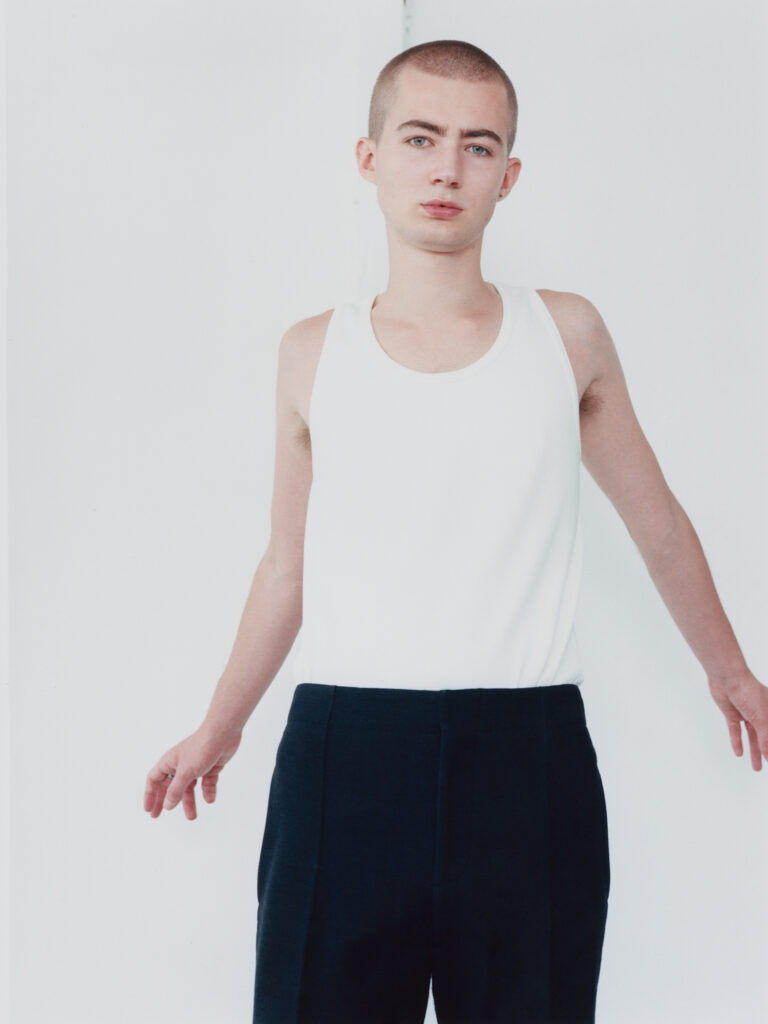
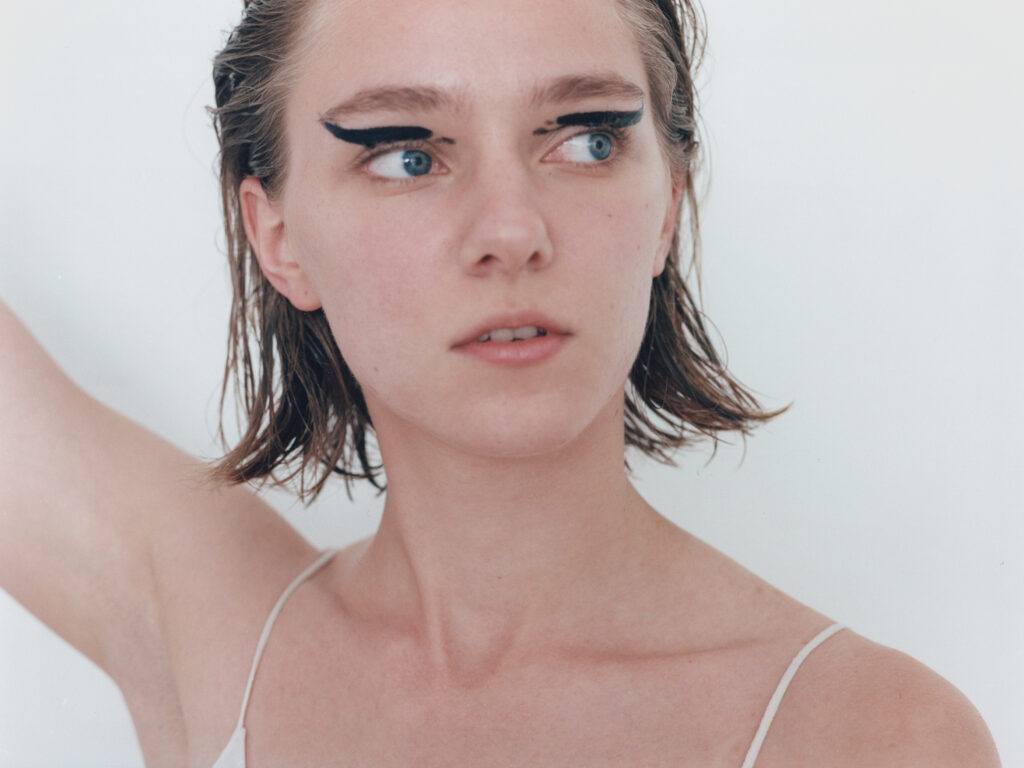
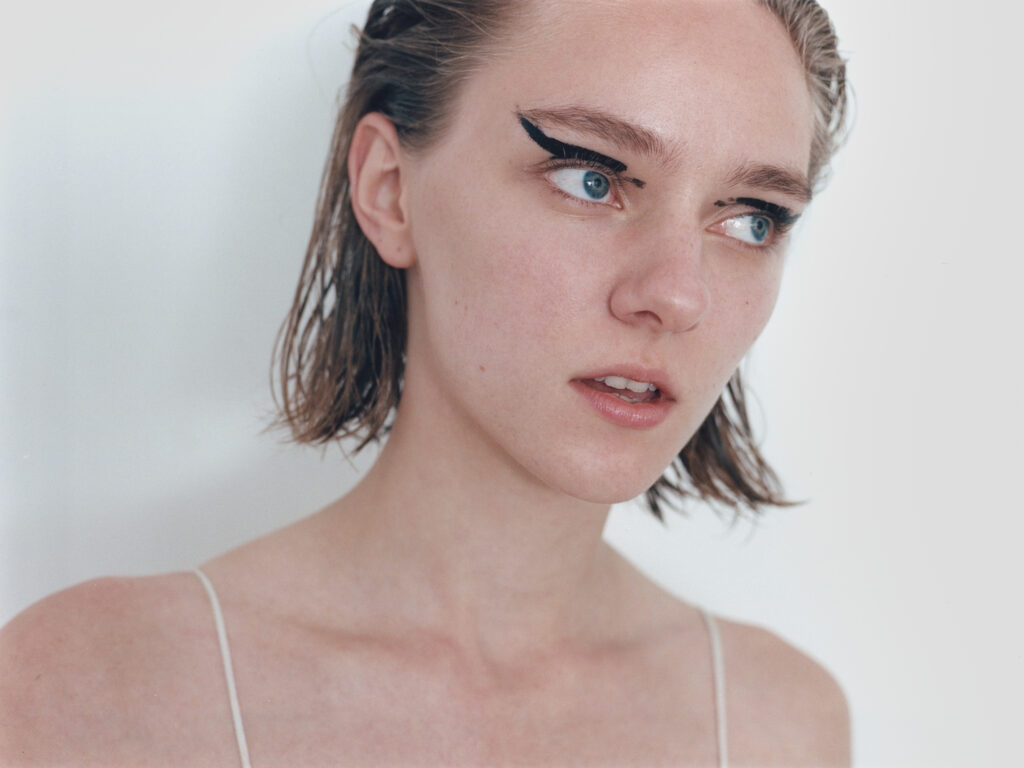
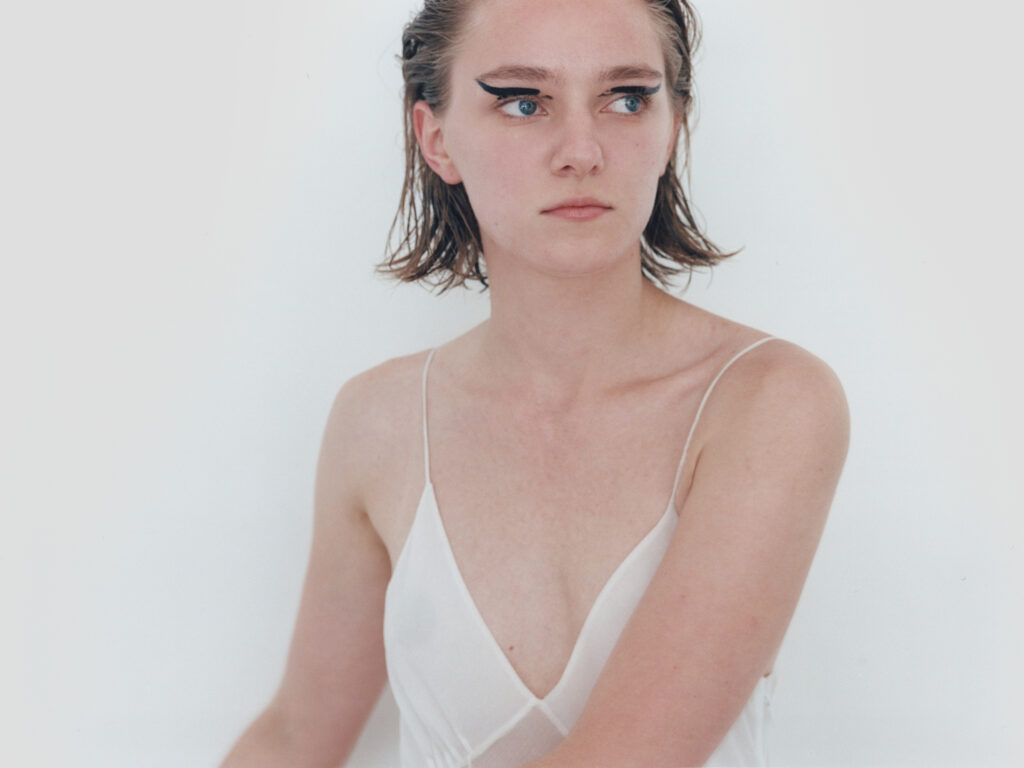
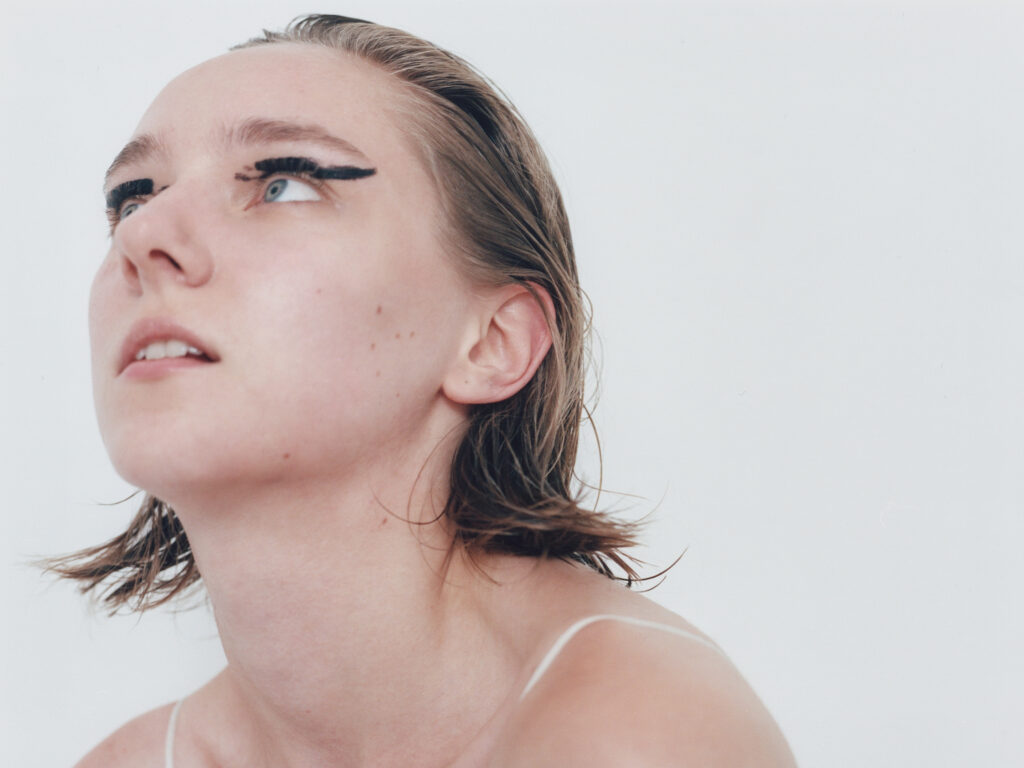
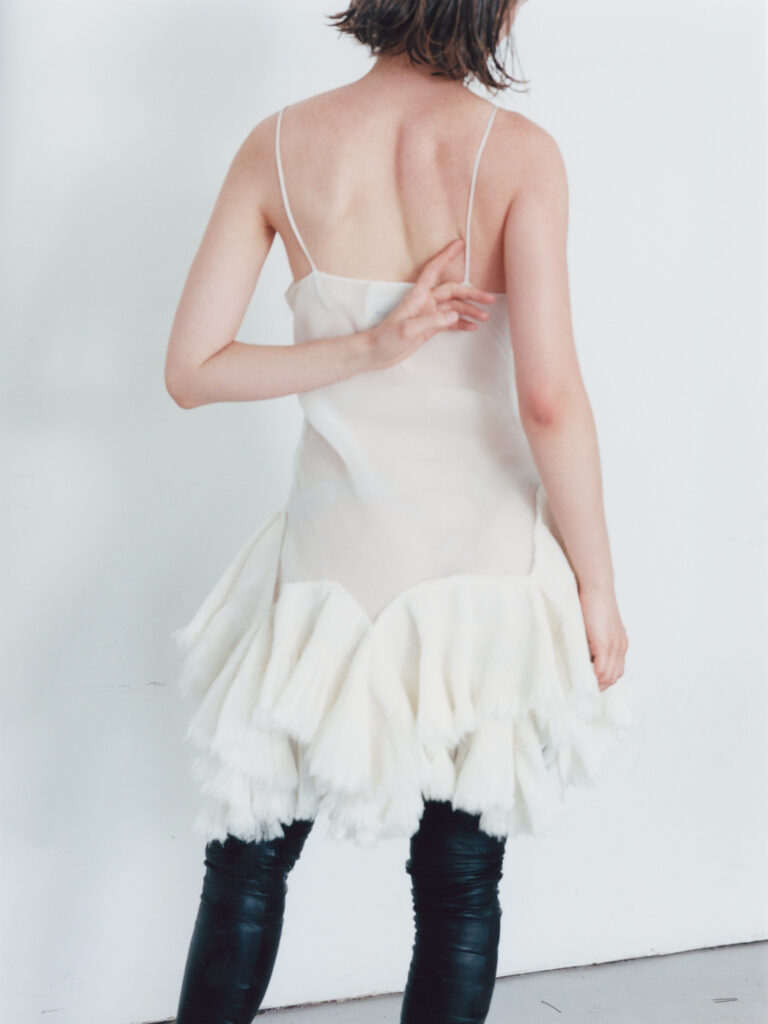
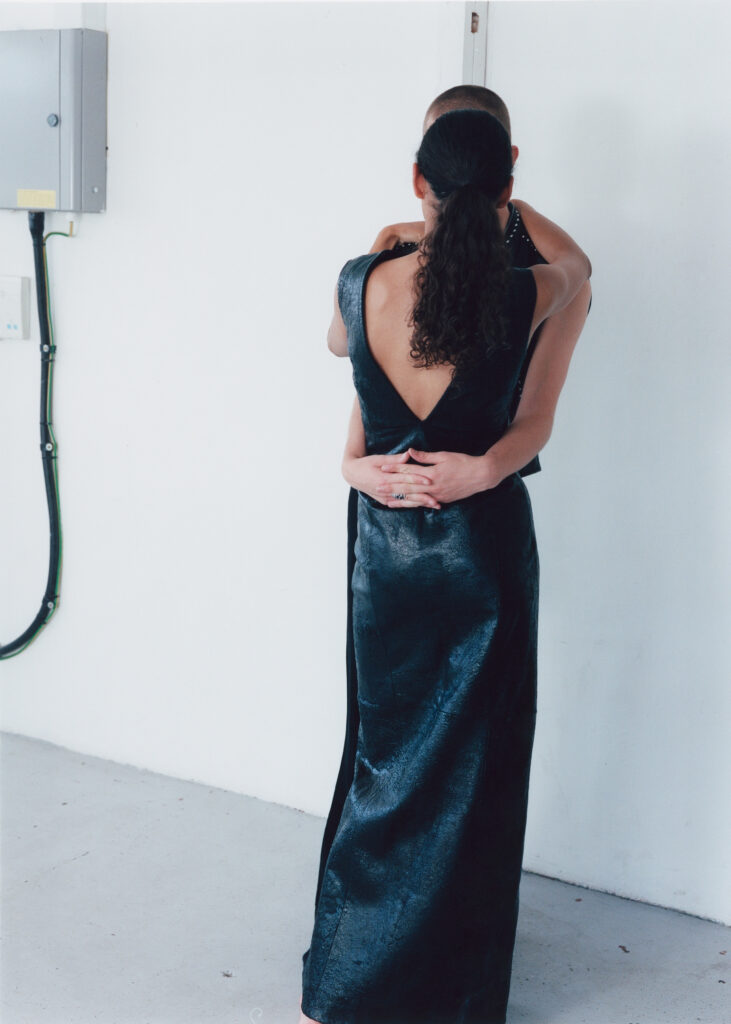
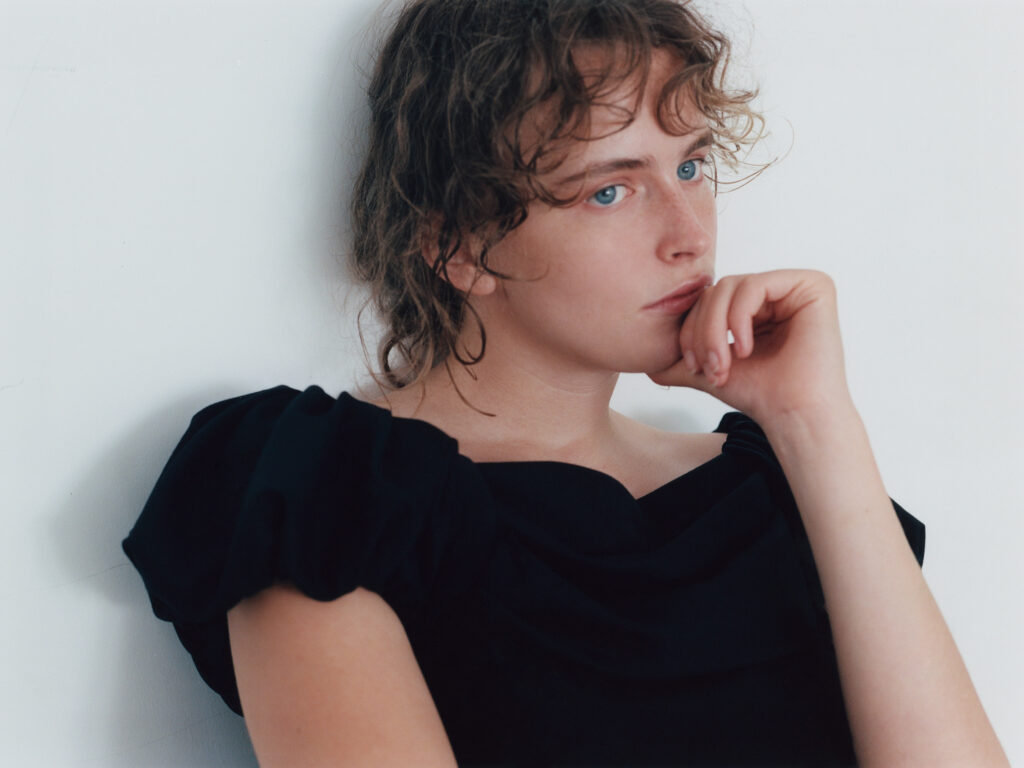

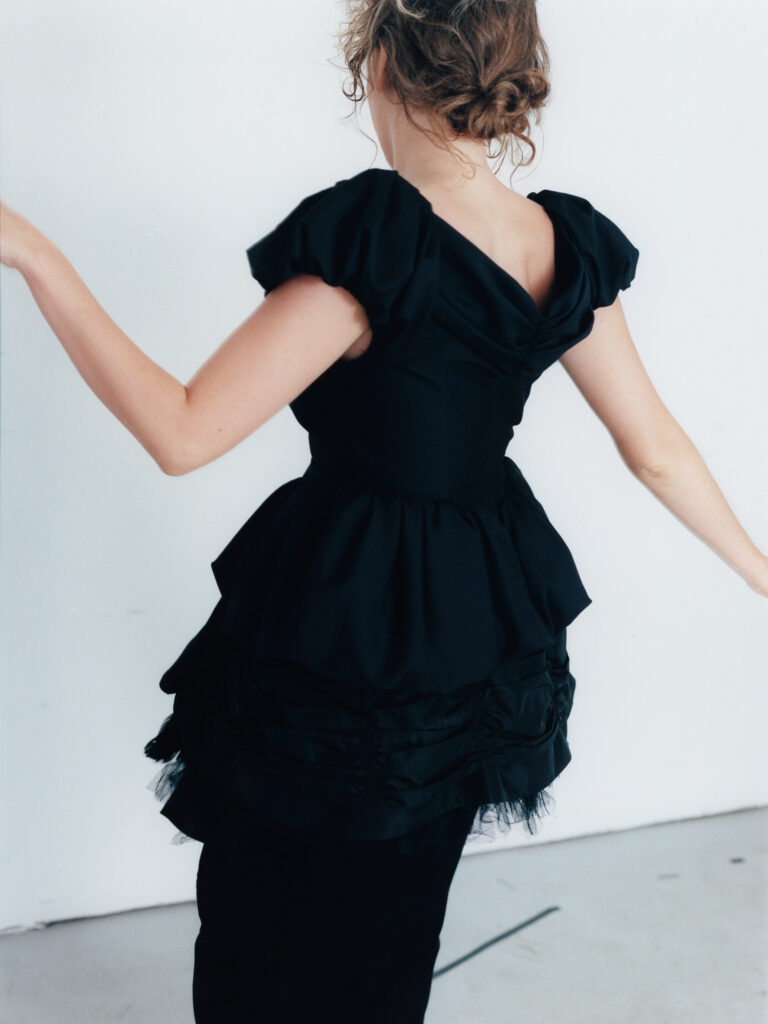
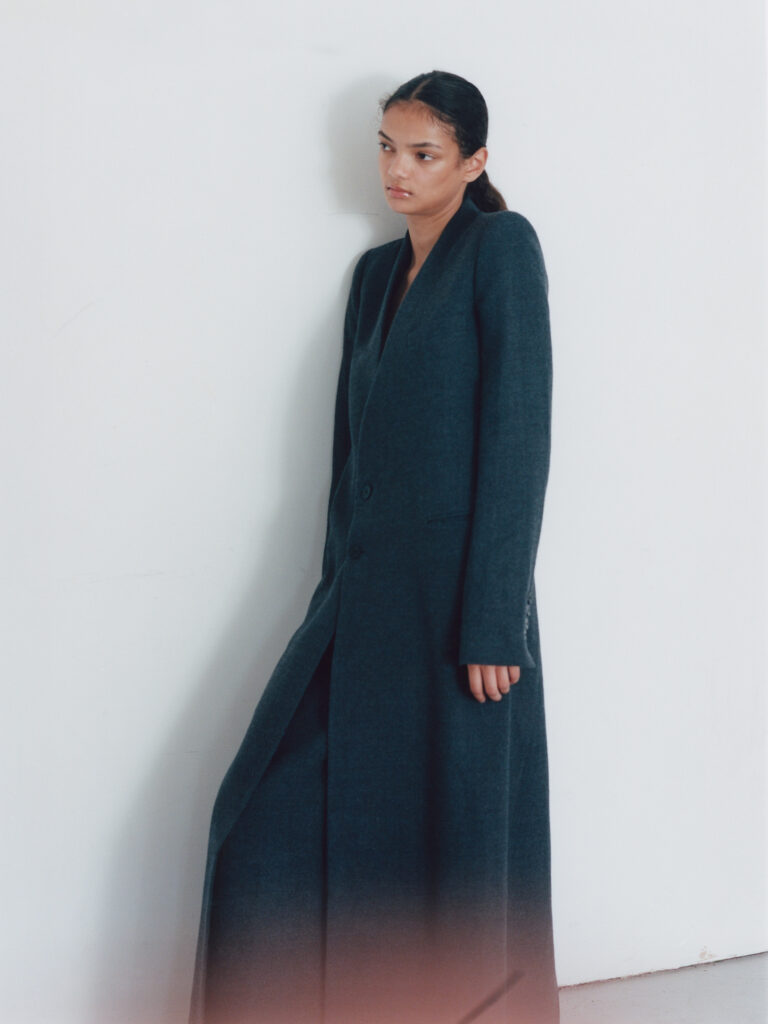
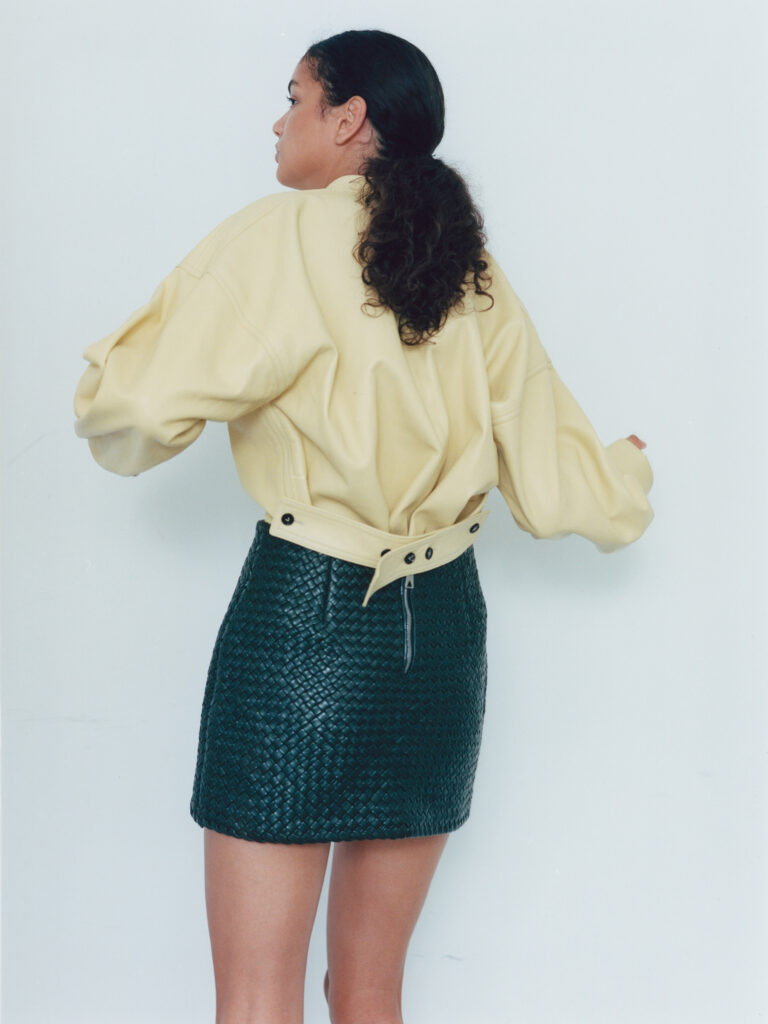
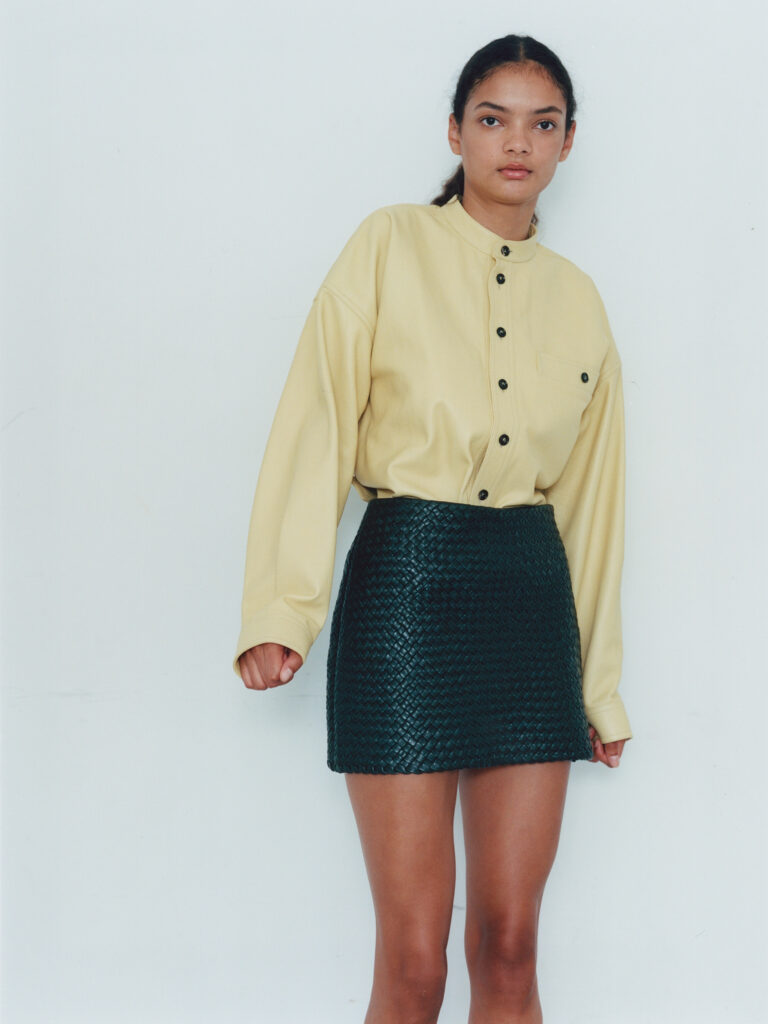
Team
Models · Erin at Emmi Grundström Casting, Giulia Maria Verikas and Thea at Milk Model Management, Louis and Hamish at Elite Models
Photography · Xavier Casanueva
Fashion · Asier Rodriguez
Casting · Julia Lladó
Hair · Takuya Morimoto
Makeup · Takenaka
Designers
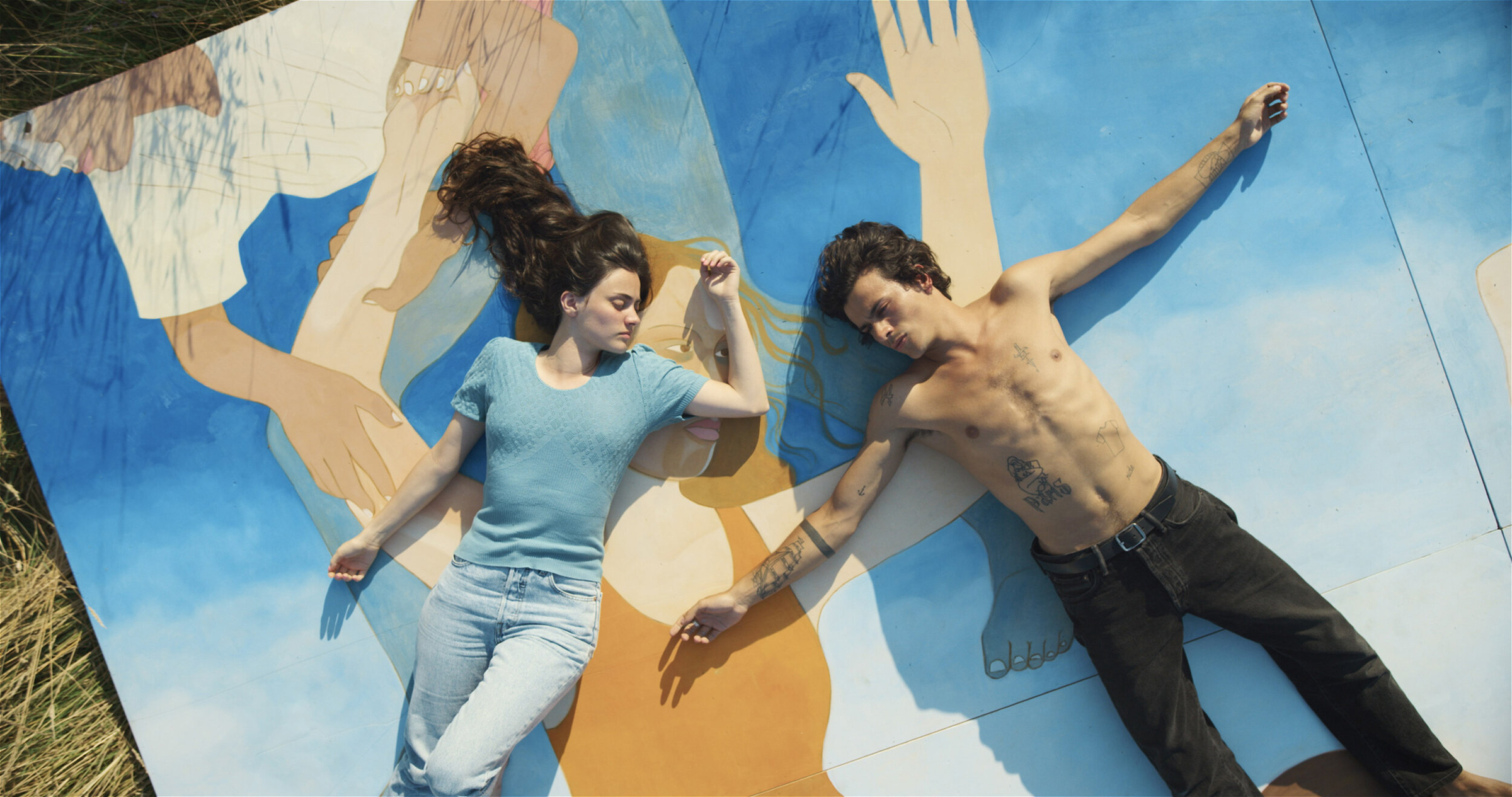

For Neels Castillon, authenticity is integral to his role as a film director and photographer, especially, as he explains on the phone from Paris, in an age of fake news. The dissemination of falsified and fabricated news reportage may not have a direct connection to Castillon, whose clients include Lacoste, Hermès and the French singer, Angèle, but his contention lies with the prevalence of artifice. He sees his role as navigating a balance between capturing the feeling that cinematic visuals can provoke, whilst simultaneously resisting the artificiality those same visuals can carry. There is perhaps no better example of how Castillon meets this feat than in his production company, Motion Palace’s, advertising campaign for kitchen manufacturer, Schmidt. The premise of the advertisement was to have one of Schmidt’s kitchens appearing on a cliff face, demonstrating the brand’s functionality and adaptability. On seeing that the brief was to shoot in a studio with a green screen, Castillon responded that it should be shot for real in the Alps. The ensuing advertisement, and supplementary documentary about the process, are jaw-dropping to watch, as mountaineer Kenton Cool makes himself breakfast in a fully-working kitchen, 6500ft above ground. Castillon refers to the experience as a ‘cool adventure’; the team involved stayed in tents for fifteen days, hiking their way up to the cliffside, and creating an entirely new structure to support the camera from above.
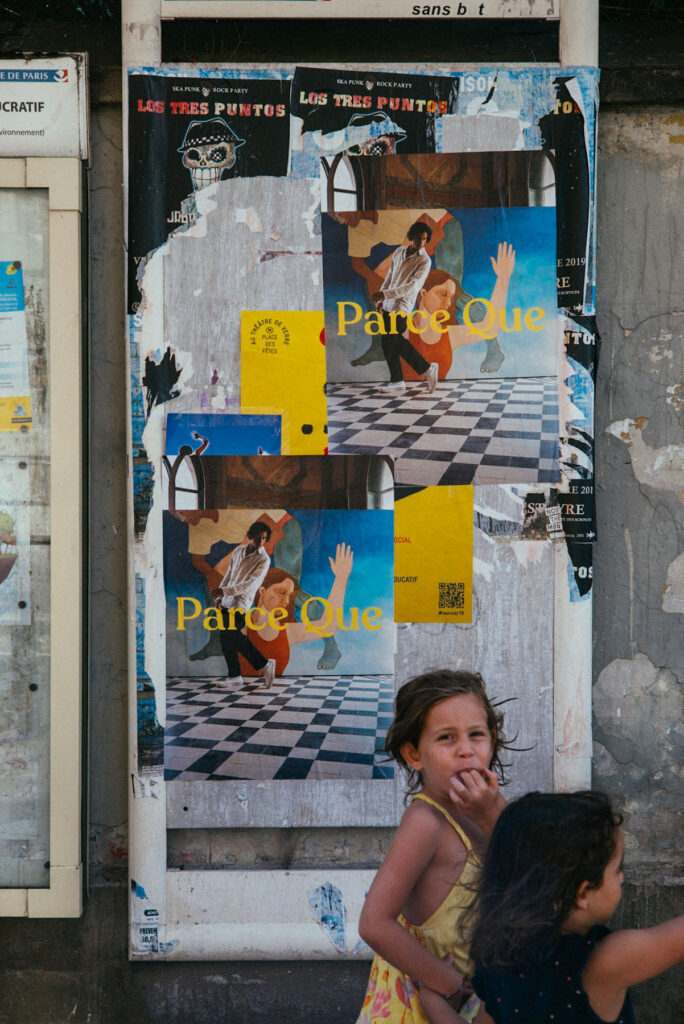
It is through commercial work, like the advertisement for Schmidt, that Motion Palace is able to pursue its more artistic endeavours; ‘It’s in the DNA of my company to produce art stuff with the money we make,’ Castillon explains. As a result, Castillon was able to realise the F Major music video for the neo-classical pianist, Hania Rani, in Iceland earlier this year.
Filmed in a remote location, Hania is seen playing an open-front upright piano – an approach which visually encapsulates the artist’s fascination with the mechanical, organic possibilities that the instrument affords. For the video, Castillon worked with the choreographer, Fanny Sage, and the dancers Mellina Boubetra and Janina Sarantšina, whose interpretations of Hania’s ethereal performance is captured in a single sequence shot. The camera work signals Castillon’s commitment to striving for authenticity; ‘The concept was, how can we translate music that never stops, and keep up this pace?’ So, the camera doesn’t stop either. It was important, too, to translate the sensation of freedom that comes both with Hania’s music and the dancers’ movements – something that the film’s location allowed for. ‘I want to celebrate nature,’ Castillon explains, adding that he strives to capture how a landscape can be inspirational, whilst resisting the urge to just create picture postcards of the scenery. The backdrop of mountains and black sand in F Major have the potential to be just that; awe-inspiring and spectacular in itself. But, as the chilling wind that entraps Hania and the dancers in the video confirms, the logistics of F Major were anything but straightforward. ‘As you can see, there was an ice storm,’ Castillon points out; ‘It was very cold, like minus seven degrees. We rehearsed a lot before but, on set on the beach we only had three takes because of the light and the weather.’ Not only was the filming testament to Castillon’s approach to taking on a challenge, but also his dedication to fully realising the potential of the performers he works with.
Castillon discovered Hania Rani through her record label, Gondwana Records: ‘I like pretty much all the artists they have in their roster, so when I listened to her first album (2019’s Esja) I was totally in love.’ At the time Castillon reached out to Hania, she was writing her second album, Home, but she had seen Castillon’s 2017 film, Isola with the dancer Léo Walk, and wanted to work together. Their collaboration was postponed to allow time for Castillon to raise money and for Hania to complete the album. This time also gave Castillon the chance to work out the concept for their work; ‘I listened to [F Major] maybe 200 times before coming up with the idea.’ He was also keen to ensure he attended every rehearsal and discuss the concept with the dancers; the process is ‘almost a co-creation,’ Castillon explains, like ‘ping-pong.’ It’s a constructive and collaborative process of back-and-forths to find a way that Castillon can capture the performance in the best possible way. His work with Hania may have been a while in the making, but that seems to be the case with a lot of Castillon’s collaborations.
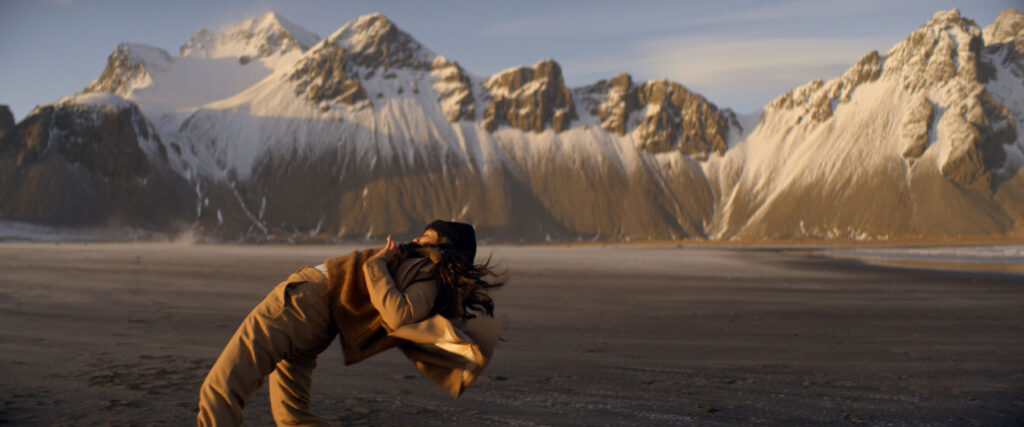
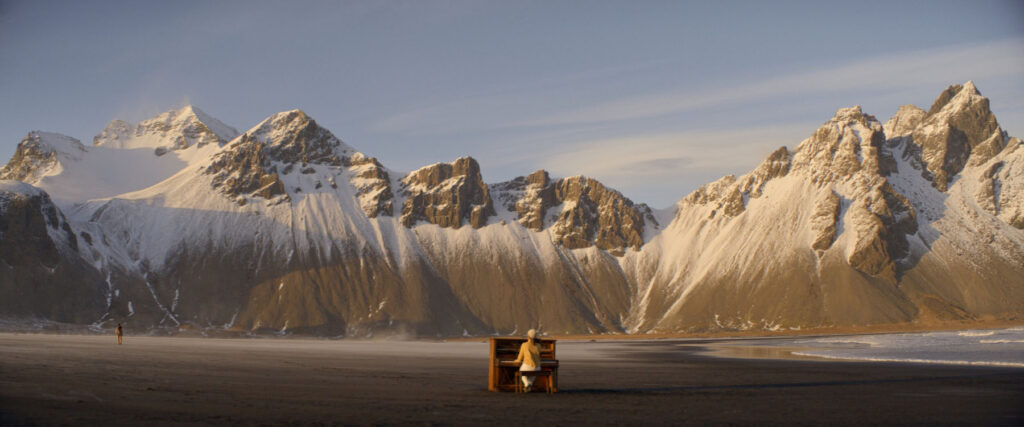
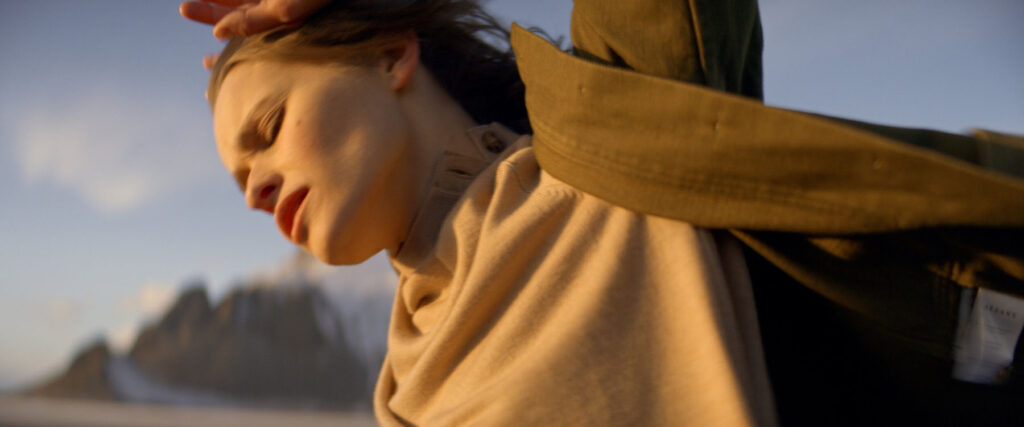
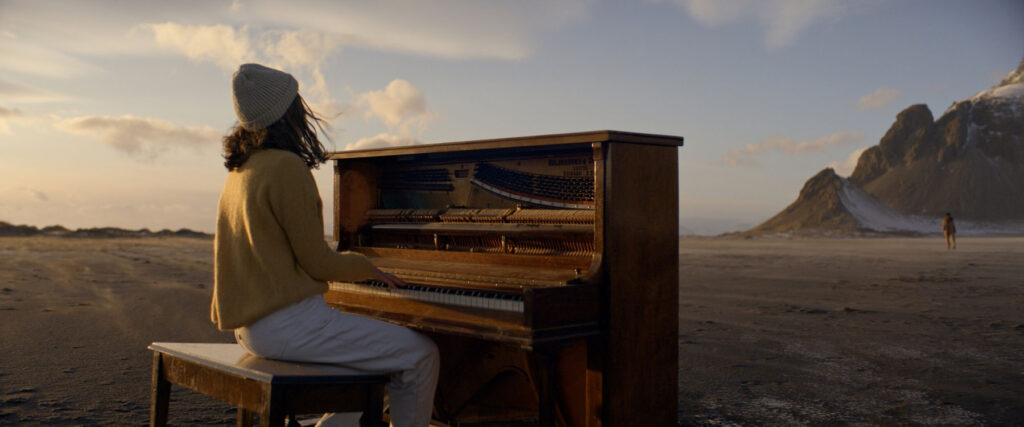
Stills from Hania Rani’s F Major music video
There is a sense, talking to Castillon, that he uses his films to capture the creative endeavours of those he knows and admires – and in turn, to introduce them to one another in the name of collaboration. That was the case for last year’s short film, Parce Que, featuring the painter, Inès Longevial, and Léo Walk. Inès, like Hania after her, had seen Isola and was keen to work with Léo who, similarly, loved the painter’s work. Castillon had known Inès for a number of years previously and was waiting for the perfect opportunity to work together, which Parce Que would be – but it took ‘almost a year to find a time when [Léo and Inès] were both available.’ The idea was to combine painting and dance together, but Castillon was wary of avoiding the pitfalls of an ‘arty cliché’. With Serge Gainsbourg’s song Parce Que as the film’s soundtrack, the dangers of doing something cliché could be high, but Castillon managed to pull it off. That success is demonstrative of the director’s integrity when it comes to understanding the performers he works with. It was important that the location choice for Parce Que would be able to accommodate Léo’s dancing, which, as he explains in reference to Isola, requires a smooth enough surface to allow for some of the breakdancing moves. As the film, which tells the story of love and, eventually heartbreak, progresses, Léo dances on a six by four metre painting that Inès is depicted as working on; Castillon’s way of combining the creative skill of both collaborators, and avoiding the cliché of something ‘that has already been seen before’.
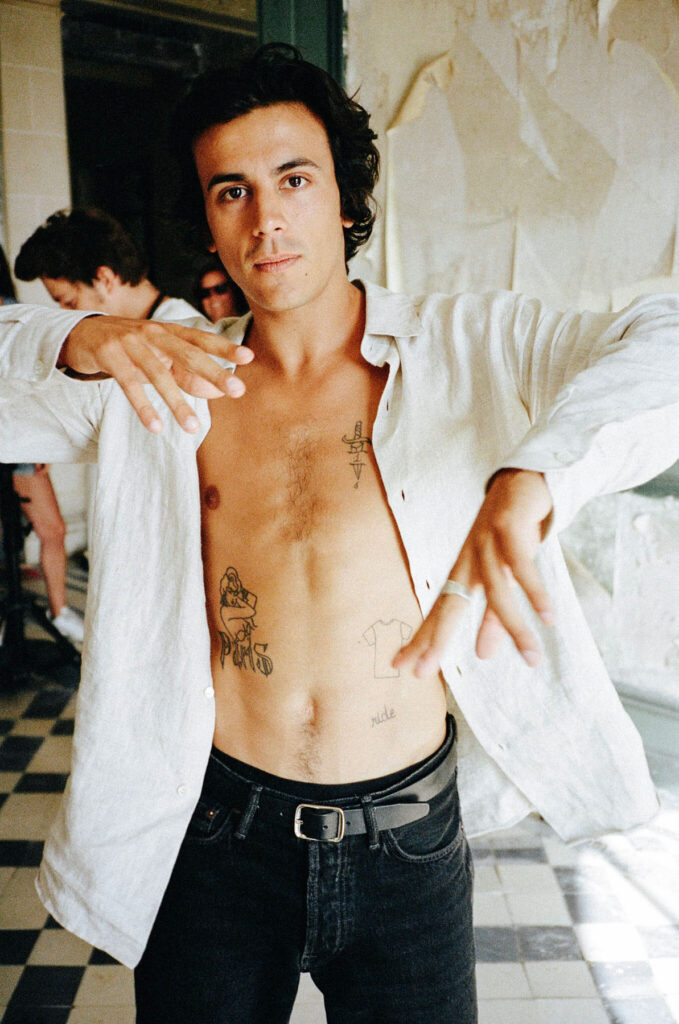
Léo Walk on the set of Parce Que
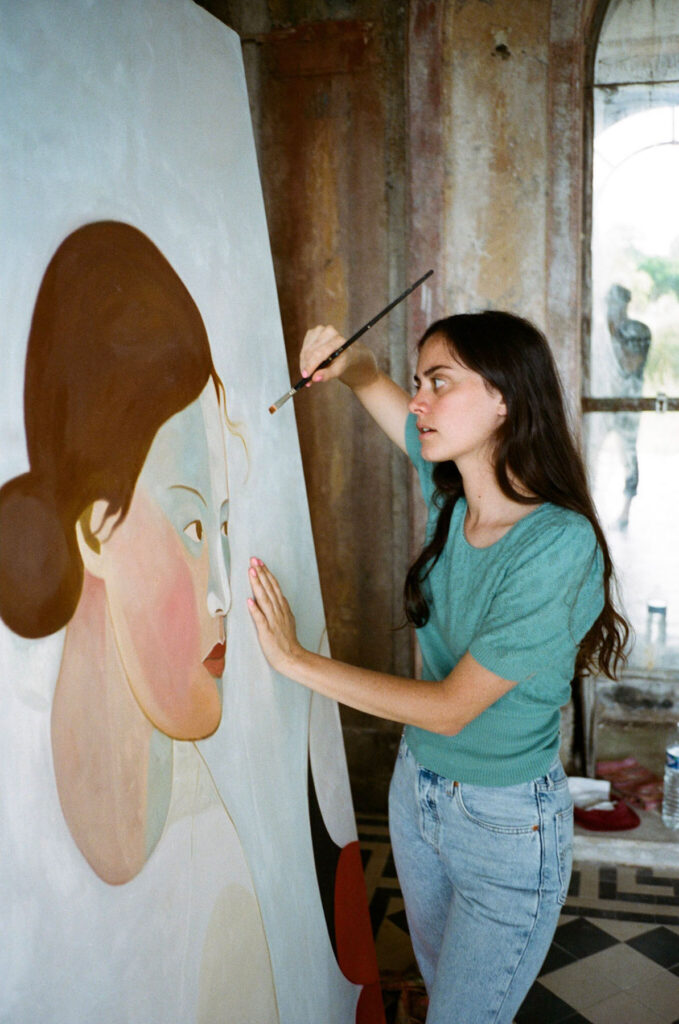
Inès Longevial on the set of Parce Que
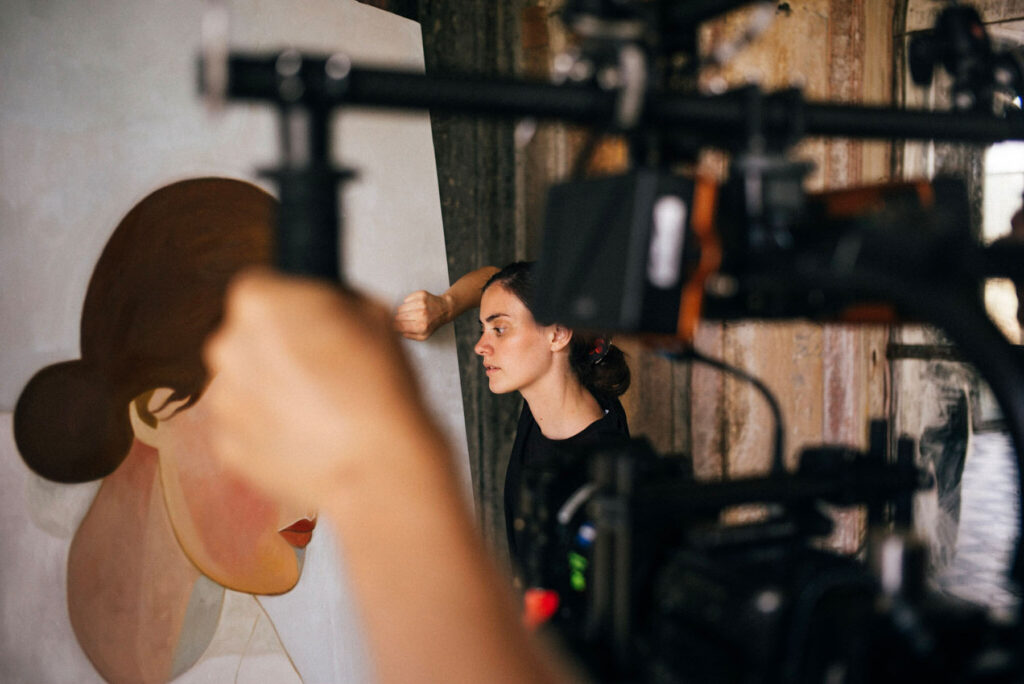
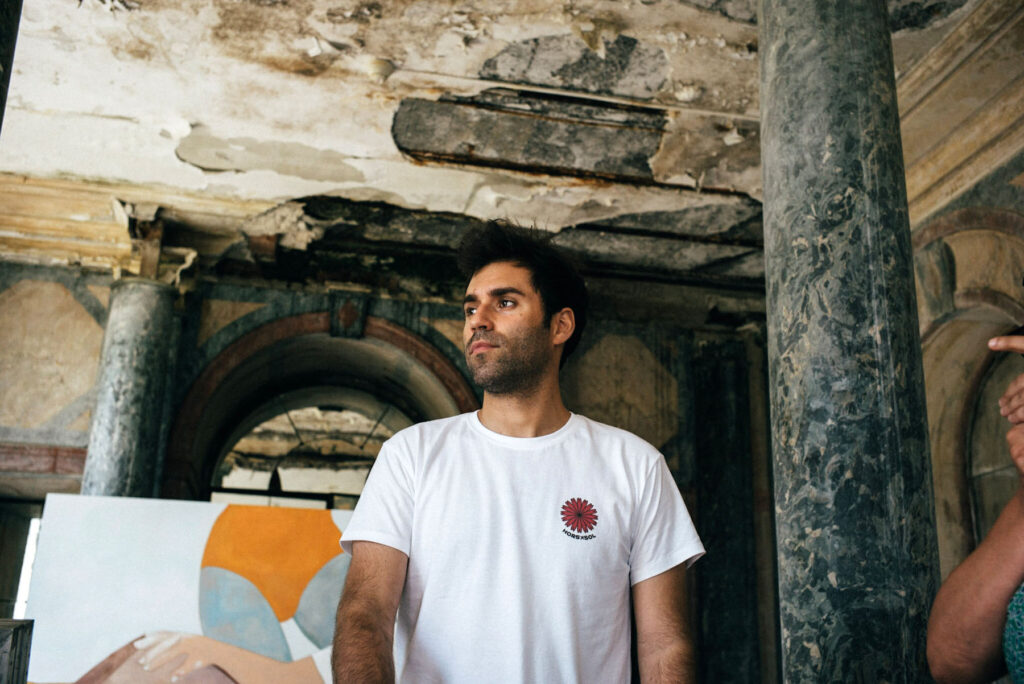
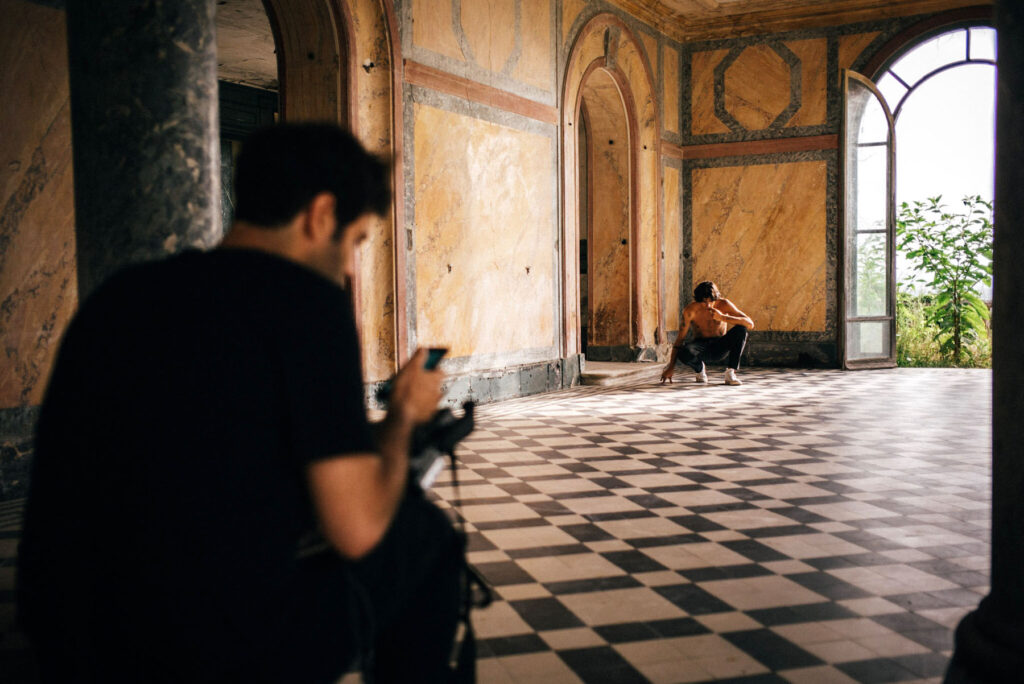
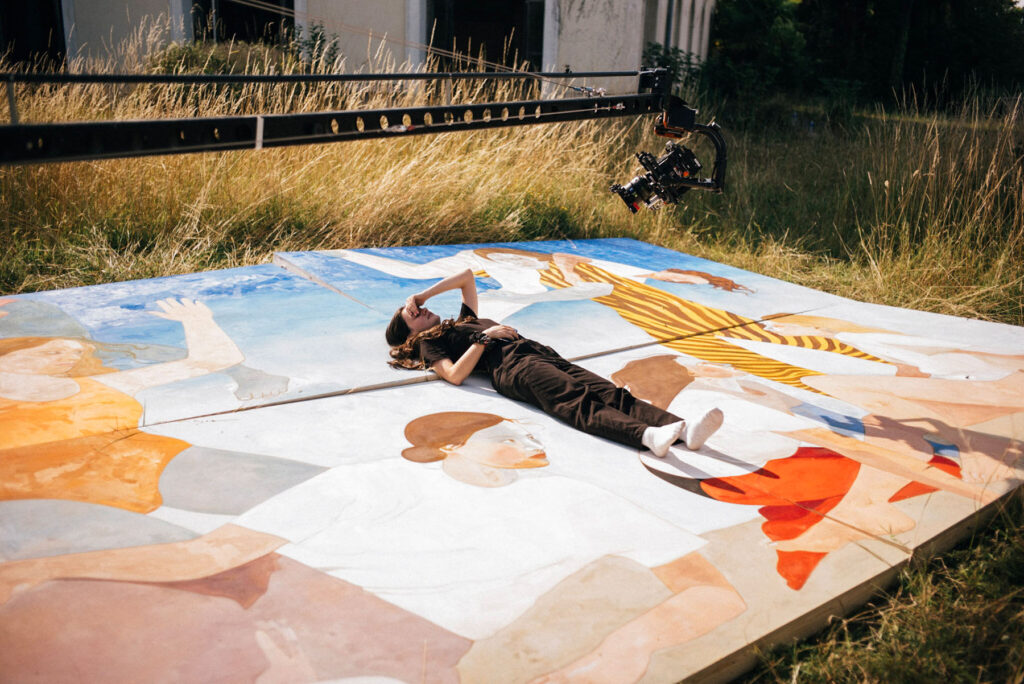
As with the Schimdt advertisement and the F Major video, Parce Que shows that Castillon is a master at pulling of impressive operations. ‘It’s what I love,’ he enthuses, ‘sometimes you have a crazy idea like, “What if Léo dances on a big painting?” And one year later, you are shooting it. Like, okay – it’s worth it.’ A special frame was made for Inès’s painting, which was kept in four parts in a friend’s shop in Paris because, as Castillon explains, ‘the apartments are very tiny’, before being transported to a secret location in the South of France for filming. A delipidated castle near Biarritz was chosen in part because the location reminded Inès of her childhood and also because Castillon liked its uniqueness. It had been designed by a woman at the turn of the twentieth century, who had taken inspiration from far and wide including, amongst other references, Versailles. Castillon is careful not to disclose the exact location of the castle because of the fragile state that the building is now in; the team spent two days clearing the site of detritus before filming and filmed quickly to cause as little damage as possible. There is, then, a sense of nostalgia that infuses Parce Que – a longing for lost love, a reminder of childhood and memory of times gone by.
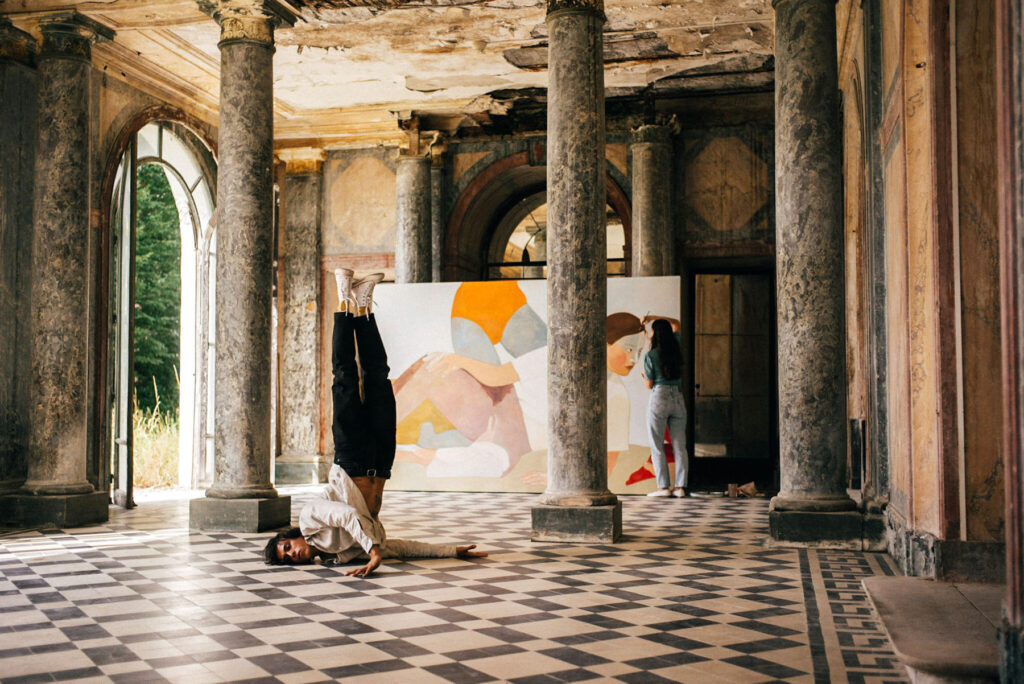
Personal connections prove important to Castillon, perhaps another explanation for how he avoids clichés. During the location scouts for Isola, it occurred to Castillon that he knew exactly the place to film. Castillon grew up in Sardinia; he remembers a deserted building near a beach he used to frequent with his grandmother, which would become the ‘perfect place’ to film. He describes the place as surreal, the light there reminding him of an Edward Hopper painting. The experience of watching Isola feels similar to viewing a painting by Edward Hopper, too. To see Léo perform, at first refracting the haze of the summer sun and, later, his movements lit up by the warm glow of sundown, it is possible to feel connected to him in his solitude. Isola grants the opportunity to be close to Léo precisely because Castillon is conscientiously aware of the viewer. One of the director’s earlier videos, La République du Skateboard, came from the desire to capture a scene close to Castillon’s heart. As a skateboarder from the age of ten, Castillon started making skate videos using filming techniques common to the scene, ‘fisheyes, long lens – pretty dirty stuff.’ But, he decided to make a film that was more cinematic, taking influence from the classic movies that helped him learn the filming techniques he employs today. The film, about skateboarding and, skateboarding in Paris in particular, was envisioned as something that anyone could watch. The result is an ode to the scene and the city, beautifully shot, as would be expected from Castillon’s work, and accessible too. ‘I didn’t want to make something that only speaks to experts,’ the director explains. ‘I wanted to translate it in a way that is universal so that everyone can watch and understand why it’s beautiful.’ That same philosophy is applied to dance; ‘I’m not interested in making dance videos that only a few people can understand’, Castillon says of his approach. Rather, he wants to ‘find a perfect balance between the popular and the artistic.’
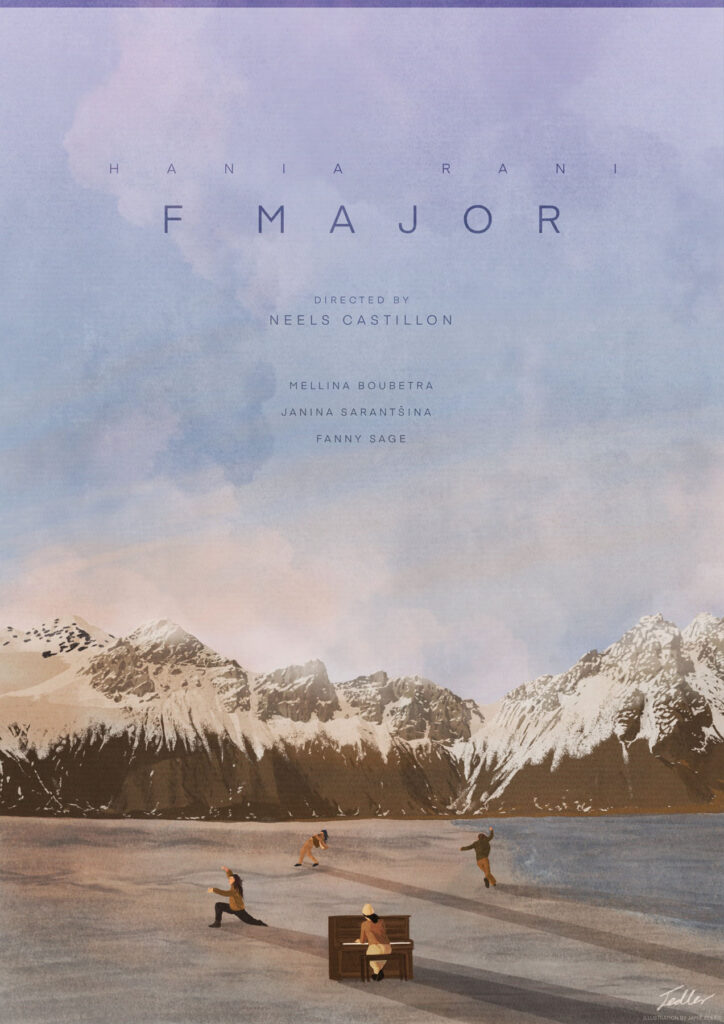
At its core, Castillon’s role as a director could be understood as transforming his fascination for performers into nuanced films that combine a highly cinematic approach with a deep respect for artistic craft. He says that he is fascinated by artists like Léo Walk and Fanny Sage, and this fascination inspires him to tell their stories. It’s somewhat telling that Castillon describes himself as someone who ‘cannot create a whole universe from nothing’. Rather, he thrives on the collaborative process that comes with the way he instinctively works. Just as he brings up fakes news as the anthesis of his search for authenticity, Castillon describes a ‘kind of boredom’ that comes with the saturation of content on platforms like Instagram and Netflix. He is resolutely not interested in making films that have been done before. That said, Castillon’s upcoming release sees the director return to Iceland with Fanny Sage for a second film; the music is by the French artist, Awir Leon, who, not surprisingly, Castillon claims to love. He describes the short film, called 間 (Ma), as ‘mind-blowing’ – and it’s a project that he seems immensely proud of. When it premieres on June 29th on Nowness, it’s more than likely worth watching.
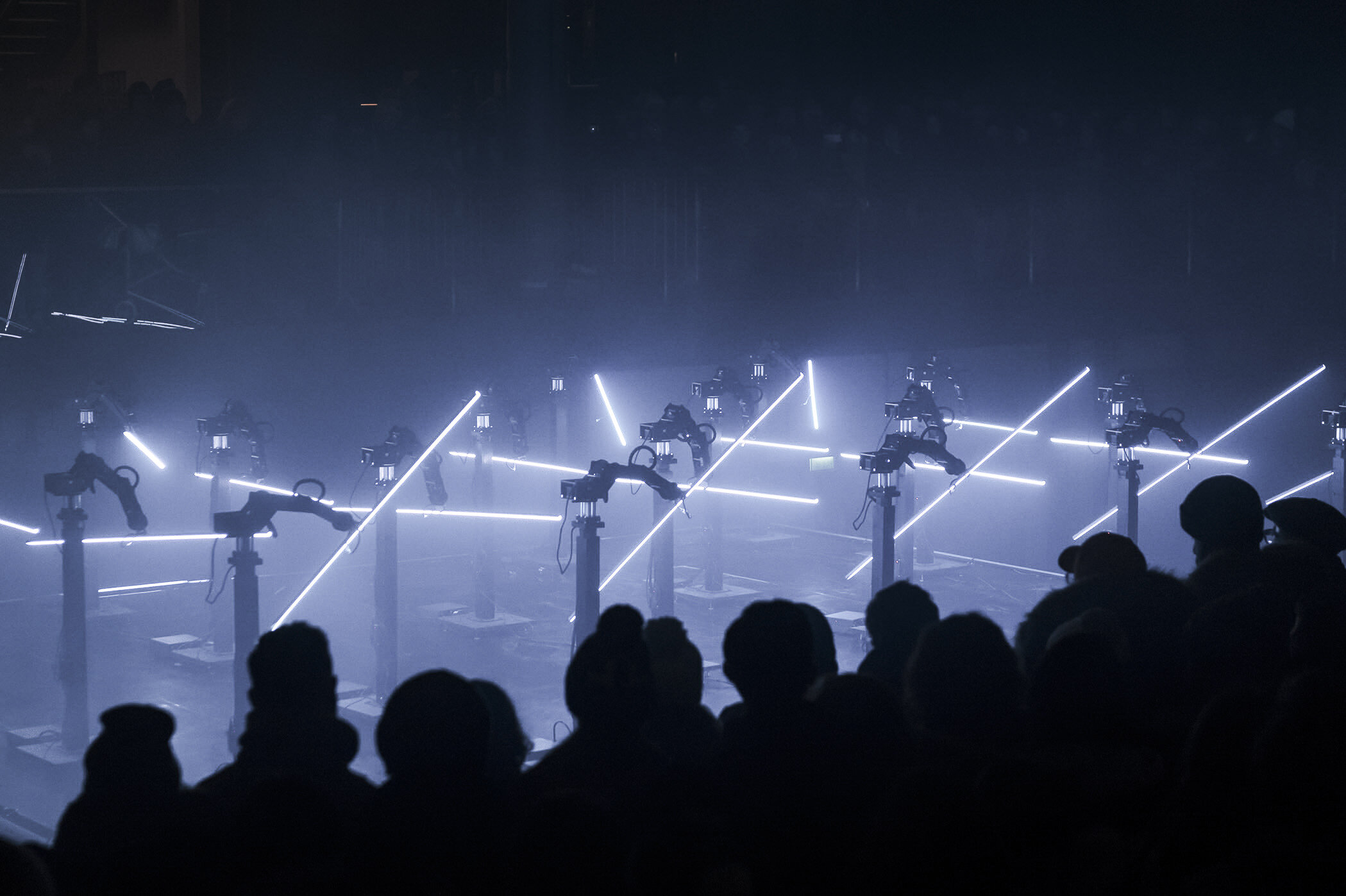
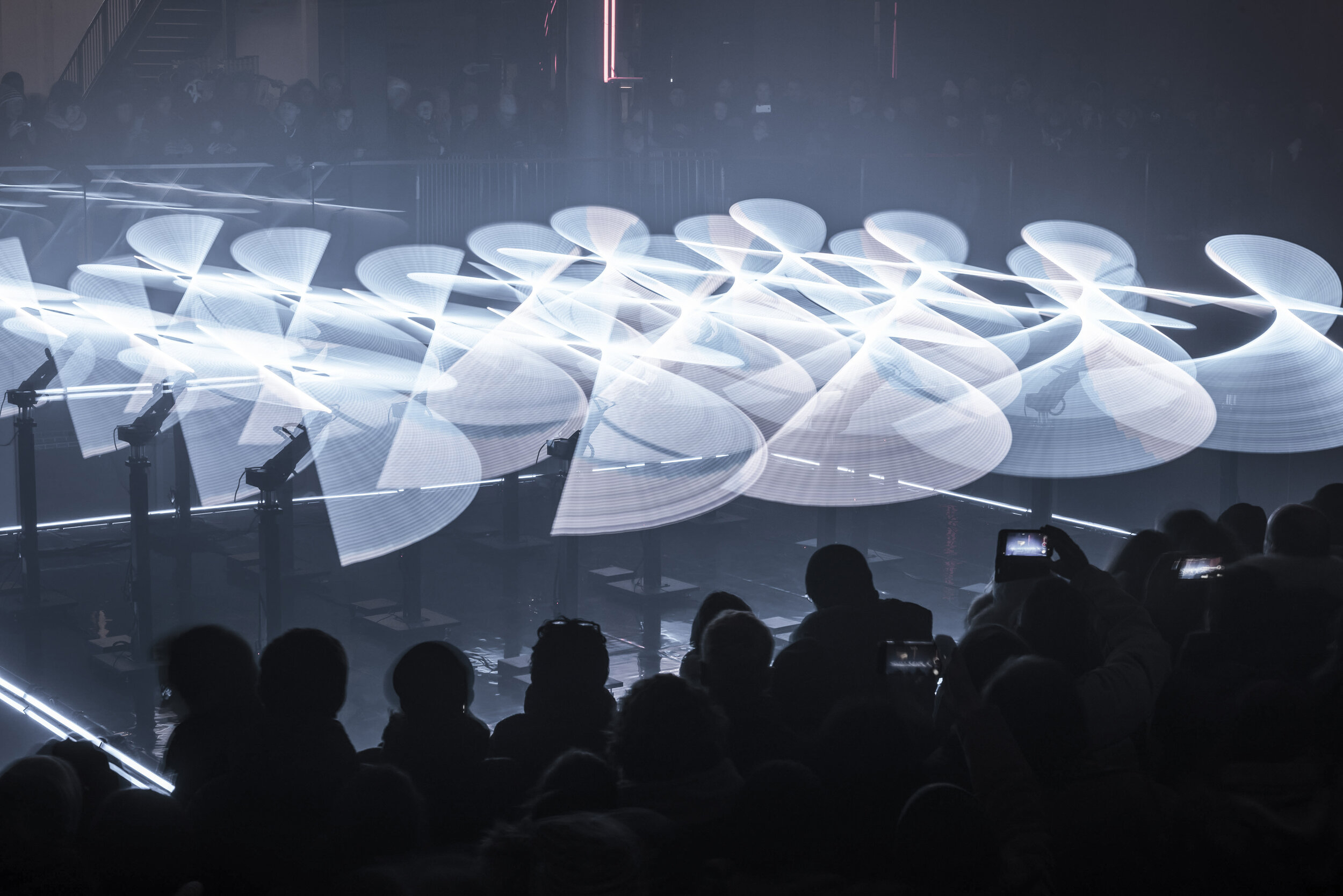
Rods of light twirl and twist, a line of hula hoops loop around each other in a mesmerisingly technical dance, a gallery space is transformed into a kinetic universe of projected images, all to hypnotic soundtracks of electronic and classical music. Collectif Scale is a group of artists and technicians based in Paris who pool their respective knowledge and experience to create cutting-edge augmented installations. Since their beginning, they have “questioned the links between music and the visual, light and architectural design, entertainment and contemporary art, nature and the future, man and machine.” They seek to provide the answers to these questions through their installations. NR Magazine spoke to the collective about their practice.
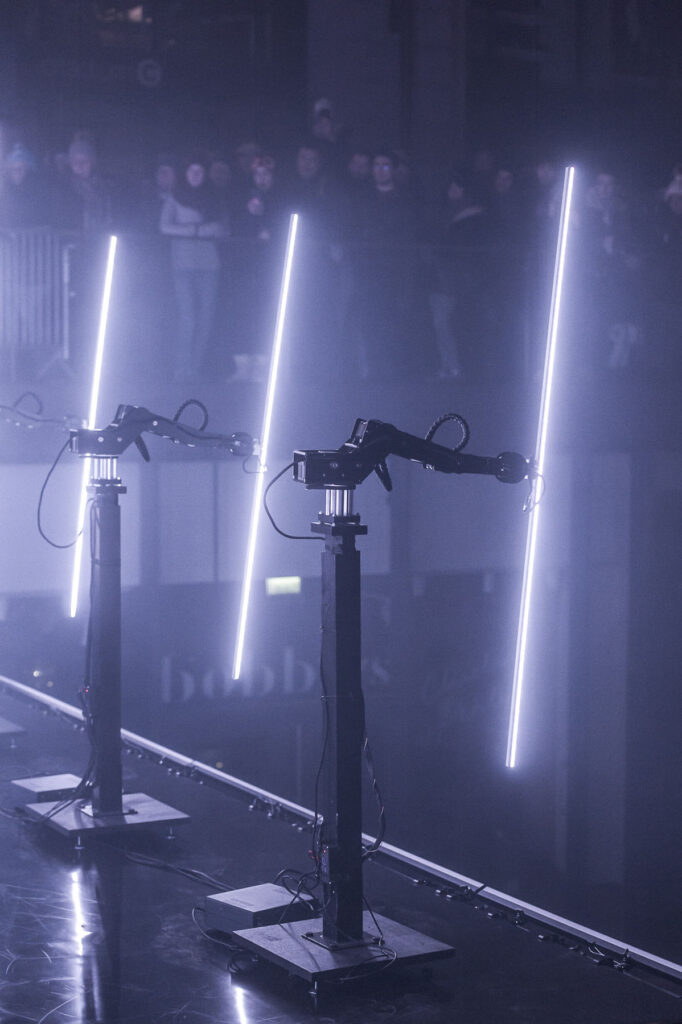
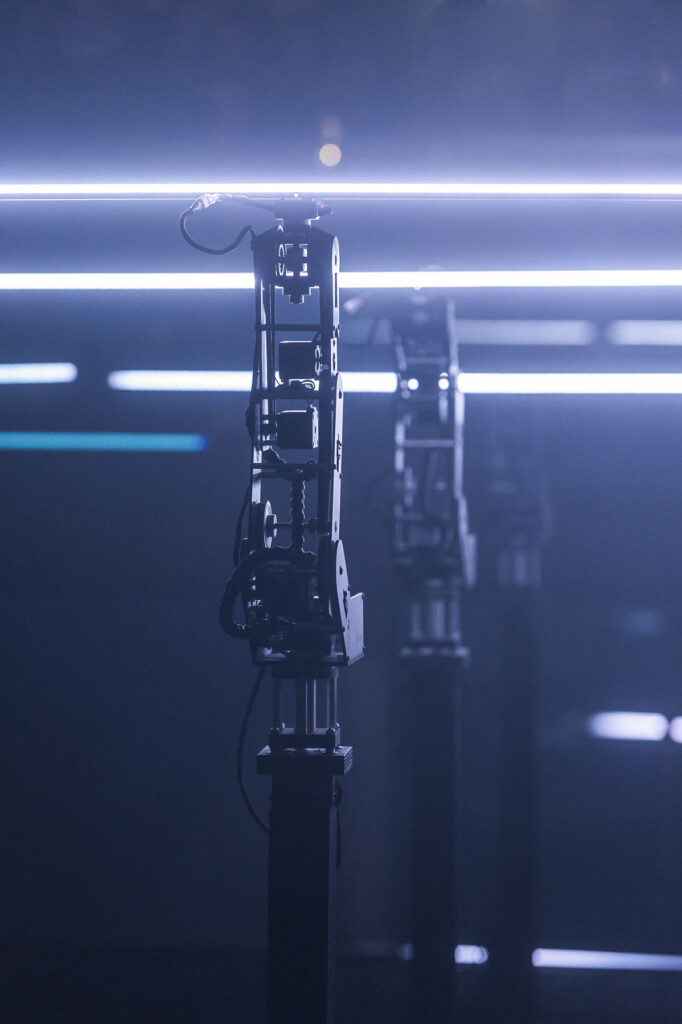

Your CODA installation has been described as ‘the ballets of robots’. How do you feel about this description and do you think it’s accurate.
The starting point of CODA was to work around with the idea of a choreograph of lights and create a piece like a dance show or a ballet, where we would replace the body of dancers with robots and light. But even if many people see in CODA a reference to pop-culture, such as Star Wars or video games, our first idea was to produce a ballet of lights, more than a ballet of robots.
You state the collective does not individually define themselves as artists. What do you define yourself as?
Scale is just the pseudo of a visual designer and this designer happens to be a collective of friends. As we produce different kinds of installations, from scenic scenography for live shows to pieces for art exhibitions, we don’t like to describe ourselves as artists but prefer to consider ourselves as creative technicians or just scenographers.
You have said that the current health crisis has complicated presenting to the public. Would you consider making outdoor installations?
Since the crisis, most of the festivals or productions try to match with some new rules (outdoor exhibition, outdoor festival, etc…) In order to continue showing installations, we have just finished our first outdoor and waterproof installation. We also have decided that our future installations must be outdoor compatible in any case.
Do you draw inspiration from other artists or creatives when conceptualising your work?
Not really. Most of the artists and collectives are connected, like us, to these social networks, so we can see what is produced all around the small world of new media art. When we are looking for a new idea, in general, as much as possible, we try to imagine something that has never been produced. In the end, we can say that the work of the others allow us to create new things because we don’t want to reproduce something existing.
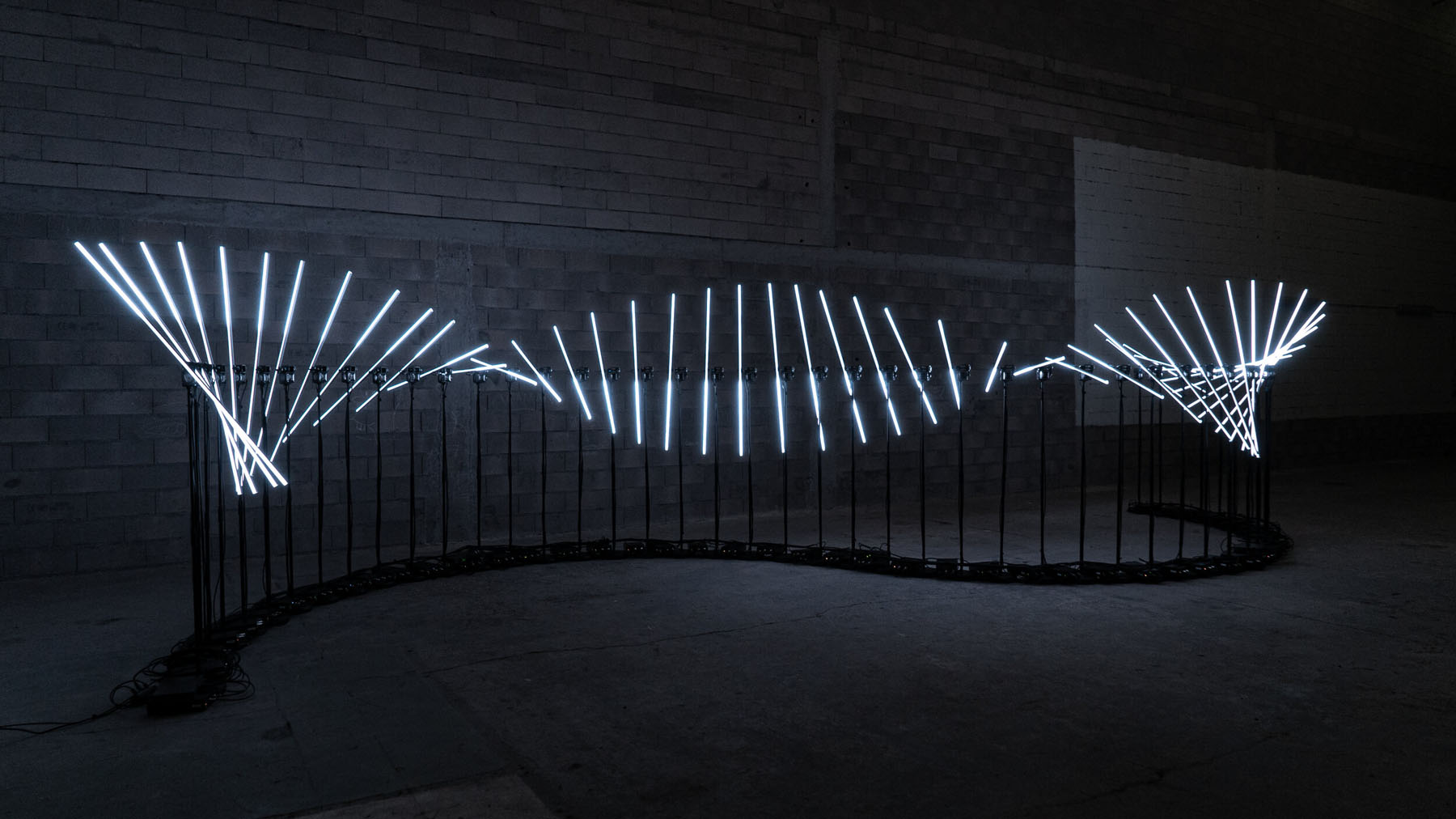
What was the most difficult project you worked on, what are some of the challenges you faced and how did you overcome them?
CODA was probably the most challenging project because it was our first project using motors. After 10 years of using video and LEDs, it was quite difficult to appropriate a new medium. Using motors, bots and mechanics involved a lot of physical constraints (torques, gravity, collisions, kinetic, etc..) We had to work and learn a lot to produce CODA and be able to control robotic arms in real-time and on stage. It reminded us of when we were in school. You open a book, you read, you learn, you try, you experiment, etc…
In the end, CODA is a perfect synthesis of the last 10 years of learning and experimenting. Even if we had the idea 3 years ago, we could never have produced it before, because of our lack of skill and the accessibility to those robotic technologies. We are happy because it really marks the end of a period and the start of something new and very exciting. CODA is maybe our best cocktail of poetry and technology.
You have said it is possible to live with technology but not nature. Are there particular patterns or structures in nature that you reference in your work?
When you’re using robotic arms like CODA, it’s a reference to nature because a robotic arm is a bad copy of the human body’s mechanics. Beyond this idea, we think that nature is, in any case, very inspiring. From an artistic point of view, nature always produces the most beautiful things one can see: a dancer will always be more beautiful than a robot, an eclipse will always be more impressive than a projector. From a technical point of view, physics, mathematics and sciences are there to explain and decode to us how nature works, because nature is always more advanced than human knowledge. We feel it’s natural to draw inspiration from nature more than other artists, and also there’s no problem with copyright.

You mention the group’s love of video games and that there is a level of interactivity between your work and the public. Do you have any plans to create fully interactive, game-like works in the future?
For many years, we’ve talked about the idea to produce an art piece that looks like a game, including levels, gameplay, etc… We still haven’t found the right idea but we’re working on it. More than video games, we are also very inspired by roller coasters and amusement parks. It would be a dream to customise a roller coaster, to make it interactive and for it to become an art installation.

What was the most exciting project you worked on as a collective and why?
In the beginning, each new project seemed more exciting than the previous one haha. It’s only after several months that we realise if that one project was really exciting or not. The most exciting one was probably when La Gaité Lyrique, a famous place for digital art in Paris, asked for us to produce an entire exhibition, our first one, in 2014.
Do you have any advice for young creatives looking to create ‘augmented art’?
We are still young ;). We don’t have the pretense to guide people younger than us, because we can also learn a lot from a new generation, born « connected ».
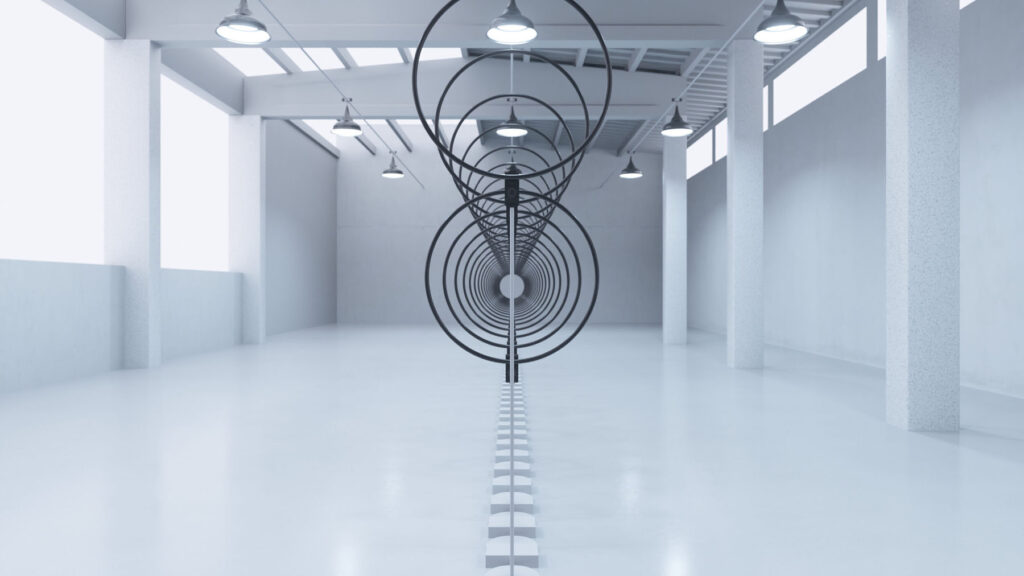

Are you working on any projects at the moment and do you have anything planned for the future?
We have just finished a new installation the last week. The tours, festivals and exhibitions seem to be starting again in few weeks so we will probably be on the road once more, and will try to show something in real life.